The Architect Builder
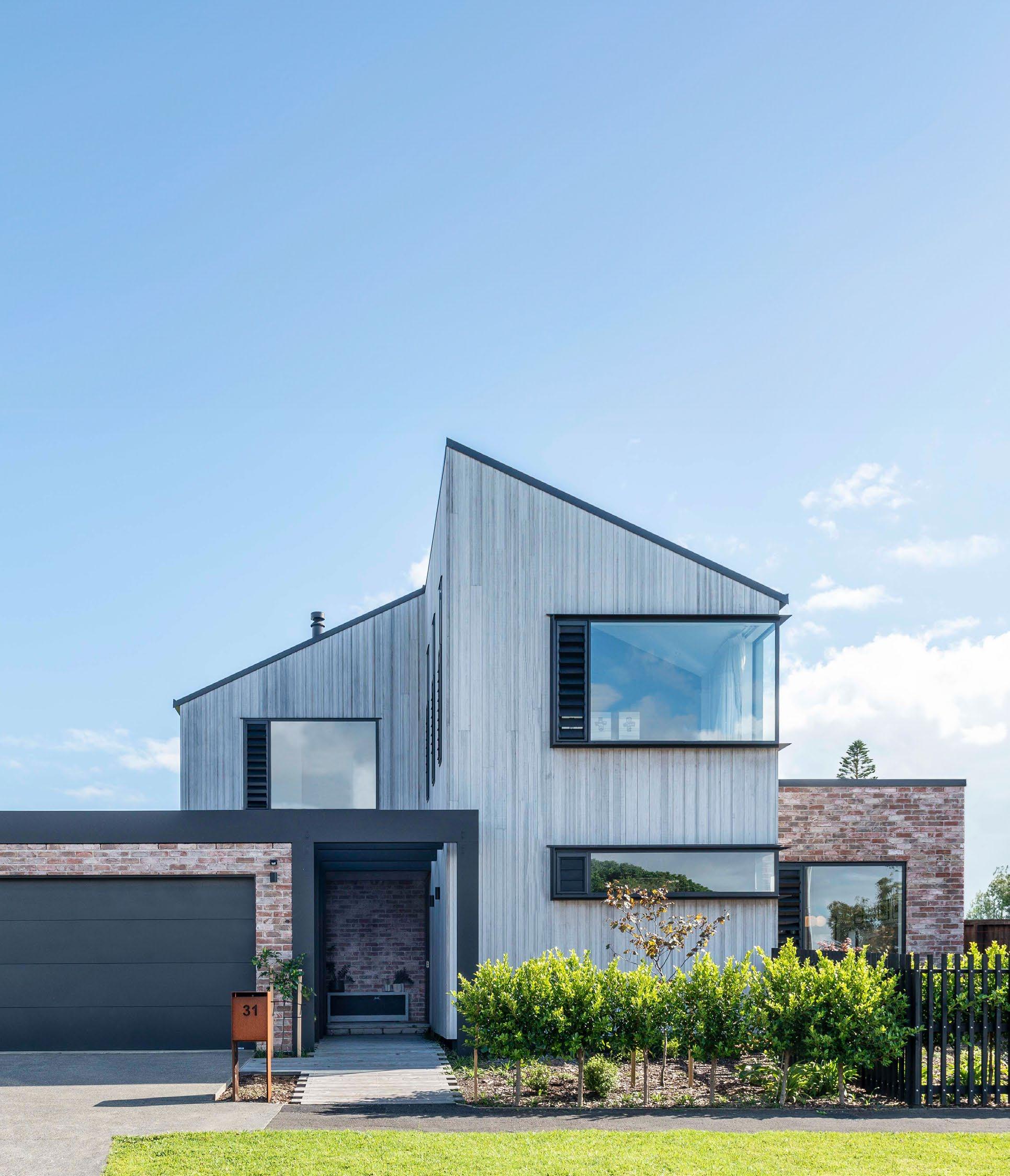
The Relationships Issue
Client Stories
We open the doors on our latest co-creations
Collective by Box ™
Let us introduce you to amazing people we know Modern Modular Artis brings big, bright ideas to smaller spaces

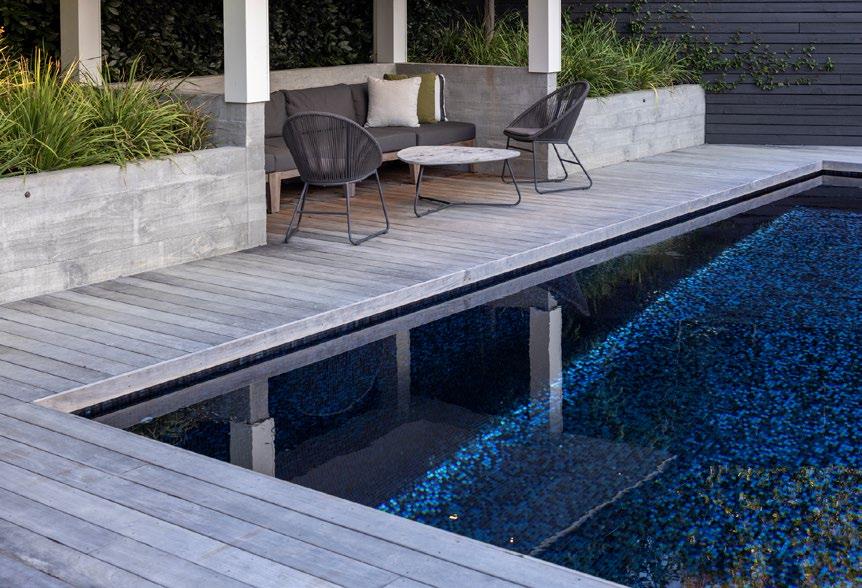
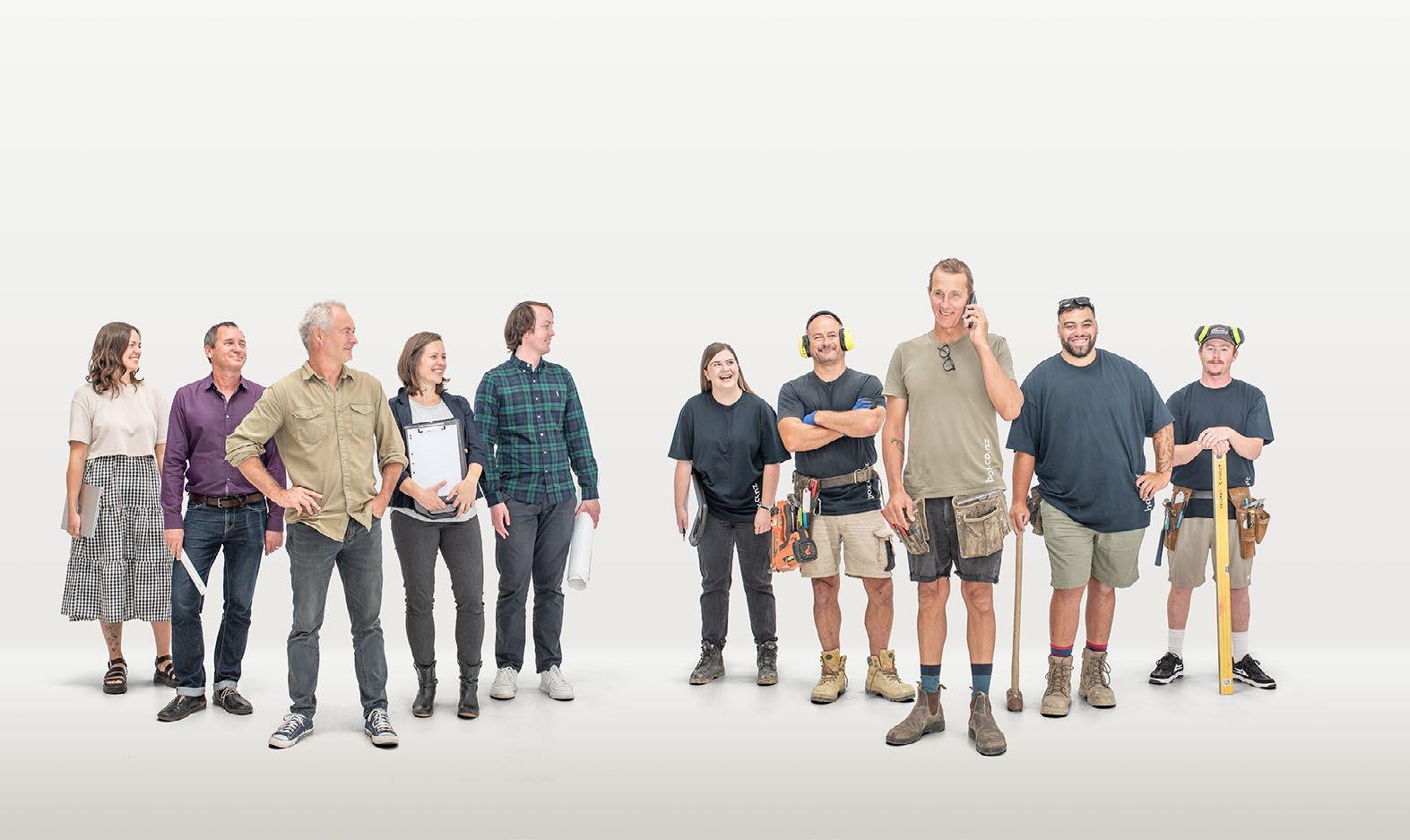
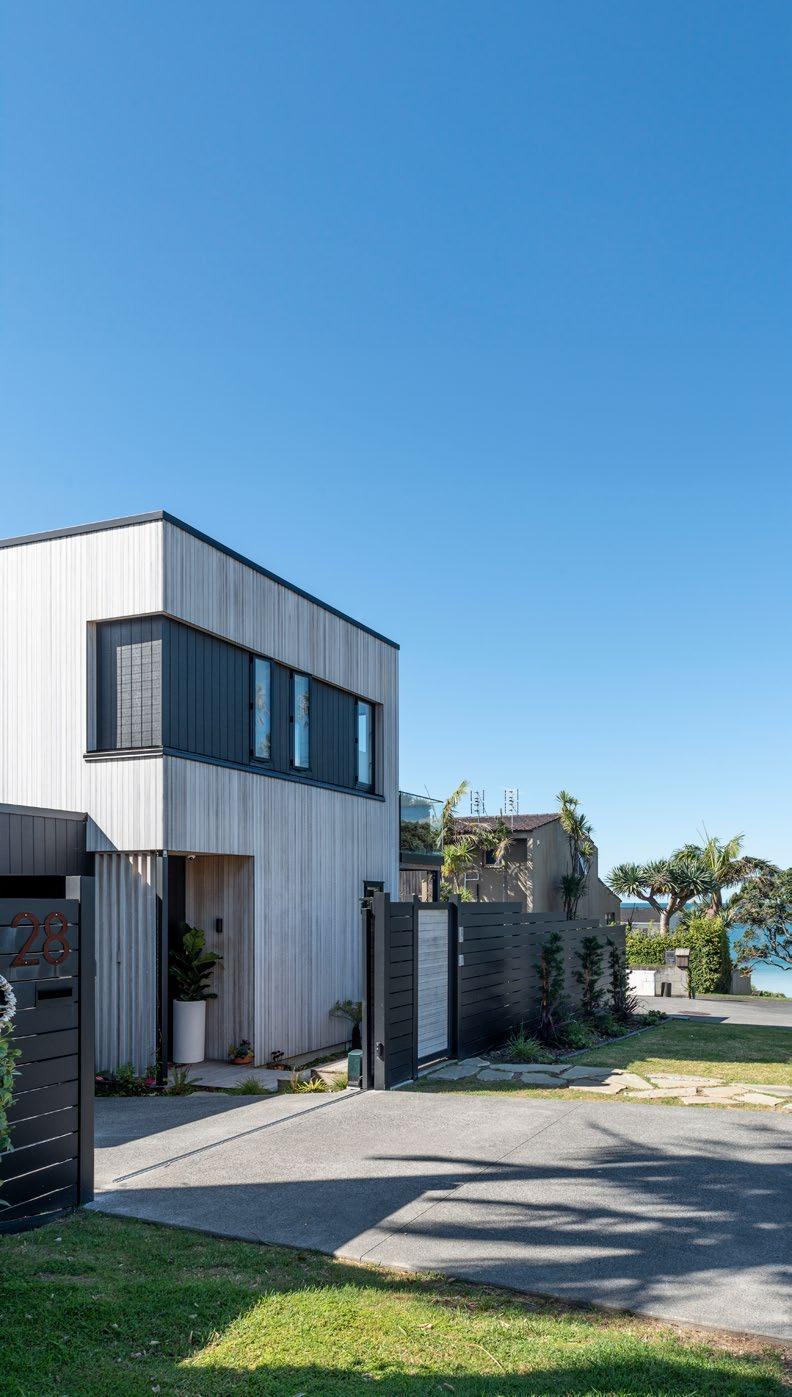
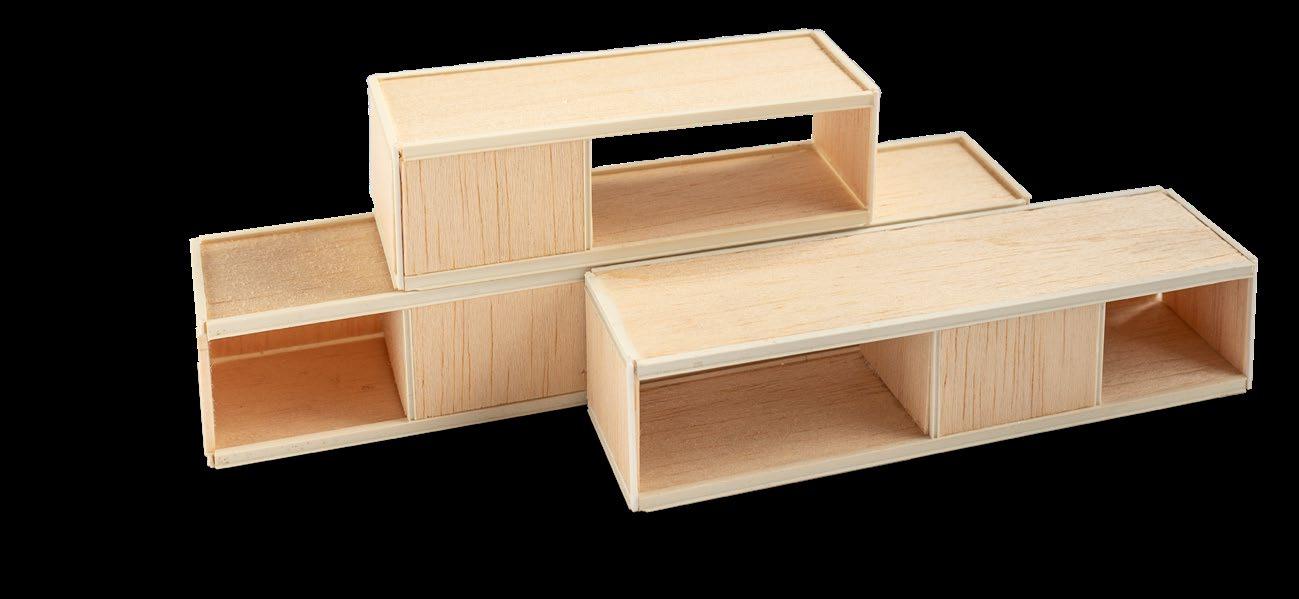


Client Stories
We open the doors on our latest co-creations
Collective by Box ™
Let us introduce you to amazing people we know Modern Modular Artis brings big, bright ideas to smaller spaces





In this issue we aim to give you a glimpse into the essence of our team, the projects we embark on, the stories of our clients, and our unique approach in an increasingly complex industry.

At the core of our work lies a strong emphasis on relationships. These are the connections that bind us together, including suppliers, co-workers, and customers alike. The tone and depth of these relationships often determines the success of a project, rather than the other way around. When all parties involved in the dance of creativity and craftsmanship are aligned and working collaboratively, the success of a project is inevitable.
As the renowned activist and writer, Mary Angelou, once said, "People will forget what you said, people will forget what you did, but people will never forget how you made them feel." These words resonate deeply within us and serve as a powerful mantra to guide our actions and intentions.
We invite you to delve into the pages of this latest edition and explore the stories, insights, and inspirations that exemplify our commitment to nurturing relationships and delivering beautiful homes. Thank you for joining us on this journey, and we hope that the stories within these pages leave you feeling inspired and connected.
Dan Heyworth Co-founder
CONTRIBUTING PHOTOGRAPHERS
Tony Nyberg, Sophie Heyworth, Simon Wilson, Kevin Bills CONTRIBUTING WRITERS
Claire McCall, Dan Heyworth DESIGN DIRECTION
John Kelleher, Lea France
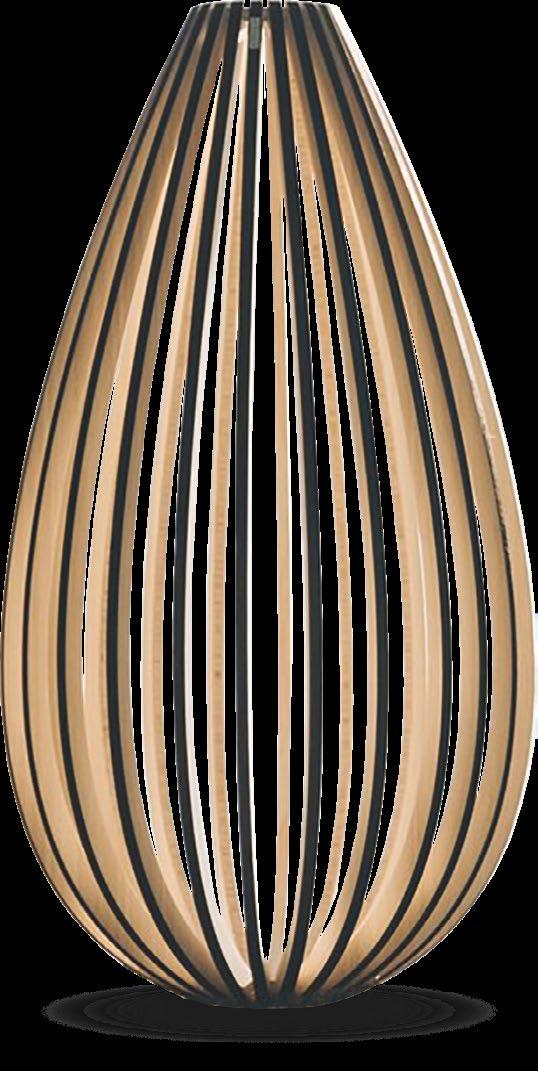
The idea of the ‘Architect Builder ' was described over 30 years ago by a guy named Christopher Alexander, a hugely influential architect and design theorist. He wrote a number of books, most notably A Pattern Language, which details a number of rules of thumb for creating beautiful, human-scale and enduring spaces. It is a must-read for
According to Alexander, the Architect Builder is responsible for both the functions attributed to both an architect and a builder. This includes the detailed design of houses, ensuring that the client-family is truly engaged in the process of design and construction, controlling the process of construction, (which is continuously changed and improved), and taking full responsibility for the end result.
In summary, the Architect Builder is simply a modern equivalent of the traditional master builder.
The word 'architect' originates from the Greek word meaning 'chief builder'. Nowadays, ‘creatives’ (designers) are almost completely disassociated from the ‘creators’ (builders). We see this not just in architecture but in all forms of craft, where designs are made on a computer and the product is manufactured and shipped from the ends of the earth. Similarly, the divergence of design

anyone involved in design or interested in what makes spaces feel ‘right’.
and construction has become more pronounced, with engineers and many other consultants also getting in the way. This has resulted in architects having less understanding and control of how buildings are constructed than ever before. It baffles us how architects can graduate without having ever swung a hammer.
At Box™ , we believe that the divergence of architect and builder roles, and the adversarial environment this creates, is damaging to the quality of buildings and the long-term cost of the home. It is simply not in the best interests of the homeowner. Our work is founded on the key Vitruvian principles of beauty, strength and utility - a great way to define ‘good design’. This requires us to continually balance creative flair with building pragmatism.
Our commitment to the client does not stop the moment we finish the build. We intend to create a service that makes it easy for Box™ owners to know how to maintain and repair our homes
long into the future, and to ask for help if required. Our clients also have access to our family of creators through Collective by Box™ (collectivebybox.co.nz). We have brought together a bunch of incredibly talented craftspeople in order to promote them and their beautiful products, which complement our Box™ homes.
In terms of achieving Alexander’s vision of a truly iterative and creative process during both design and build stages, this will no doubt always be a work in progress given the complex and uncertain financial and legislative environment we find ourselves in when it comes to building anything at all.
What is certain though, is that the Box™ team will warmly welcome you into the family and deliver as best an outcome as possible, as a combined team of designers and builders, now and into the future.
Simply put: Personal Homes, Premium Service.
 Nat Jakich leads our build team.
Nat Jakich leads our build team.
Our unique way of doing things
Our design-build process starts with understanding your project, followed by the Prototype Stage, where we confirm the concept design, construction budget and understand what we need to do to make the project work for you.
How many architects can boast in-house estimating and construction advice from such a talented bunch of people? That’s our secret sauce – all these skills under one roof, working together from the very start. Below are some of these people you may meet as part of the design and build process.
Pre-Start Stage Initiation
1 – 2 Weeks
2 – 3 Months
Stage 2A Detailed
2 – 3 Months
• Introductions
• Understanding you, your life, and your vision
• Concept design and presentation
• Digital modelling and presentation
• Cost estimation and presentation

• Develop specifications & construction methods
• Design iterations
• Finalise design
As one of the founders, Dan ensures that all is going well during the project and that Box™ is meeting your expectations. Any issues, call Dan!
A highly qualified architect, Josh will shepherd the design from concept through to completion and coordinate the team.
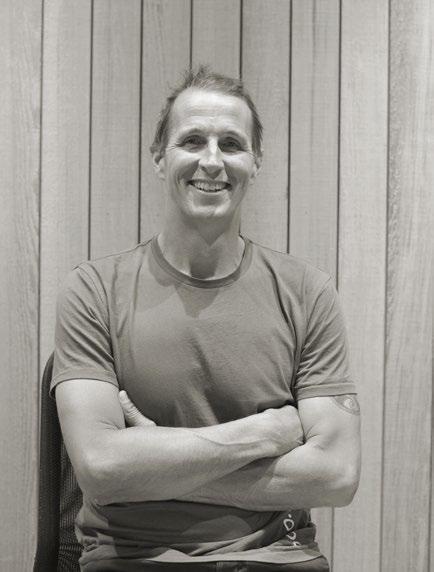


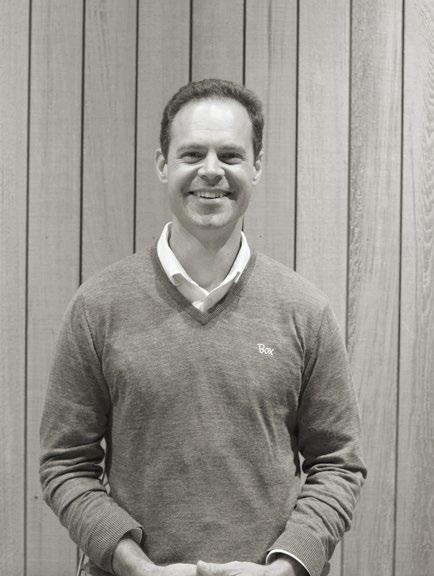
Involved from the very start of the project and at each stage, Nat makes sure that the project tracks to budget.
Nat offers the pragmatic view on each project. His early involvement ensures we’re not getting ahead of ourselves and designing unnecessary cost into the project.
• Lighting design

• Specifications
Sahaj guides you through the interior design process and makes sure that each corner of the house sings with style!
Tommy's responsible for creating document sets for council and builder team, both before and during the construction of the home. The ‘nuts & bolts’ guy.


If you want it done right, you need someone like Amelia to crack the whip and make sure the project runs on rails.

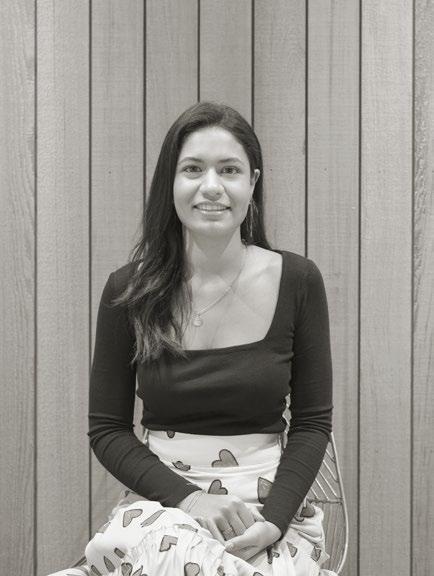
•
•
A true craftsman and one of our most experienced builders, nothing is too much of a problem for Markus and his team.

Joanna transformed her former state house in Westmere into a multigenerational living arrangement with the help of Box™ , providing herself a comfortable pied-à-terre while her daughter and partner have their own home next door.

When you’re a professional contemporary dancer who has an interest in the emerging field of urban design, living in California is as close to heaven as you’re likely to get. Joanna Smith has very fond memories of her time in San Francisco in the 80s to early 90s so when she was impelled to return to New Zealand, she looked for somewhere creative and close to Auckland city to hang her hat. “I was renting in Grey Lynn for a while, but it was too expensive to buy there – so I had to move further out.”
In 1993, she purchased a former state house in Westmere. Built in the depression, it was crafted from native timber and had a clay-tile roof from the brickworks in nearby New Lynn. In those days, this sought-after suburb felt like the boondocks. “You couldn’t walk to the shops and bars on Ponsonby Road. It felt so remote,” Joanna recalls. Still, they were happy times. Her two children grew up here in this compact, solid home right in the middle of a roomy piece of ground.
Through the years, Joanna, who was au fait with smallspace living having spent time in studio flats in London, investigated the options to add an accessory unit to the dwelling that she could one day decamp to. No go. It wasn’t allowed. Then finally, in 2016/2017, the rulebook turned in her favour. Auckland Council began to allow more density within the mixed housing suburban zone and a work colleague suggested approaching Box™ for advice on what she could do. At the time, Box™ was running ‘sprint’ sessions – a half-day workshop to explore the feasibility of developing a site. Within no time, the team demonstrated there was a better option than just remodelling and adding a garage studio. “Around that time, my daughter, Sophie, and her partner, Adam, were looking to settle down and start a family,” she says. “I started to wonder if I could downsize and use my equity to help them get into the market.” They put their heads together and came up with a plan for multi-generational co-existence. >
When Box™ was commissioned for the job, the appeal was their design-to-build product. “They managed the process end to end which meant we had certainty about costs and time all the way through - particularly valuable for a multi-household client,” says Joanna. One of the first aspects Box™ tackled was the stormwater connection approval process, a necessity because, effectively, Joanna was sub-dividing her land into three sections.
The pre-construction process took a year but, in the meantime, the design could be fine-tuned. Setting aside a third of the land for future development (what Joanna calls her ‘retirement plan’), two separate two-level dwellings were planned. Their exterior palettes, although different, talk to each other with the use of darkstained board-and-batten cladding combined with vertical cedar weatherboard to break up the forms. “I didn’t want the look to be too stark and modern,” says Joanna. They added some battened eyebrows above the windows for shade and painted the front doors red in homage to the colour of the state house door.
Streetside on the long, rectangular section, is Joanna’s pied à terre planned so the top floor can operate as its own selfcontained unit. “I wanted an upstairs studio to take advantage of the view to the water and the Waitakeres,” explains Joanna. “And I didn’t mind having no garden.” Hooked on the idea of living smaller, without the clutter of lots of ‘stuff’, she was instrumental in the design of this 65 square-metre space. The kitchen is minimal with all the pots and pans in one drawer, a tiny pantry that incorporates the smallest microwave she could find and just a two-burner hob. The dining zone is augmented by a built-in bench seat which can double as somewhere to sleep, and the living room is connected by floor-to-ceiling sliding doors to a north-west facing deck ideal for cocktails on summer evenings. “With the latest round of plan changes, I want to build a pergola
so it gives me more shade.” There’s also a separate bedroom and a bathroom plus an extra room above the stairwell that acts as a closet and can be used for storage or as an office. “I thought I might have a laptop in there but when the pandemic came along, and we all had to work from home so much, I sacrificed a portion of the bench seat in the dining area and installed a desk instead,” says Joanna. Pale, cork floors throughout give the spaces a relaxed, casual feel and a 1950s dining table and display cabinet are in keeping with the Scandi-modern mood.
Downstairs, the house, finished in winter 2019, has already accommodated several guests. It’s a layout that strikes a balance between companionship and privacy. There’s a bathroom they can use and a kitchenette should they wake early and not want to disturb their host. Two single garages separate the dwellings and Sophie and Adam are now well ensconced in their first home next door, along with Joanna’s two young grandchildren. The kitchen may be bigger here, with an L-shaped bench to accommodate two keen cooks, but the materials - plywood cabinetry and stainless tops - are the same. A staircase to the bedroom level features rimu rescued from the joists of the original state house that has been fashioned into stair treads along with a cedar-batten balustrade that is a warm, sculptural counterpoint to the bulletproof concrete floors.

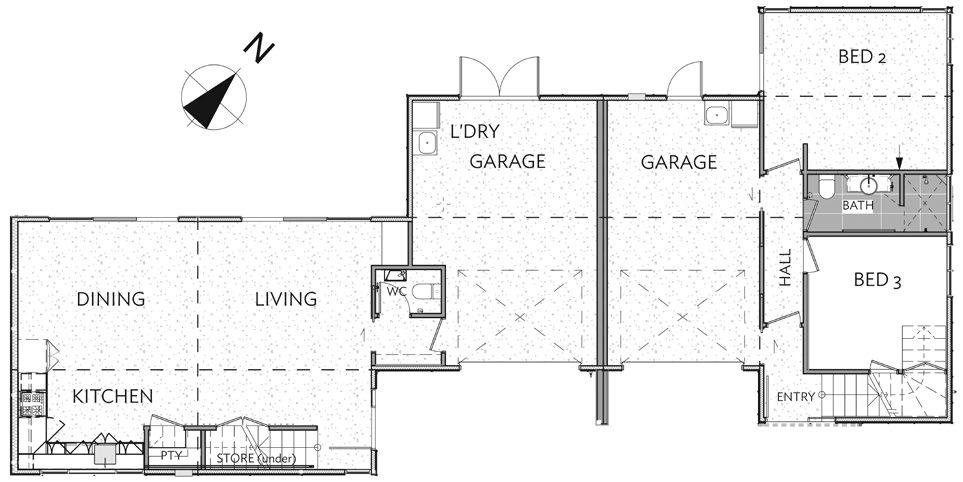

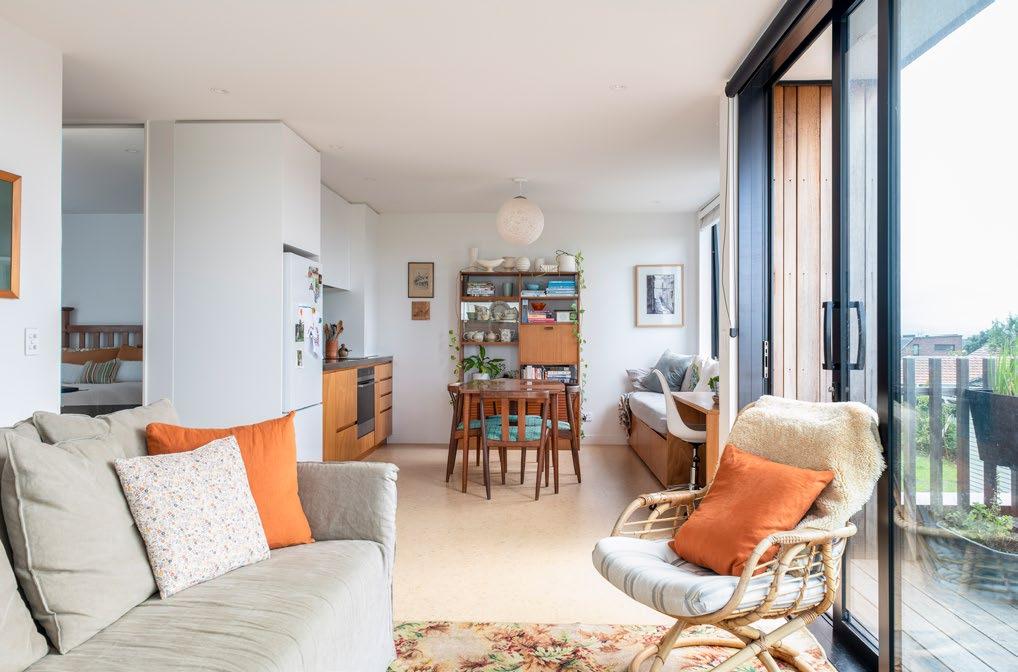
“ They managed the process end to end which meant we had certainty about costs and time all the way through - particularly valuable for a multi-household client”

The garden is somewhat occupied by a climbing frame but, within the small footprint, there’s also a lawn, tropical plantings, a service court and a vegetable patch, as well as a deck, tucked in behind a wall, that makes it private from next door (although from her balcony Joanna can still wave to the grandchildren if they’re playing swingball). A huge trampoline that the children insisted on has been relegated to the overgrown patch of land where sometime in the future a third house will stand.




Naturally, living right next door to your daughter and son-inlaw has its upsides but the generations were careful to lay out a rock-solid financial and social agreement when they signed up to the deal. “We spent a lot of time with lawyers setting up trusts and stipulating who owes what,” explains Joanna. At first the family imagined they would live as careful neighbours, not wanting to intrude on each other’s space and time. But when the lockdown happened and they were all in the same ‘bubble’, it changed things. They relied on each other and drew a lot closer, especially when baby number two arrived. They shared chores, cars, landscaping and planting, and meals. Now, two to three times a week, Joanna will pop over for an early dinner and to help with the grandchildren while their parents have some time out. The secret is to give and take (but never for granted). “I feel pleased that I was able to contribute, along with Adam’s parents, to getting a young family into their own home,” says Joanna. “This is not just a business deal; we have all benefited. We are a kāinga – our own little village.”
Anna and Tom built their dream home in Pukekohe East with the help of Box™ , creating a low-profile, split-level house that embraces nature and accommodates their family of five.

Good friends are hard to find but Anna and Tom have one who is right up there in the mates’ stakes. Not only did she put them in contact with the owners of their first house in Auckland (a villa they bought through private sale) but when she knew they were looking to build, she also showed them a brochure picked up in a Bunnings store with a Box™ house adorning the cover. “Naera is a close friend who I went to uni with,” says Anna. “It’s funny; she’s like my agent.”
So began the couple’s building journey - an adventure that would take them from the suburban streets of Onehunga to the countryside in Pukekohe East. “We both grew up rurally in the
South Island on small farms so, when we had kids, we wanted a bit more space,” explains Anna.
Tom is a rural bank manager and Anna an intensive care doctor who works irregular hours and cannot leave the hospital to attend to child-related requirements at the drop of a hat, so the couple decided to look for land closer to Tom’s office. They knew the villa needed “100 things done to it” to be truly family friendly and, after a childhood in the country, it felt foreign to be able to reach out and touch the neighbour’s fence. A decent primary school was top of the list and, again, someone Anna knew came up trumps. A colleague was selling a hectare in Paerata with two boundaries boasting established native planting that lent the land complete privacy. The sloping site culminated in a mini wetland and a bridge across a stream. It was a pretty slice of paradise. >
ABOVE As well as providing for large interior heights on a relatively small footprint, the high roofline also provides protection for the well-enjoyed swimming pool and deck areas. RIGHT The stepped undulation of the land provides a perfect canvas for the design advantages of a split-level home.
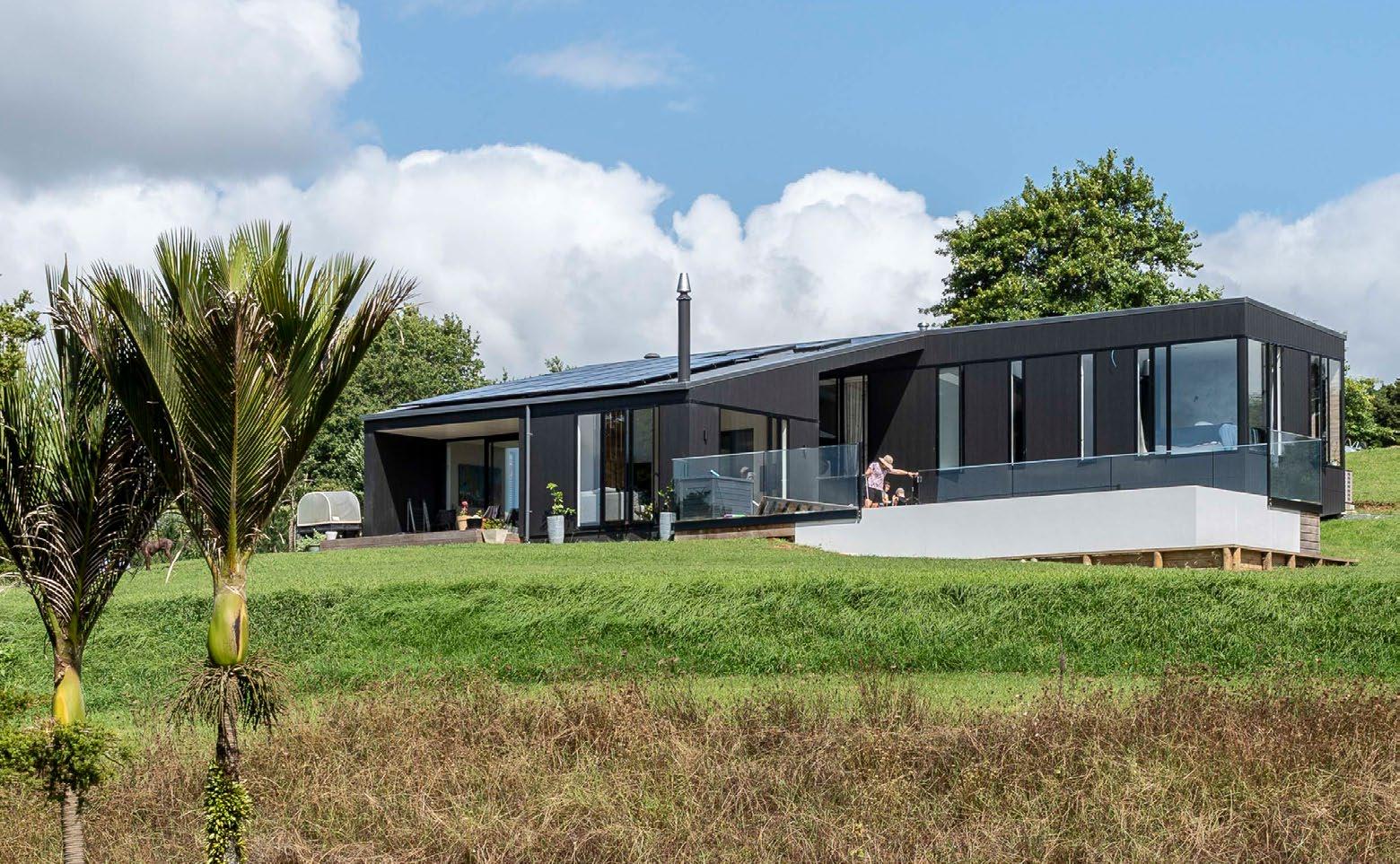
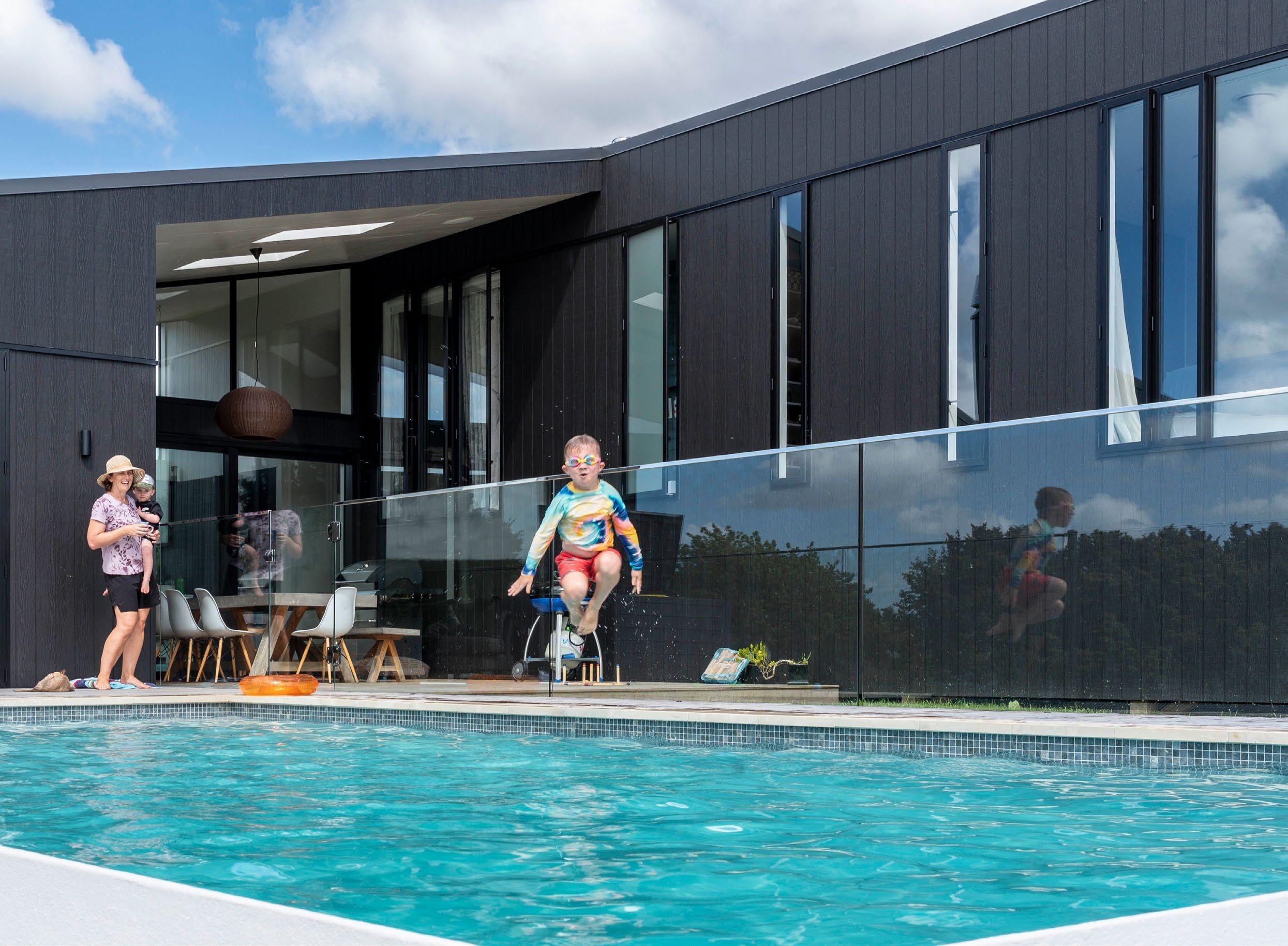
Their dream was to build something bespoke but they also realised they couldn’t afford a full-blown design from an architect.
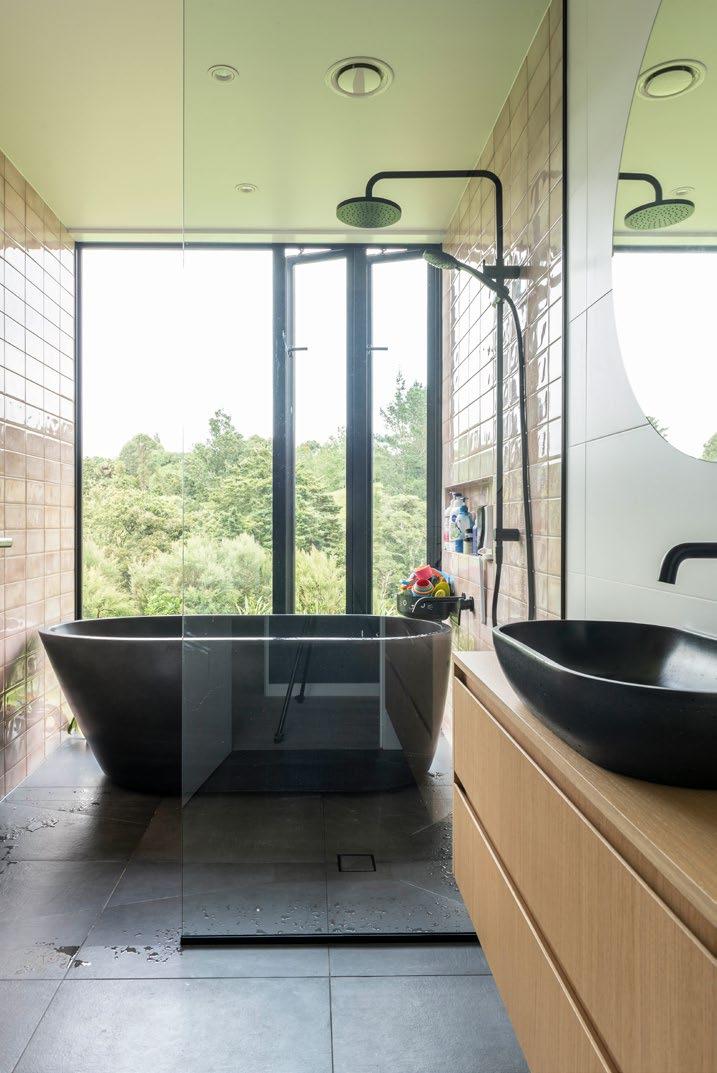
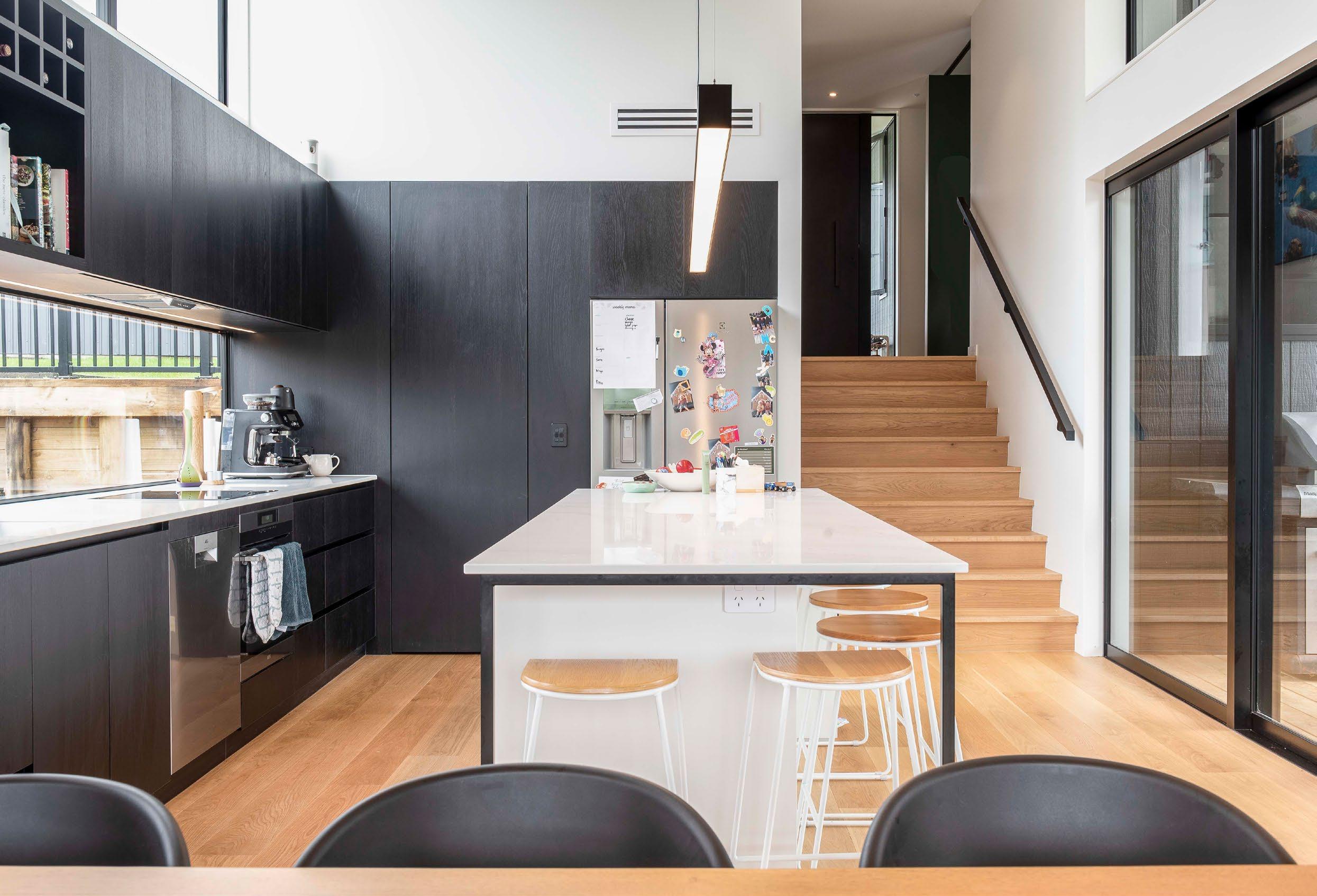
Box™ occupies the middle ground using a combined design and building expertise combined with years of experience to personalise designs.
 TOP The split-level design allows for a large spacious kitchen and benchtop seating area. ABOVE LEFT Floor to ceiling windows provide maximum light in the bathroom, while elevation allows privacy. ABOVE RIGHT Distinctive 'water colour' graphics create a sense of space and calm in the powder room. OPPOSITE Large sliders deliver light to the dining area, and a slat divider wall links the area to the living space.
TOP The split-level design allows for a large spacious kitchen and benchtop seating area. ABOVE LEFT Floor to ceiling windows provide maximum light in the bathroom, while elevation allows privacy. ABOVE RIGHT Distinctive 'water colour' graphics create a sense of space and calm in the powder room. OPPOSITE Large sliders deliver light to the dining area, and a slat divider wall links the area to the living space.
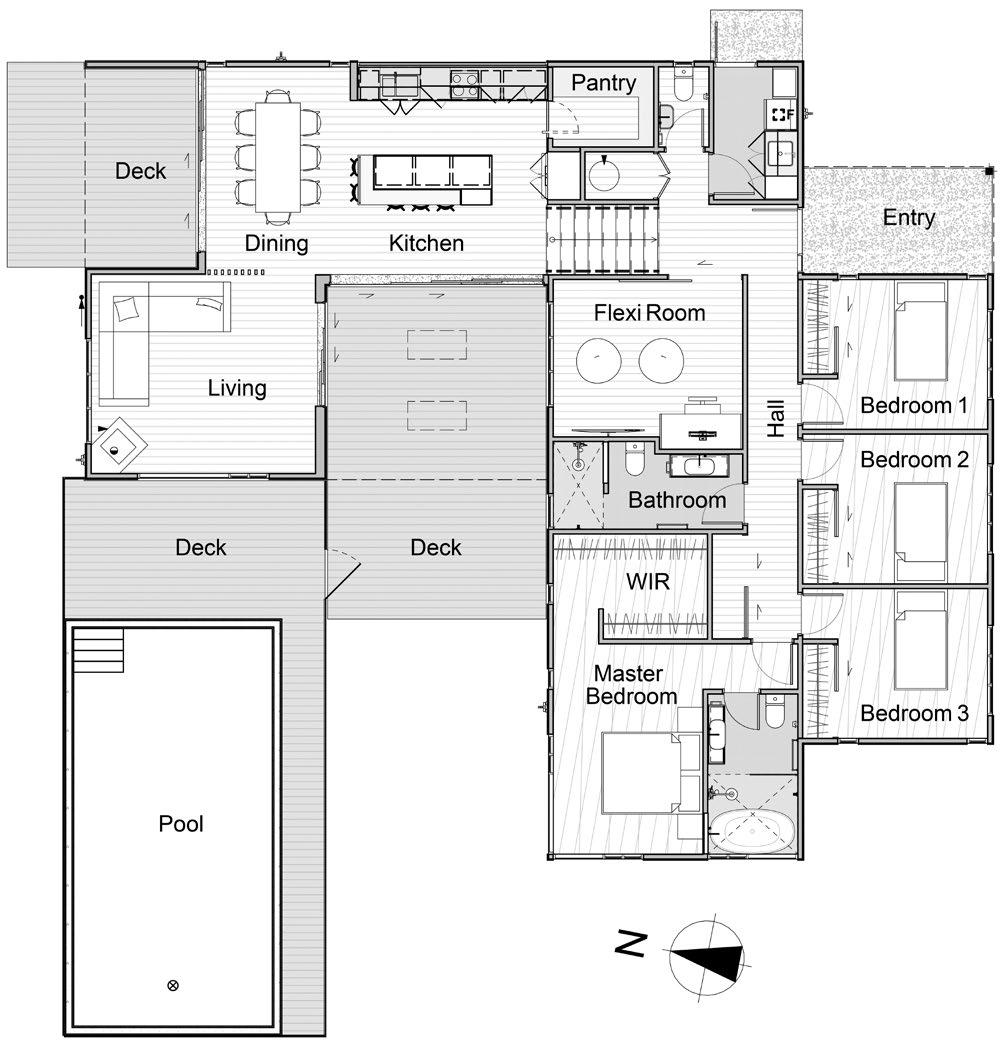
Their dream was to build something bespoke but they also realised they couldn’t afford a full-blown design from an architect. Box™ occupies the middle ground using a combined design and building expertise combined with years of experience to personalise designs. As equal part architect, equal part builder, it made sense for the busy couple. “When we met them in the office, there was a lot that was appealing as a company,” recalls Anna. They particularly liked that Box™ was on the same page re house size. “We didn’t like the feel of a 300-400-square metre house, and the thought of cleaning it and, unlike other design-and-build companies, they were big on using good design within a small footprint and sustainable material choices.”
The day before Anna had their third son, Leo, the pair signed up for the project. This first summer in residence, little Leo (2) and his big brothers Harry (5) and Jack (6), are having the time of their lives splashing around in the pool, kicking a ball on the lawn and exploring the immediate landscape with their parents. The dwelling, at 170 square metres, is ample for the family of five. The low-profile home is low-key on arrival. “It looks like a very boring little house,” explains Anna. It steps down the hillside in a splitlevel programme that incorporates four bedrooms, two living areas and a ‘mud room’ which facilitates a transition between outdoors and in. “With all these boy children it does get a bit dirty,” laughs Anna. On entry, its true character is revealed. Anticipation is part of the arrival as stairs lead immediately down to the open-plan living zone where the ceiling rakes up to an incredible 4.2 metres and the glazing follows suit to allow the greenery surrounding the house hero status. The U-shaped form of the home embraces a covered central deck which faces west but also speaks to a north-facing one that leads out from the dining room and allows the second living room to connect directly with the pool.
Matt-black Weathertex cladding allows the angular form to recede into the bush. “We wanted to connect with

nature, and to use as many natural materials as possible,” says Anna. This commitment did mean some hard choices. When it came to the kitchen bench, Anna came to a philosophical impasse. “Clearly having natural stone in a house with three children, paired with not the biggest budget in the world, wasn’t going to work.” Despite the fact it went against her initial brief, the engineered stone they ended up with is functional and aesthetically pleasing.
Enjoying a close relationship with design lead Laura McLeod and quantity surveyor Stephanie Collingwood made the process so much easier. “It also helped that Tom doesn’t have strong views about interiors,” laughs Anna. With her role at the hospital and three young children, time was of the essence when making decisions. She ripped photographs out of magazines, went to many show homes and did a little research on the internet. “Truth is, I have a no-regrets policy,” she says. When it came to the myriad decisions re flooring, tapware, tiling, vanities – the list goes on – she chose and then moved on. “Sometimes having limited time can be beneficial.” One aspect she did relish was selecting the wall coverings. “I would have put wallpaper in every room if I could afford it,” says Anna. Instead, an Emma Hayes paper is cloud-like in the main bedroom behind the bed, a gentle juxtaposition against robust black floor-to-ceiling joinery. And guests in the powder room get to experience Hayes’ fluid graphics with dreamy wallpaper in tones of green and black. Colour kisses the bedrooms too with navy in the main suite, forest green in the flexi room which doubles as an office and media room, and a pinky peach tone in the spare bedroom. “Mum lives with us two days of the week to look after children so she gets to experience that room the most,” says Anna.
With room enough to enjoy the boisterous lifestyle that often comes with young children, there are also spaces to hide and relax. When it’s not that easy to pop to the corner shop, a walk-in pantry keeps the larder well-stocked and, after the kids are in tucked up in bed, the en suite bathroom with its grandstand view of a manuka forest underplanted with flax beckons. “It’s one of my favourite spaces and I thought bathing would be a nightly ritual,” says Anna. Alas, mounds of washing need folding so it hasn’t quite worked out that way. Still, there’s time. That’s the beauty of a forever home: it moulds around the dynamics of a changing lifestyle. The bath with a view will always be waiting.
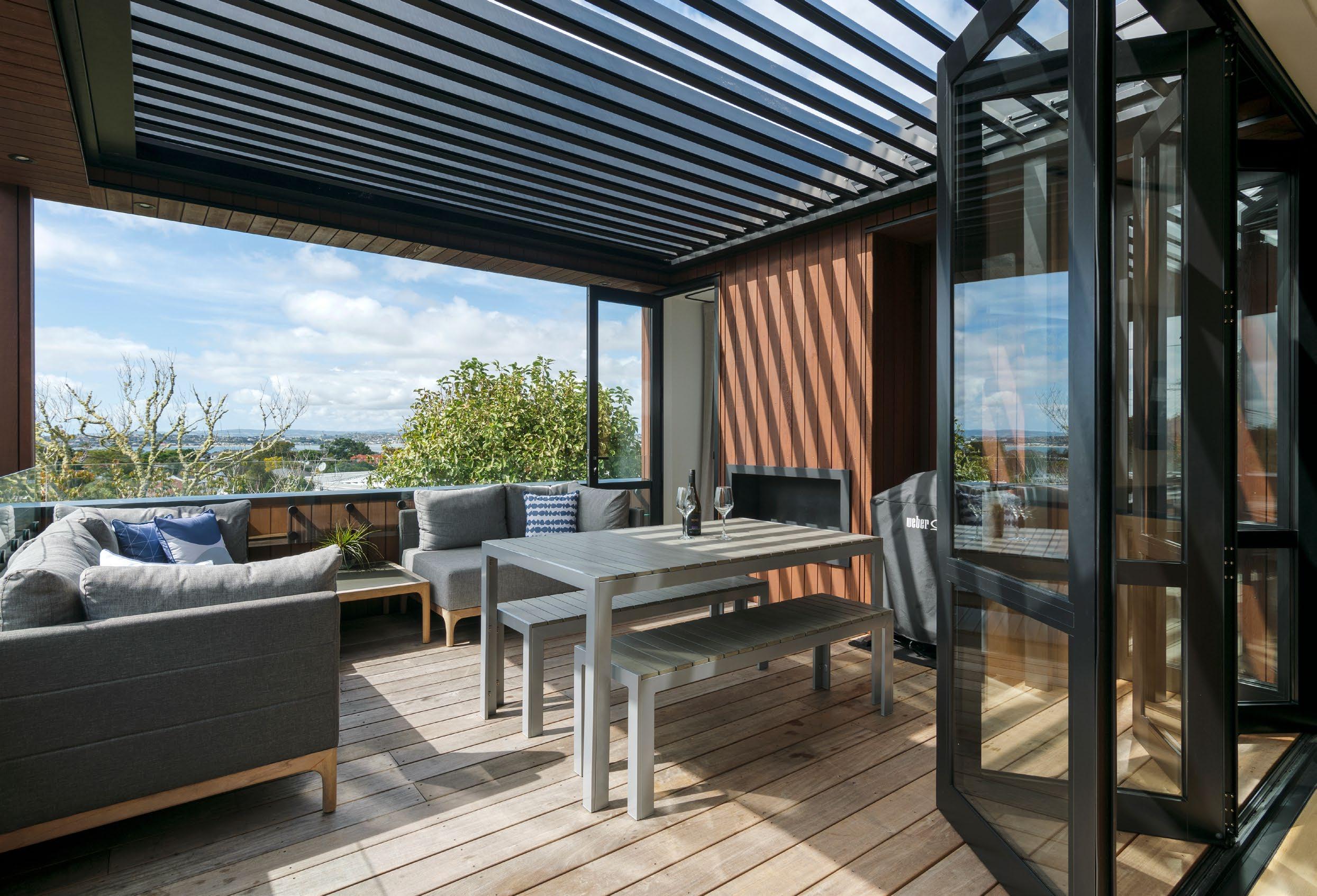
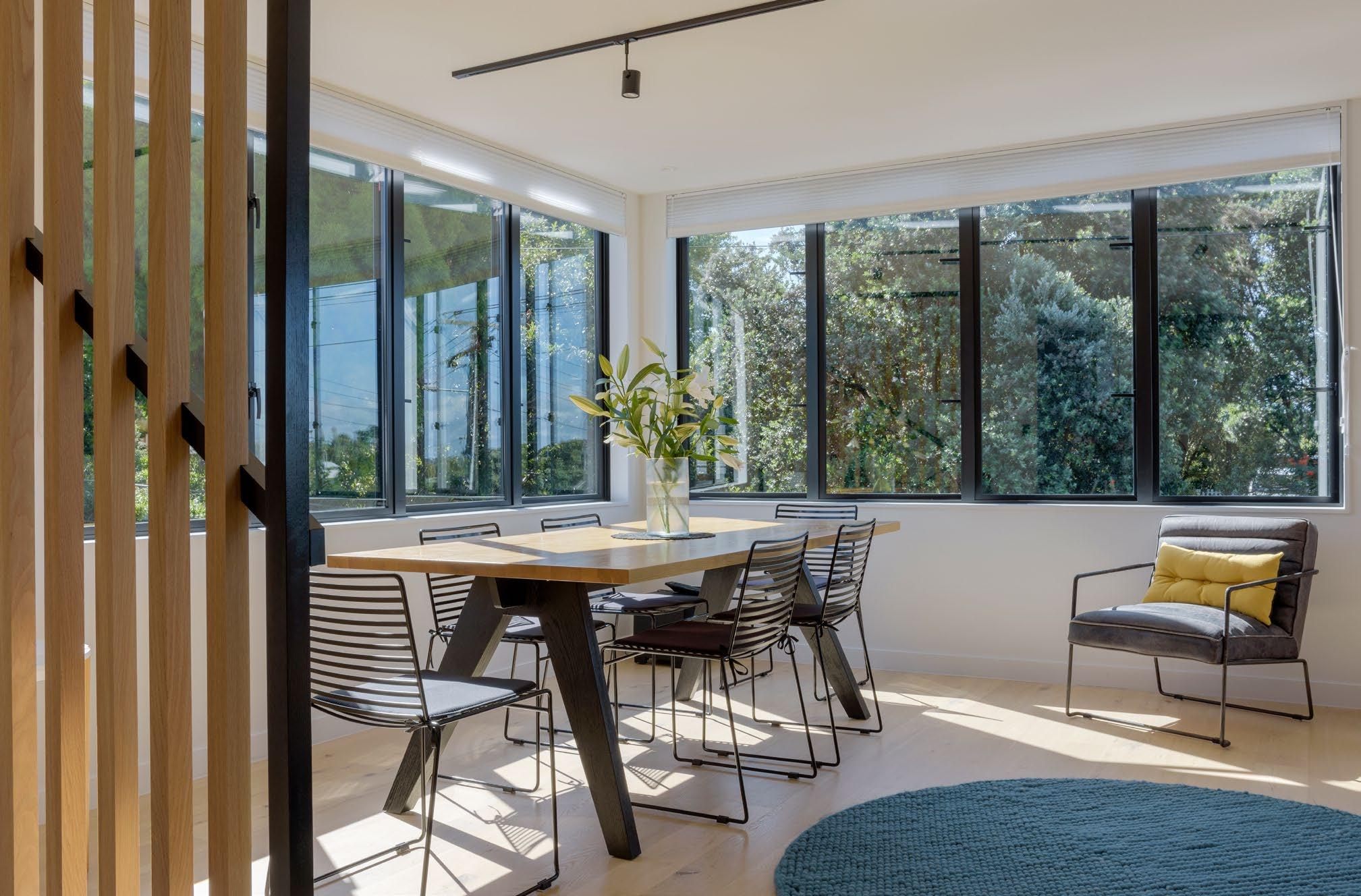

Tommy:
"Tell us a bit about the relationship, how long have you worked with the Box™ team?
Jason:
"The DWS team has been the supplier to Box™ since the early days, we have a great relationship and love working together on projects. The projects have been in some stunning locations and showcase the best of Box™
Tell us a bit about your business and what makes it amazing?
At DWS we work as a team with our core values to make us amazing:
Remarkable: Every Client. Every Project. Be remarkable.
Confidence: Safety & Trust, always.
Integrity: Be honest. Take ownership.
Recognition: Seek, celebrate & reward success.
Teamwork: Together, we achieve excellence.
What current trends are you seeing among clients?
Obviously thermal performance is a big part of any project, however we believe the APL Altherm ThermalHEART+ range has the innovation to take us to the next level. The joinery combined with high
performance glass will make your home more comfortable for the future, so don’t be afraid to look at the options.
Do you have any suppliers who make your life easy or want to give a shout out to?
APL Window Systems, who supply us with Altherm Window Systems have been our partner for many years, they also remain market leaders and this makes our life as a fabricator easier!
Any tips to future clients to make their builds easier (and cheaper!)
When designing your own house, you need to work out how you want to live in the house, what’s important to you and your family. Make the most of your location, elevation, or views. Use the professionals from different trades for advice and guidance but remember it still needs to work for you!
If you were designing a house for yourself, what type / style of house would it be?"
My ideal house has great indoor - outdoor flow for entertaining and is designed for the sun and views."
To learn more please visit: doorwindowsystems.co.nz




Chris and Leah build a contemporary beachside home in Takapuna with a familyfriendly layout, mid-century inspired interiors, and colorful decorative details.
Rain was lashing down in sheets and the ocean, metres from the front door, was a washing machine. It was the precursor to Auckland‘s wettest day in recorded history, yet Chris and Leah’s Takapuna home was dry and comfortable.
The couple had bought the land with a little old bach on it – one of the first houses in this area - as a deceased estate. Chris, who is English, wanted to live within walking distance of the beach and this location was perfect. Even so, when they won the auction, it was a bit of a surprise.
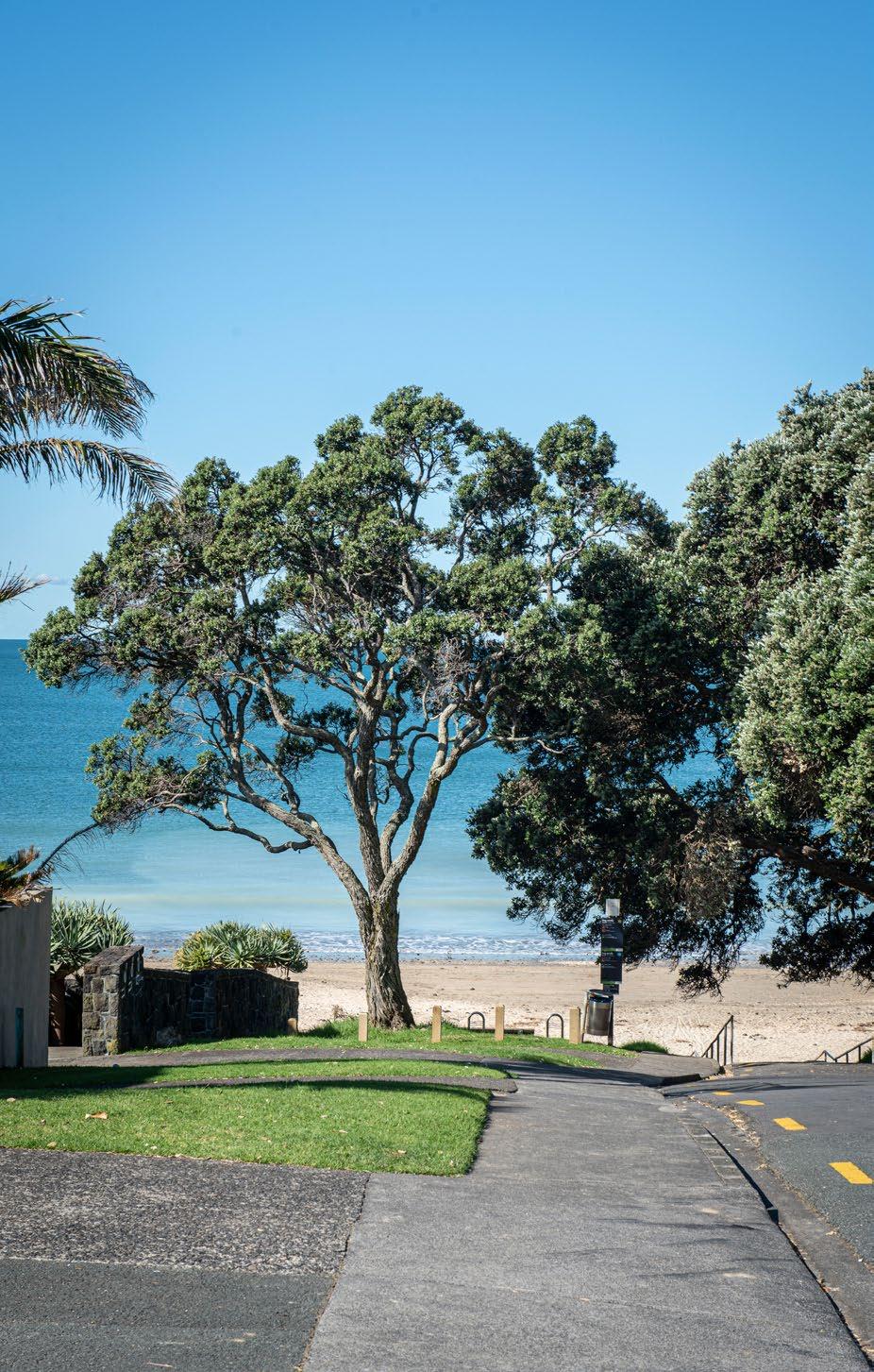
That was in 2018. Initially they envisioned that they would renovate the leaky, mouldy dwelling, but when the estimates came in that proved untenable. “We’d have to take down so much of the original house that it wasn’t worth it,” explains Leah. Building new was a better way forward.
Getting to the stage of breaking ground proved the hardest part. It took a while for the family to receive the necessary consents. Three years in fact.
The easy part was choosing Box™ as their design-andbuild partner. “We’d seen one of their open homes, liked their style and always had them in the back of our mind,” says Leah.

That signature aesthetic is immediately recognisable here. From the street, the two-level house has a contemporary rectangular form which stretches back to occupy the narrow infill site. Vertical Abodo cladding in pale timber is offset by window reveals and a garage in dark-stained Weathertex. >
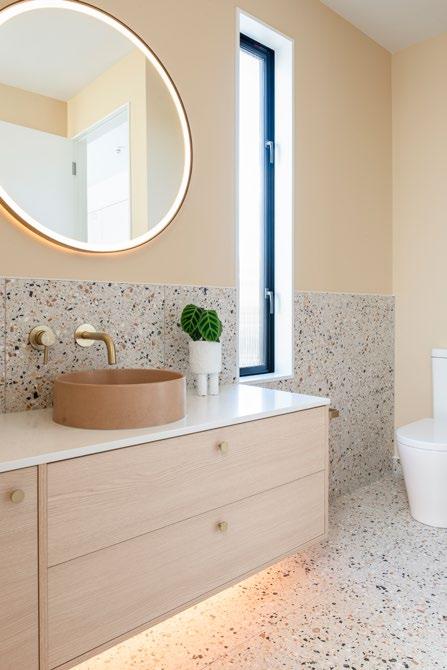
“At first, we thought of cedar but because we live so close to the beach, Box™ suggested Abodo with a Sioo:x coating which protects the wood yet allows it to weather evenly to a lovely silver-grey. If we had chosen cedar, different sides of the house would have ended up being different tones.”

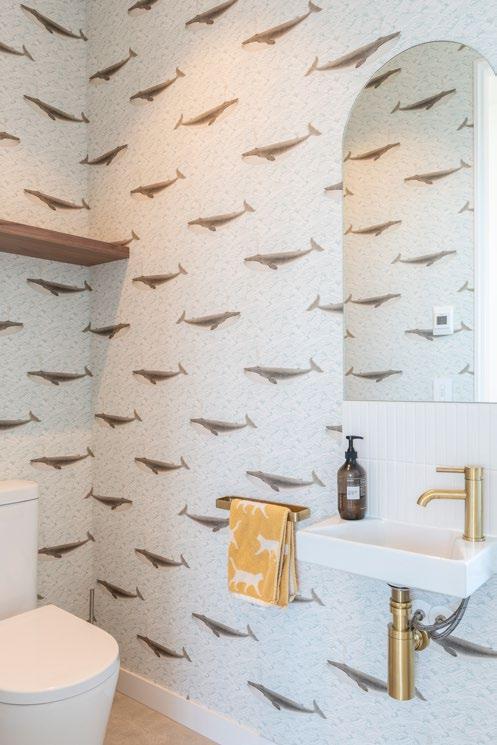
When the build finally started in April 2021, it went as smoothly as possible, lockdowns notwithstanding. Although the couple toyed with the idea of having the living rooms upstairs to access the coastal view, Box™ suggested sheltered indoor/outdoor flow was more important. Wrapped with a deck to the north and an eastern garden landscaped with crazy paving, when Leah is working at the bench in the kitchen, there’s still a peep of the sea.
The layout, with the kitchen sandwiched between dining and living, suits the family, including children Evelyn (11) and Harry (9), to a T. Alongside this open-plan space, a separate living room is equipped with a television and is a bolthole for young and the young at heart. “It’s the first time ever we’ve had two TVs,” says Leah.
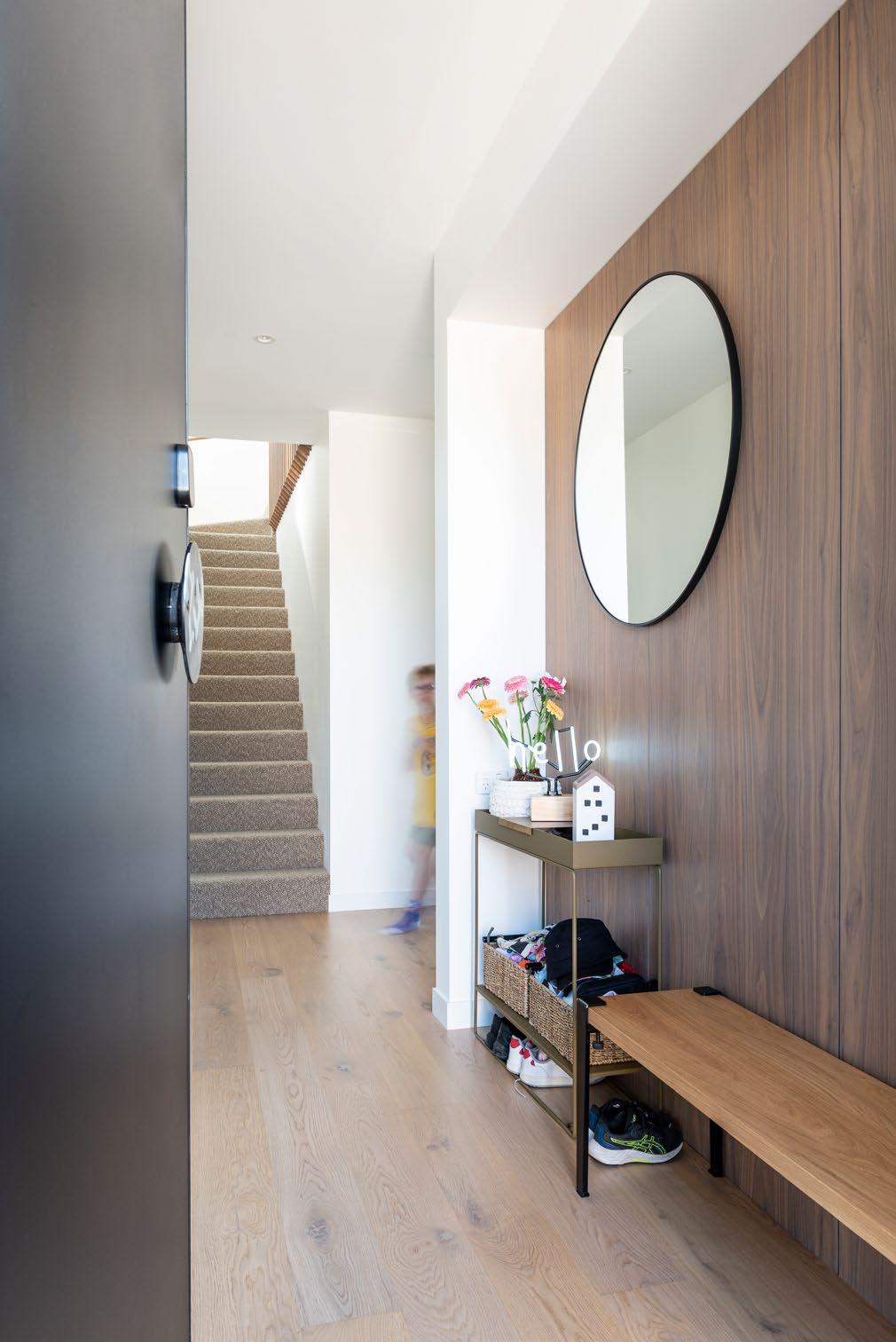
After a day-long sit down with a Box™ design lead, the fittings and fixtures began to take shape too. The interiors give a nod to mid-century features with built-in bench seating in the 50s-style dining nook, and walnut-


The architectural framework may have laid the foundations for a sense of light and spaciousness but it’s Leah who has added the magic. Decorative detail strikes a balance between stylish and family friendly and her use of pattern and colour is a refreshing break from the all-white is all-right mantra.
veneer panelling. American oak engineered flooring provides a warm welcome and the kitchen too has walnut cabinetry paired with reeded glass doors. Brass tapware already has a beautiful, aged patina and the engineered stone benchtop is textural and bulletproof for kids who like to eat here, do their homework here and generally just hang out with an iPad and be sociably close to mum.
Storage and utility was a must-have for Leah in this 211-square-metre home: a walk-in, under-stairs pantry with many drawers and shelves, is a place to hide the jug and the toaster behind doors; the dedicated laundry is a godsend and the underfloor heating is enough to dry any clothes hung here on a rack when the weather is inclement (as it has tended to be this sad, mad summer); there’s more storage in the bench-seat in the dining room and hooks in the garage for the bikes and water toys.
Reeded-glass windows offer privacy from the neighbours on the way upstairs where a tight design programme allows three bedrooms (one with en suite), a separate bathroom and a study so Chris can work from home to be plotted in under a 2.7 metre stud. It doesn’t feel cramped. “We really wanted to maximise the site and by having the high ceiling both upstairs and down, everything feels a lot bigger than it is,” says Leah.
The architectural framework may have laid the foundations for a sense of light and spaciousness but it’s
Leah who has added the magic. Decorative detail strikes a balance between stylish and family friendly and her use of pattern and colour is a refreshing break from the allwhite is all-right mantra. Wallpaper brings a playfulness into being – including a tropical forest (complete with cheeky monkeys) in the dining zone and pineapples in the powder room – and there are painted shades of soft sage green on the kitchen island, and ice-cream pink and teal blue behind the kids’ built-in desks in their bedrooms.
Some might see the multi-coloured resin-topped coffee table in an abstract design that is the fulcrum of the living area as slightly crazy but, after having been diagnosed with cancer during the process of creating this new home, Leah was determined to have some fun. Now happily ensconced after four years’ holding on to the vision, she’s making the most of every part of it. “The double glazing keeps it really quiet if someone’s having a party in the neighbourhood but if I open the doors, I can still hear the waves,” she says. Even though there were supply issues and tricky moments, “it all comes together in the end.”
On Christmas day last year, the family were joined by family from the UK and from Australia. They extended the outdoor table beneath the louvred roof as many hands helped out in the kitchen. Then they watched the children jump on the trampoline tucked to the side of the lawn and enjoyed each other’s company. “It was a really nice day,” says Leah simply. Even the weather played ball.
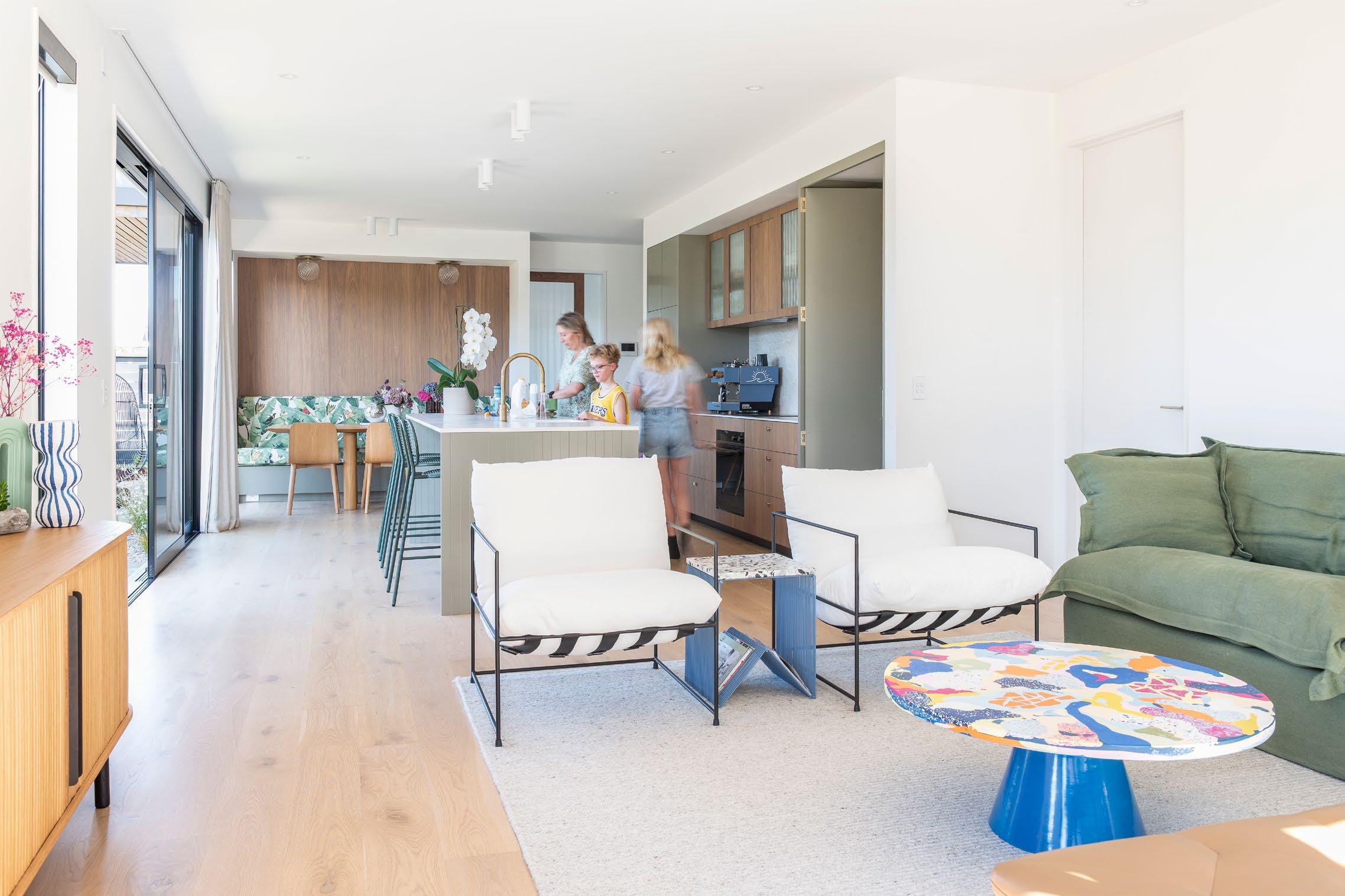


Amelia:
"Tell us about the relationship, how long have you worked with the Box™ team?
Nick:
"Our relationship with Box™ started well over 10 years ago when I drove past a Box™ project in Remuera and instantly fell in love with its look. I Googled Box™ online, then picked up the phone and called their office. I spoke to Nat Holloway, who said he'd be happy if I popped in. This meeting marked the beginning of our relationship, and since then, we have completed well over fifty homes in Auckland. Throughout the years, our interaction with the entire Box™ team has been seamless. If there are any unforeseen technical issues to overcome on-site, they are resolved immediately. This helps us maintain our workflow, control costs, and complete our part of the project on time. As plumbers, we love being part of a build that is modern and features beautiful kitchens and bathrooms. Box™ consistently delivers this every time.
Tell us a bit about your business and what makes it amazing?
Sarah and I established Plumbing Today in 2009 after each spending over 15 years in senior management roles. Our extensive experience has taught us the significance of building strong relationships, effective communication,
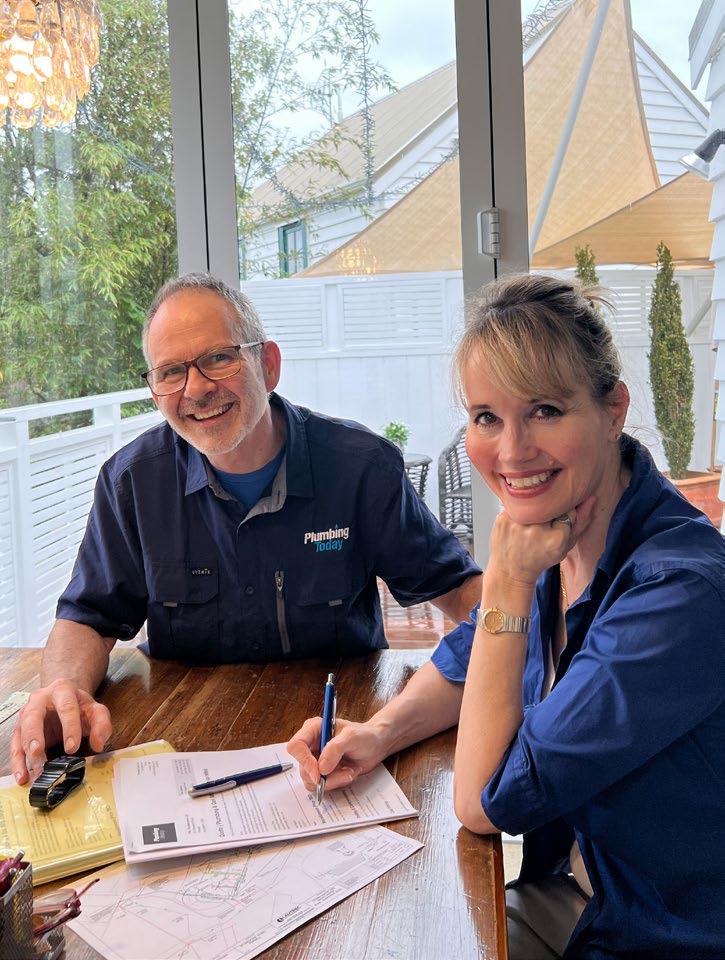
and streamlined work processes. I am a fully qualified plumber, gasfitter, and drainlayer so I have the qualifications and previous trade experience. We had a clear vision of providing exceptional service, and we incorporated our service proposition and brand promise into our name: Plumbing Today. To this day, if you require our assistance, we will be there without delay—same day service, no problem.
What current trends are you seeing among clients?
Bathrooms and kitchens continue to be a carefully crafted blend of function and beauty. Showers are walk-in, large spaces with good quality fixtures. Shower outlets are now designed to deliver a focus spray of water to avoid overspray in the shower resulting in waste of both water and energy saving without compromising on showering experience. Recessed cubicles for soap and shavers make for clean lines, and ease of cleaning. Wall hung toilets continue the trend of style and ease of cleaning. All in all, we notice that bathrooms size is not being compromised.
Do you have any suppliers who make your life easy or want to give a shout out to?
We are proud to be active members of the Master Plumbers association and strongly advocate for the numerous benefits
it offers. As members, we are covered by an extensive workmanship guarantee that provides protection for our clients. Additionally, we have access to valuable resources such as technical advice, health and safety guidelines, and, notably, a mental health and well-being policy. These benefits ensure that we maintain an excellent team of skilled plumbers, gasfitters, and drainlayers who understand the importance of working safely and taking pride in their work.
Any tips to future clients to make their builds easier (and cheaper!)"
1. Ask for plenty of hose taps. They are easy to install and saves needing to buy a long garden hose.
2. If the hot water heater is too far from a bathroom, it is worth asking for a small ancillary water heater, or a hot water ring-main to ensure hot water is supplied without lag.
3. If a bathroom is above a living room or bedroom, enquire about acoustic insulation. This aids in the reduction of sound transfer. No one needs to know that you just flushed the toilet."
To learn more please visit: plumbingtoday.co.nz
 Nick and Sarah Paris from Plumbing Today.
Nick and Sarah Paris from Plumbing Today.
This Mt. Albert home exemplifies the benefits of Unitary Plan zoning with subdivided housing, plus outdoor entertainment and serene interiors.

Unitary Plan zoning in Auckland has both benefits and drawbacks. The ability to put two houses where there was one is an obvious plus – but a negative might be higher density and closer proximity to neighbours. This new modern home in Mt Albert ticked the win/win boxes for owners who subdivided and crafted an urban retreat behind their existing bungalow.
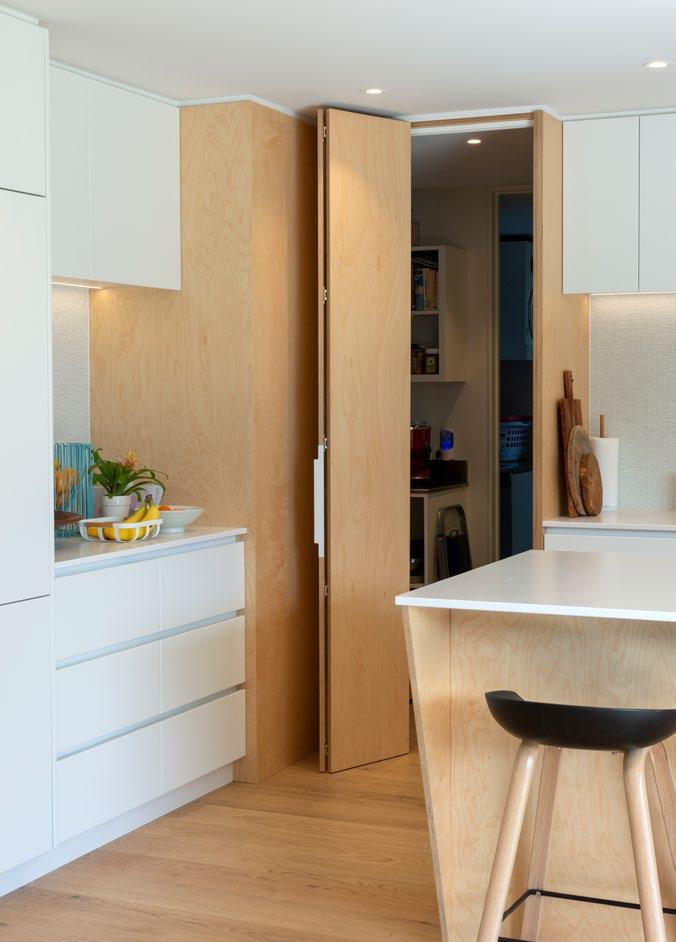
Outdoor entertaining was top of the priority list so the living zones of the home tuck around ample decking where there’s a fireplace and barbecue, and an above-ground pool where Moroccan tiles lend an exotic element to the surround. Inside, all is calmer with Scandi-serene tones of pale timber and white. But there’s the occasional surprise: a sunken living room, an angled island bench in the kitchen, a secret scullery, and a capacious built-in bookshelf so the sociable owners can also pause with due cause over the printed page.
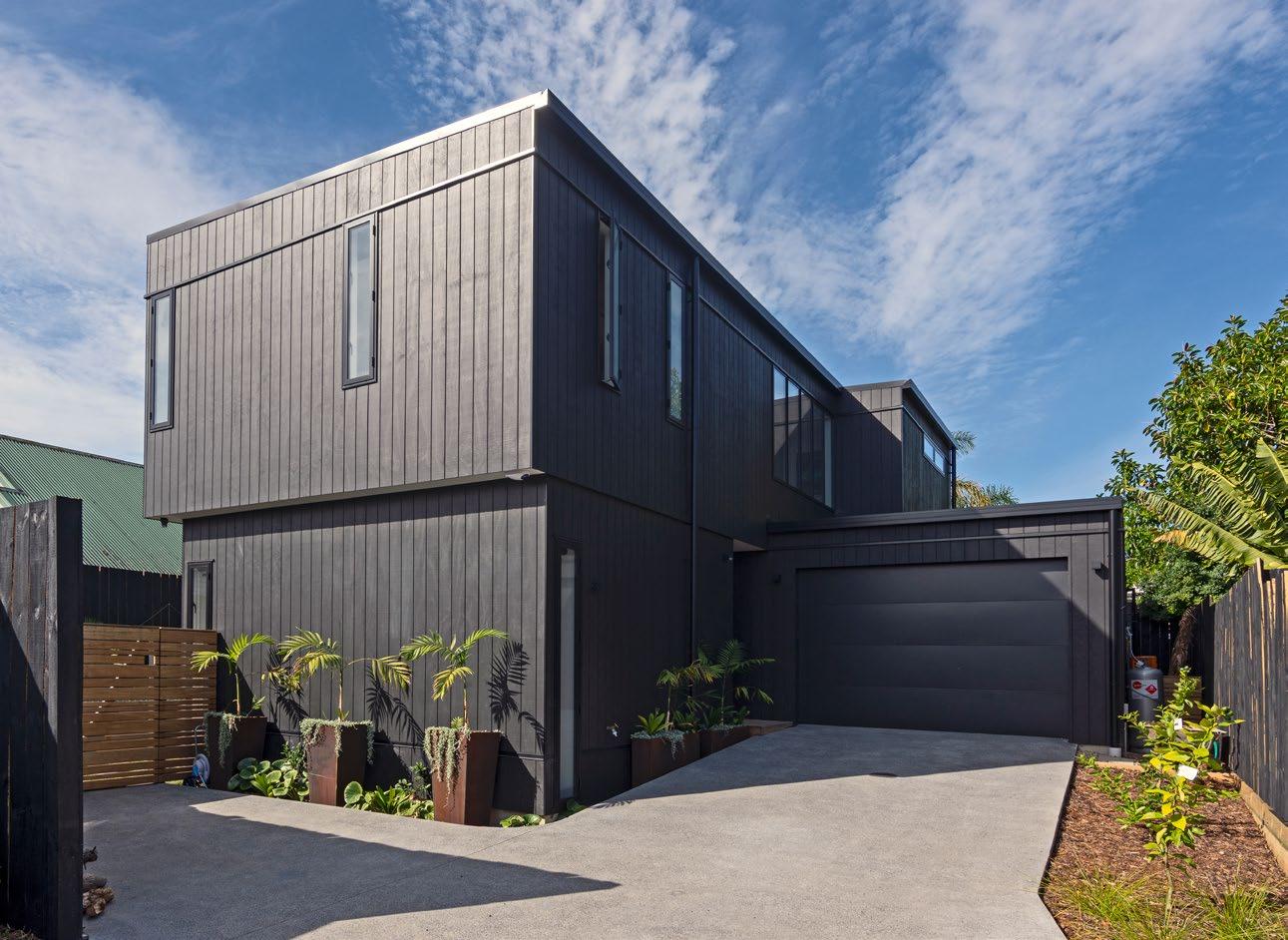
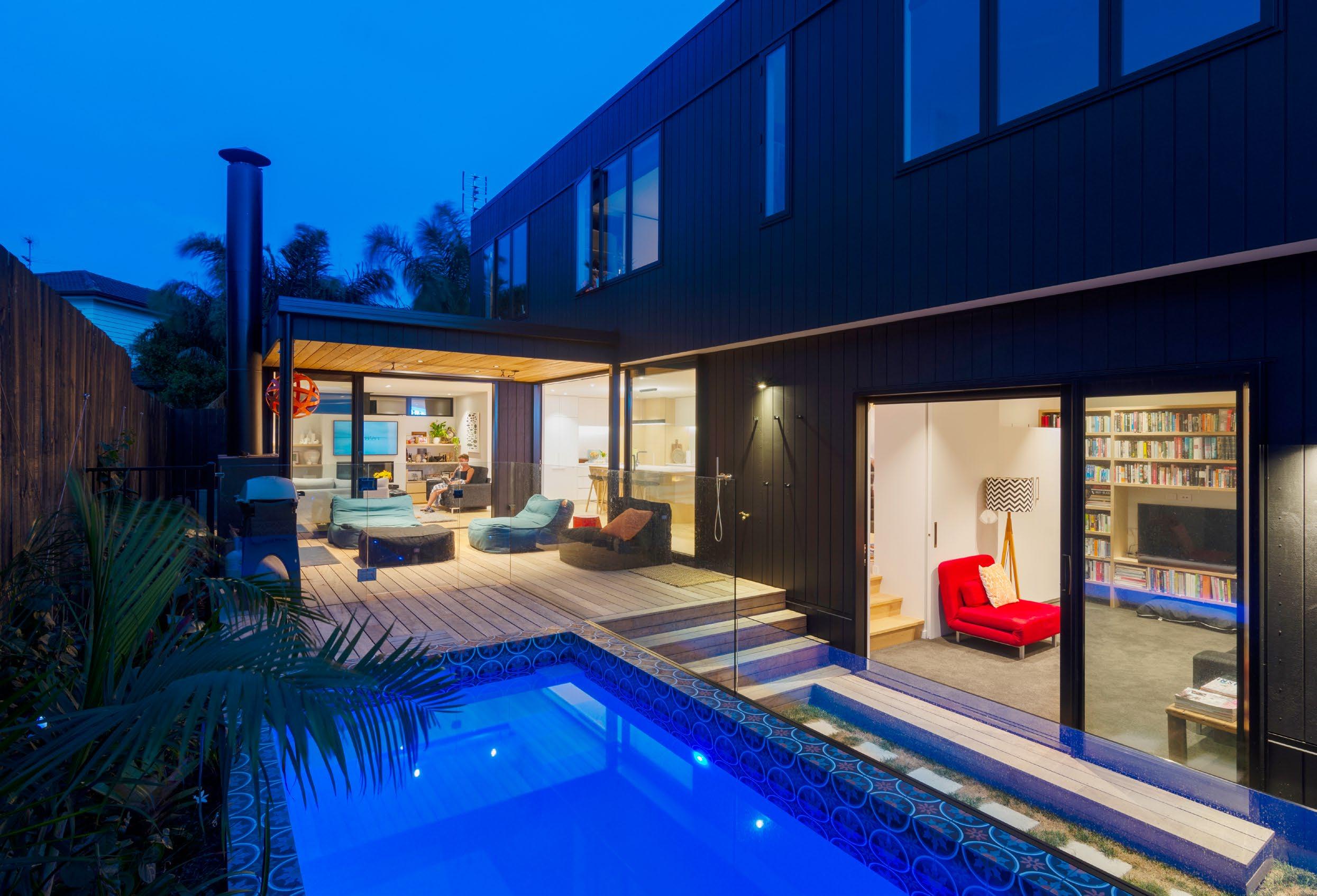
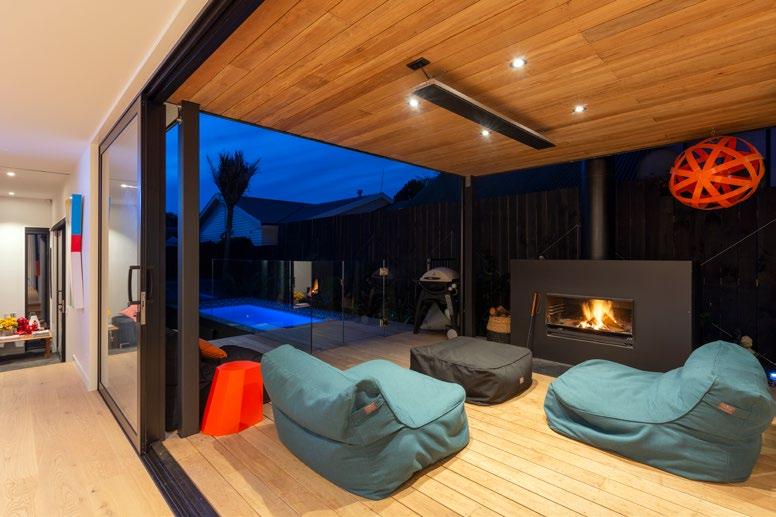

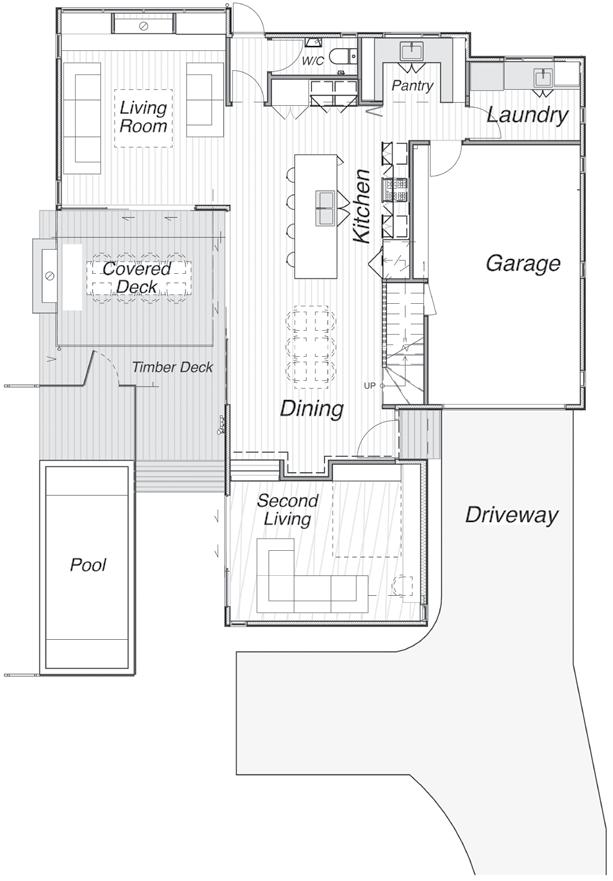
 TOP Despite the small footprint, multiple living spaces co-exist allowing both separation and closeness. RIGHT Large sliders extend the living area onto the covered deck. Wooden surfaces unite the separate spaces.
TOP Despite the small footprint, multiple living spaces co-exist allowing both separation and closeness. RIGHT Large sliders extend the living area onto the covered deck. Wooden surfaces unite the separate spaces.
There aren’t many people in Auckland who get to live in the glorious shadow of a Pohutukawa planted by their father. This site close to the waterfront at St Heliers was special. For one thing, it had not been subdivided in recent years like so many others in this prime real-estate zone. For another, it was cloaked in family history.
The current owner’s dad had bought here in the late 1930s. “He borrowed the money off Mum’s parents,” she says. As was the way in those days, he built a home right in the middle of the plot. The owner has childhood memories of growing up in this environment, of space to explore and boating on the harbour. The Pohutukawa came to the front garden as a tiny tree, transplanted from one of the offshore islands after the war.
So, when the owner inherited the land, she already had a real sense of connection to it. Tired of living in a cold, draughty 1940s dwelling, with cracking walls, she asked Box™ to design a warm home with a peek of the sea
around a tree that was sacrosanct. “I had visited a Box™ house that belonged to a friend of a friend,” she recalls. “I liked what I heard about the company, and I liked the feel of that home.”
Her brief to designers Tony Borland-Lye and Tim Hogarth was simple enough, except for one thing: she wanted to recycle timber from the original residence and to use a stash she had kept for years at a property up north. “We were excited to repurpose the timber,” explains Tim. The long-held native timbers was duly incorporated into the design. But then…the Covid pandemic conspired to confound the plan. “We were in the construction phase and found it hard to quantify the amount of timber our client had. Then too many lockdowns, made the milling slow and unreliable.” It was one step too far for an already disrupted workflow.
Nevertheless, beautiful timber is still integral to the aesthetic. Beyond a cheerful Pioneer Red door, (appropriately referencing the Pohutukawa tree) is an entry foyer wrapped in Abodo timber, giving the warmest welcome. It’s a dramatic beginning, which draws the >

with a deep connection to inherited land asks Box™ to design a warm and sustainable home around a cherished Pohutukawatree.

FIRST FLOOR PLAN
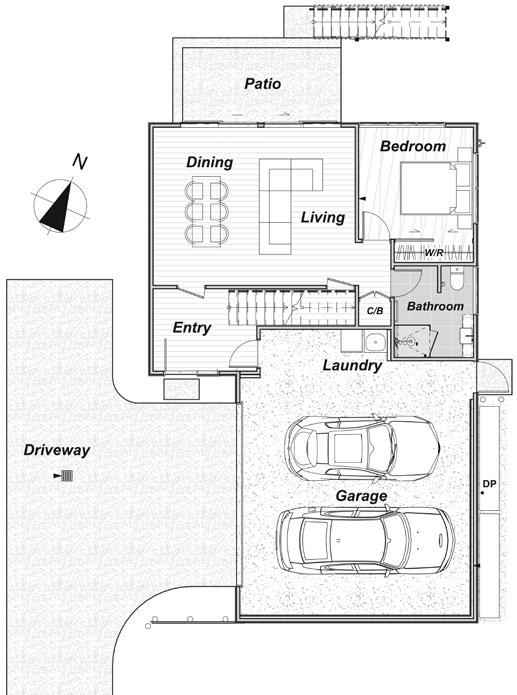




SECOND FLOOR PLAN GROUND FLOOR PLAN

eye away from the secret doors to the garage and ground floor flat, disguised with flush-pull door handles.
The Abodo timber cloaks up the entire stair-void walls around the bespoke stairwell, emerging in the middle level into the openplan living, kitchen and dining room, and a flexi room at the top. “It’s the idea of moving from the darkness to the light,” says Tim. “It creates a journey of discovery.”

A black metal stair balustrade screen, framed in dark-stained oak, contrasts with the American oak timber floors that feature throughout the mid-level living area. The pale honeyed flooring tones of wood continue in the oak plywood kitchen cabinetry, where they are teamed with white and black for a fresh modern look. A square picture window above the back bench frames a slice of green space effectively, a sightline to the backyard gardens of the neighbouring houses. Extensive floor-to-ceiling glazing leads out onto a deck brings in a massive panorama, which stretches across the water to North Head to the west and Rangitoto Island to the east. “As a child, our client used to spend time watching the large boats come into harbour,” says Tim. It’s a tradition her grandchildren can continue, with the new home’s unobstructed views to the water.
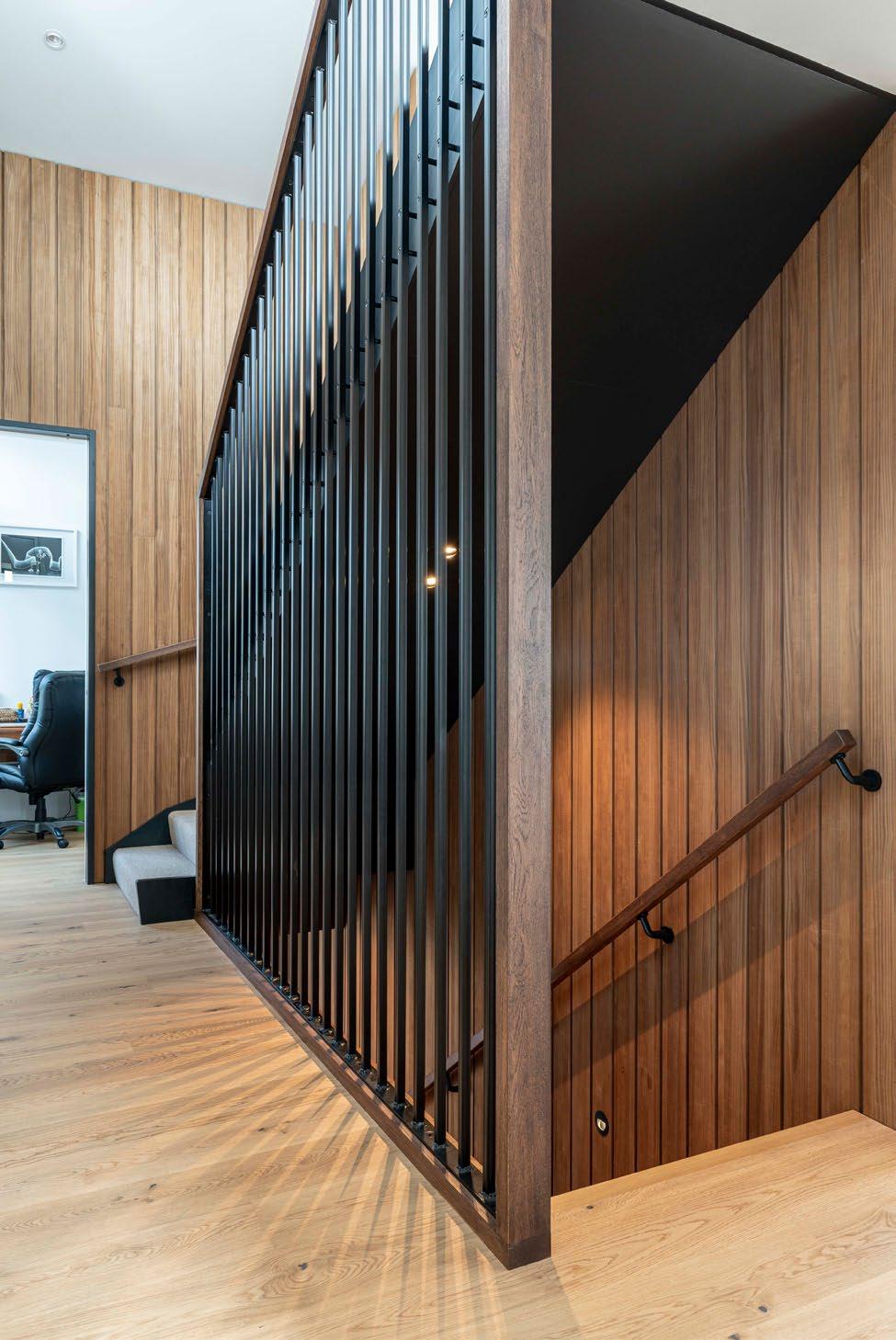
Built on land closely held for decades, this house is intergenerational in more ways than one. At street level, alongside the double garage, is an apartment-like space which the owner’s adult son occupies. It’s private but not self-contained, with cooking and shared meals taking place in the light-filled kitchen/dining room upstairs. Behind the living zone on the middle level are three more bedrooms and the main bathroom, with a large bathtub that was a ‘must-have’ for the owner’s partner and her grandchildren.
“At one stage, there was a mini flood as one of the grandchildren got a bit over-excited with making waves in the bath,” says Tim.
The third floor was important to grab a full-frontal view of the sea and allowable within height-to-boundary restrictions because the section is, fortunately, flanked by two neighbouring driveways. Through clerestory windows that tuck in below the sloped ceiling, an iconic tableau is framed: that Pohutukawa tree in one direction and the conical form of Rangitoto and the harbour in the other. This flexi space in the treetop can be either an office, a bedroom or a second living room, but it’s always spectacular and of its place.
Having never built before, the client says she found the process easy. “I just left it up to Box™ to do it.” That included some green schemes. Solar panels installed on the roof and tanks on the property, capturing grey water which is used for the garden and to flush the loos. “Sustainability and environmentally friendly practices are very important to me,” says the client. She loves waking up in the morning and always takes a leisurely moment to pause and look up into the silvery branches before she starts her day.
While there is no intention to develop the roomy backyard, Box™ sited the home between the tree and a possible future boundary should plans change. The exterior cladding is dark-stained Abodo on the lower level is offset by Abodo in a mid-brown tone on the upper floors, and tray-profile standing seam metal roofing wraps down and around the living box. The metal cladding is an approach that serves to bring textural interest to the exterior and break up the massing of the home. Not that there’s too much of that. “It’s a big house but none of the spaces are enormous,” says Tim. “Everything has a purpose. There’s no random opulence; it’s a home that is no more than it needs to be. Form follows function.”
Having never built before, the client says she found the process easy. “I just left it up to Box™ to do it.”
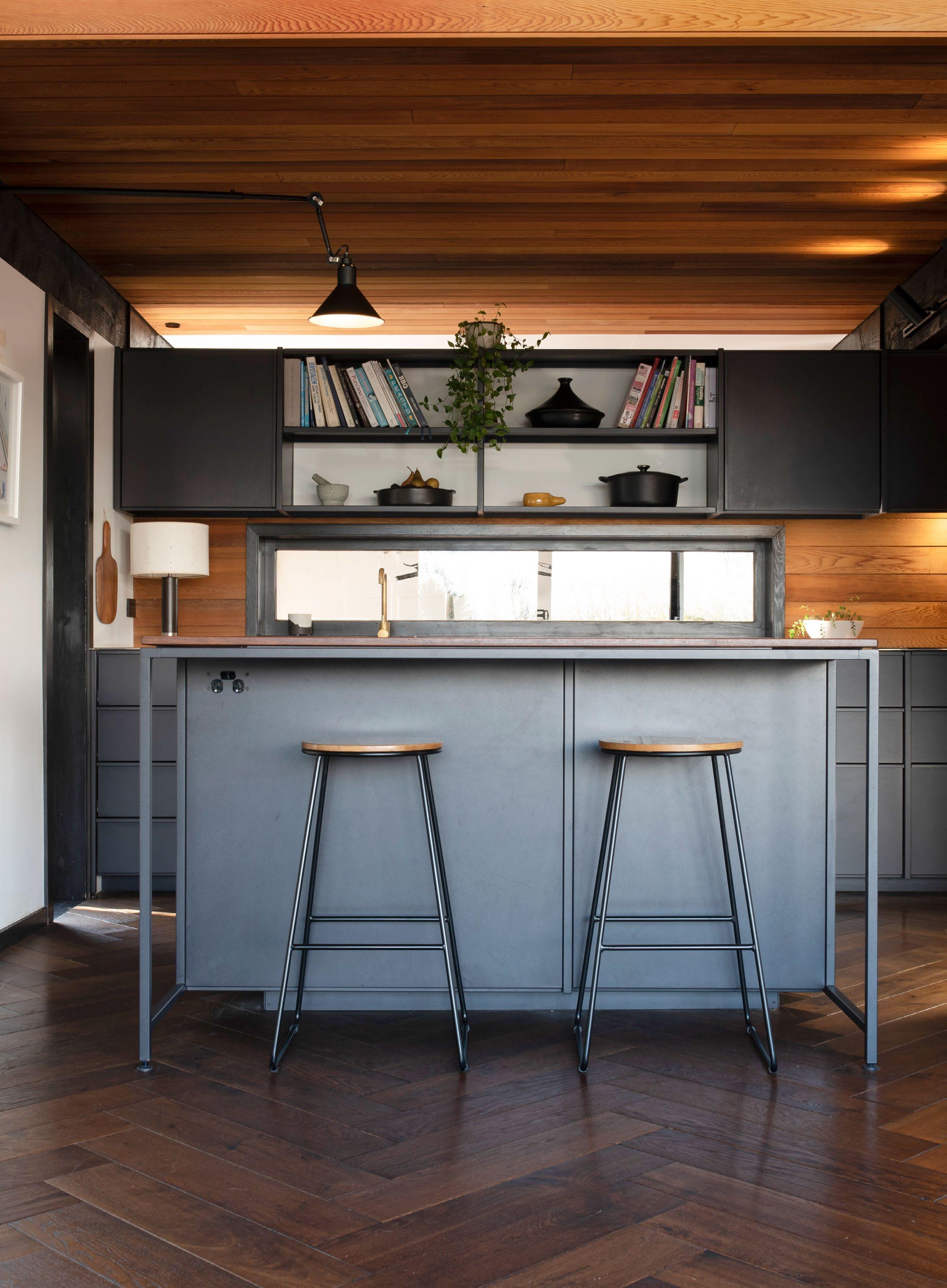

Caragh :
"Tell us a bit about the relationship, how long have you worked with the Box™ team?
Damon:
"Vienna Woods has been partnering with Box™ for almost a decade. We appreciate the relationship with Box™ , being one of the best building team we work with. Box™ are unique in the design/ build space since they have a distinctive modern design sensibility, are architects with a full in-house team, as well as estimators and builders. Their builds are well-managed and aspire to fantastic quality which makes working together that much easier.
Tell us a bit about your business and what makes it amazing?
We are known amongst our customers as a trusted authority in timber flooring. Our expertise is rooted in a deep understanding of European-made flooring, known for its exceptional environmental standards, health benefits, and durability. Most of the products are imported exclusively by Vienna Woods. We go the extra mile to source natural and distinctive timber products, carefully selected and often imported exclusively for our customers. With our unique offerings, customers can create an ambiance that is truly one-of-a-kind. We’re proud that our flooring can stand the test of time. We believe in the longevity of our products, and we're committed to being there for the homeowner, throughout the lifespan of your floor.
Do you have a favourite home build project, and why?
We love herringbone as a design feature and we were fortunate to work with Box™ co-founder Dan Heyworth on his own home renovation. This product is quite special. It is a Flamingo Parket herringbone with a patina finish called Himalaya. The finish
has a depth of colour and copper undertones, which is near impossible to emulate. We love Dan and Sophie’s classic contemporary style and we think the floor looks amazing. Another Box™ project - Towai St - it’s a Vienna Woods favourite. Timber cladding on the walls work perfectly with the timber flooring (Vienna Woods, Baltic Cashmere). The stairs are a stunning design feature, raking back with square nosings and beautifully executed mitre details. Love it.
These railway sleepers were originally produced from French oak and some endured a century of changing seasons. Raftwood is no longer produced from reclaimed railway sleepers, however it is still rich in features and character. Raftwood is the epitome of rustic flooring.
Any tips to future clients to make their builds easier (and cheaper!)
Stairs can be a beautiful feature in timber, however, pay attention to some finer details of stairs so that you don’t spend more than necessary. There is a huge amount of variability in stair costs depending on whether they are open underneath or on the sides, closed in with balustrades, raking back risers, bull nose, or a straight 90 degree waterfall. The other factors are stair width; if stairs are even just slightly wider than the board lengths, then the wastage cost can be high. Many of these features can be part of a desired overall impact, however if there are features here that you don’t value, then it’s a good discussion to have with your architect and flooring contractor.
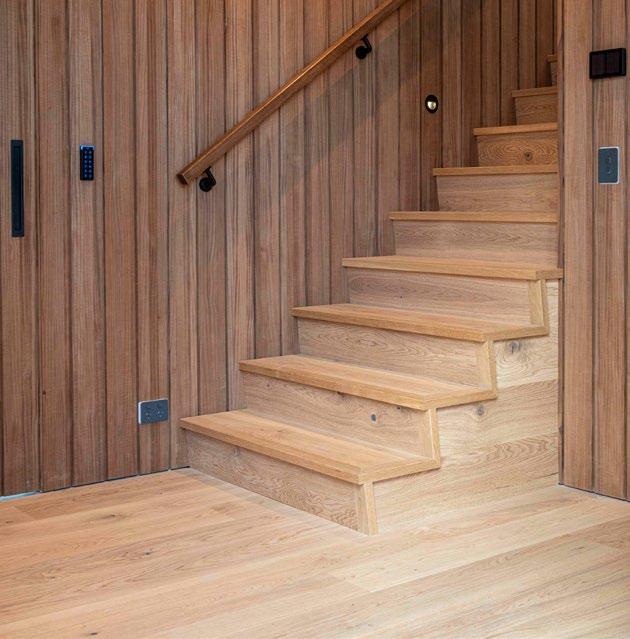
Any recommendations for Netflix / AppleTV / Prime etc TV series?
Netflix – Django Unchained
Neon – Better Call Saul Apple TV - Silo
What current trends are you seeing among clients?
Wall and ceiling cladding. From reclaimed timber, to incredibly variable rustic floorboards to prime grade clean finished timber, we are seeing some beautiful spaces created using timber beyond just flooring.
Any particular products you use and are really keen on at the moment?
Raftwood. This product was originally sourced from reclaimed railway sleepers.
If you were designing a house for yourself, what type / style of house would it be?"
The problem in our industry is that we see so many amazing homes and incredible architectural features, that we would need to build five distinctly different homes to encompass everything on the wish list! That said, my wife Tamsin has always wanted us to convert an old kiwi-style church into a home. I really want to use Flamingo Raftwood for flooring, which I think suits high vaulted ceilings and Crittall windows. I guess the common denominator is a building that has a nod to the past and a bit of soul."
To learn more please visit: viennawoods.co.nz
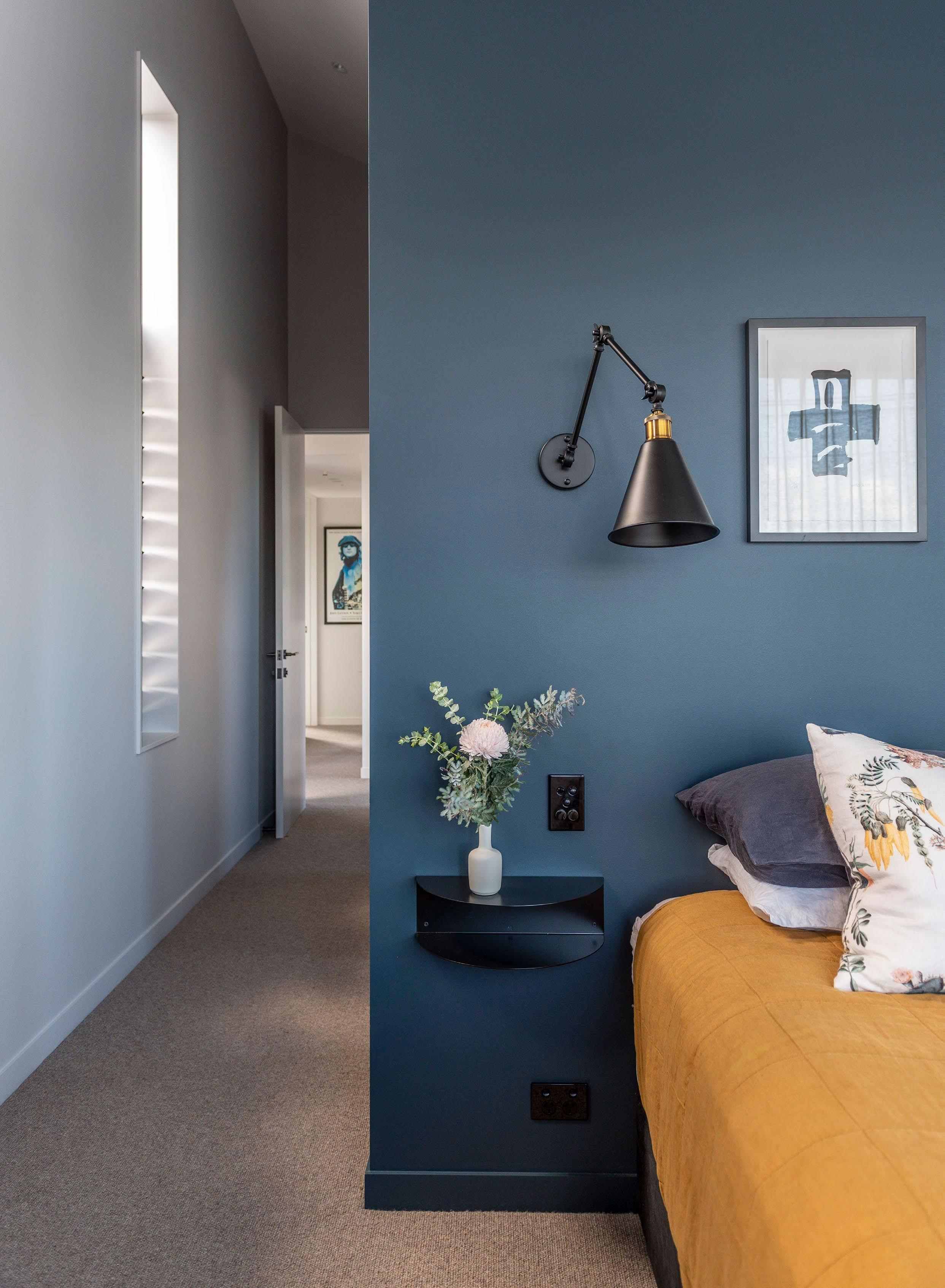

Sahaj:
"Tell us a bit about your business and what makes it amazing?
Kirk:
"I started Kirk Electrical in 1998 because I wanted to offer a personal electrical service to customers. Now, 25 years later, my team and I cover the wider Auckland area for residential new builds and renovations, commercial fit-outs and data communications solutions. Kirk Electrical is a member of ECANZ (Electrical Contractors Association of NZ) and a qualified Master Electricians member, so our clients can trust us and our work to be of the highest possible standard.
A big part of my business is a commitment to the future of the electrical industry, which is changing fast with the development of new technology. At Kirk Electrical, we support school gateway programmes for young people wanting a career in the electrical industry and we train apprentices to our high standards. By offering this experience alongside our professional team, we’re helping to ensure there are qualified electricians available to meet the demands of the future.”
Tell us a bit about the relationship, how long have you worked with the Box™ team?
Kirk Electrical has partnered with Box™ for seven years, commencing with our initial collaboration in 2017. Our Electricians have been actively engaged with the Box™ team, contributing expertise
to residential housing projects across Auckland and a few commercial fit outs. We enjoy working alongside Box™ who provide detailed design drawings which makes it more efficient for everyone involved in the building process. The Box™ team is dedicated to getting the perfect final finish to any project they take on.
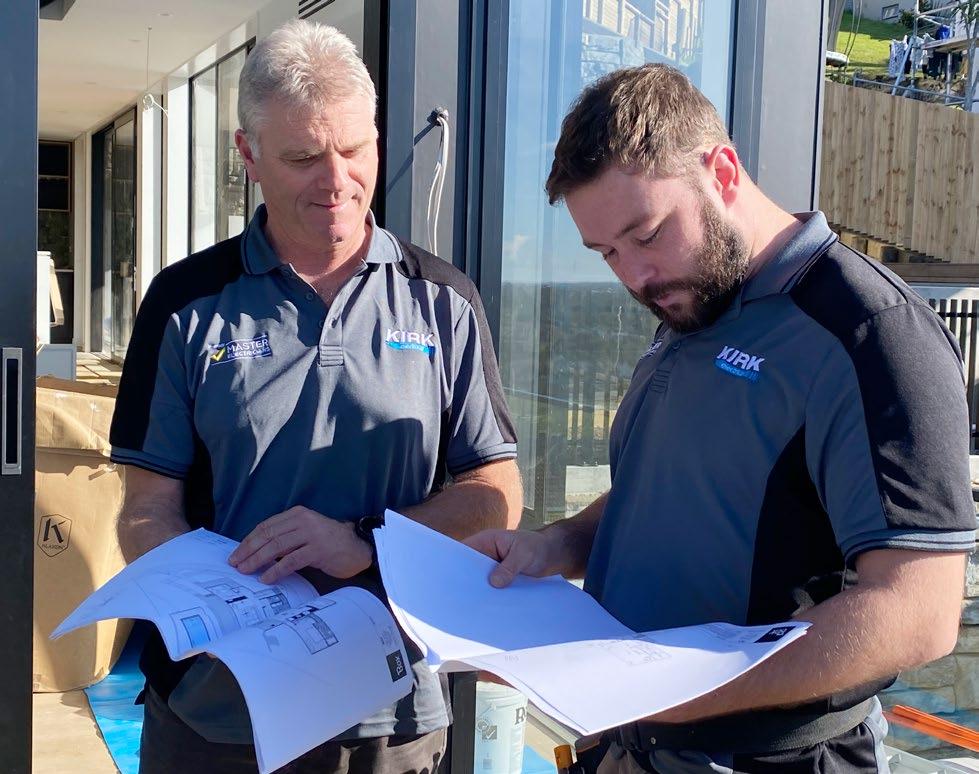
What current trends are you seeing among clients?
Technology is continually evolving, and this is changing the way we want to live in our homes. Smart home automation and EV chargers are top of mind for many at the moment because of its ability to improve security, comfort, and energy efficiency in the home. Smart home automation has also become more affordable and accessible in the past few years, especially with systems like PDL Wiser ™
The Wiser system can be run from a single app on your phone without the need for any special wiring. It can control almost everything in your home from lights and heating to audio visual systems, and security cameras. Wiser even has motion sensors that can notify you if doors and windows open unexpectedly. You can use Wiser to tailor how your home operates and control it from anywhere in the world. It’s scalable too, so clients can start small and add to it over time.
Then, with the growing interest in hybrid and EV vehicles, we recommend our new build clients and those undergoing a major renovation install an EV charger like PDL’s
EVlink Home charging station, or at least pre-wire for one in the event they want it later on, or as a selling point in future. We can also retrofit them for existing homes.
The PDL Iconic® switch and power points range is a go-to for us because it offers clients a range of styles and finishes to suit any interior. It can also be easily linked with the Wiser system, allowing you to automatically turn appliances such as heat pumps on and off at a time that suits.
I think people often forget light switches are more than just a functional necessity and only come in white plastic, but Iconic is a game-changer. The different finishes mean you can choose a cover that really complements your interior design or even use different covers in different rooms or areas of the home. And once the base grid plates are installed by an electrician, clients can easily and safely change the covers later for a new look.
Do you have any suppliers who make your life easy or want to give a shout out to?
I’d like to give a big shout-out to PDL by Schneider Electric. Their products are always reliable, are trusted by our team of electricians and they’re designed for the way Kiwis want to live."
To learn more please visit: kirkelectrical.co.nz
OPPOSITE Well implemented lighting features, controls and power points make for easy day-to-day living. ABOVE Team electrician Jackson (right) alongside Kirk Anderson, owner of Kirk Electrical who have been in business for over 20 years.Good old Winnie (Churchill, not Peters) can always be relied on for an apposite, pithy phrase and when he said, “He who fails to plan is planning to fail” he was not wrong. When it comes to house design, a good floorplan can make or break the deal. While each site is unique and every client’s needs and budget is different, after 14 years in the business, at Box™, we’ve found that the same issues in terms of the home’s layout and how it should function tend to crop up.
Here we talk through five floorplans that were the right solution at the time, but which can also be tweaked to adapt to common situations.
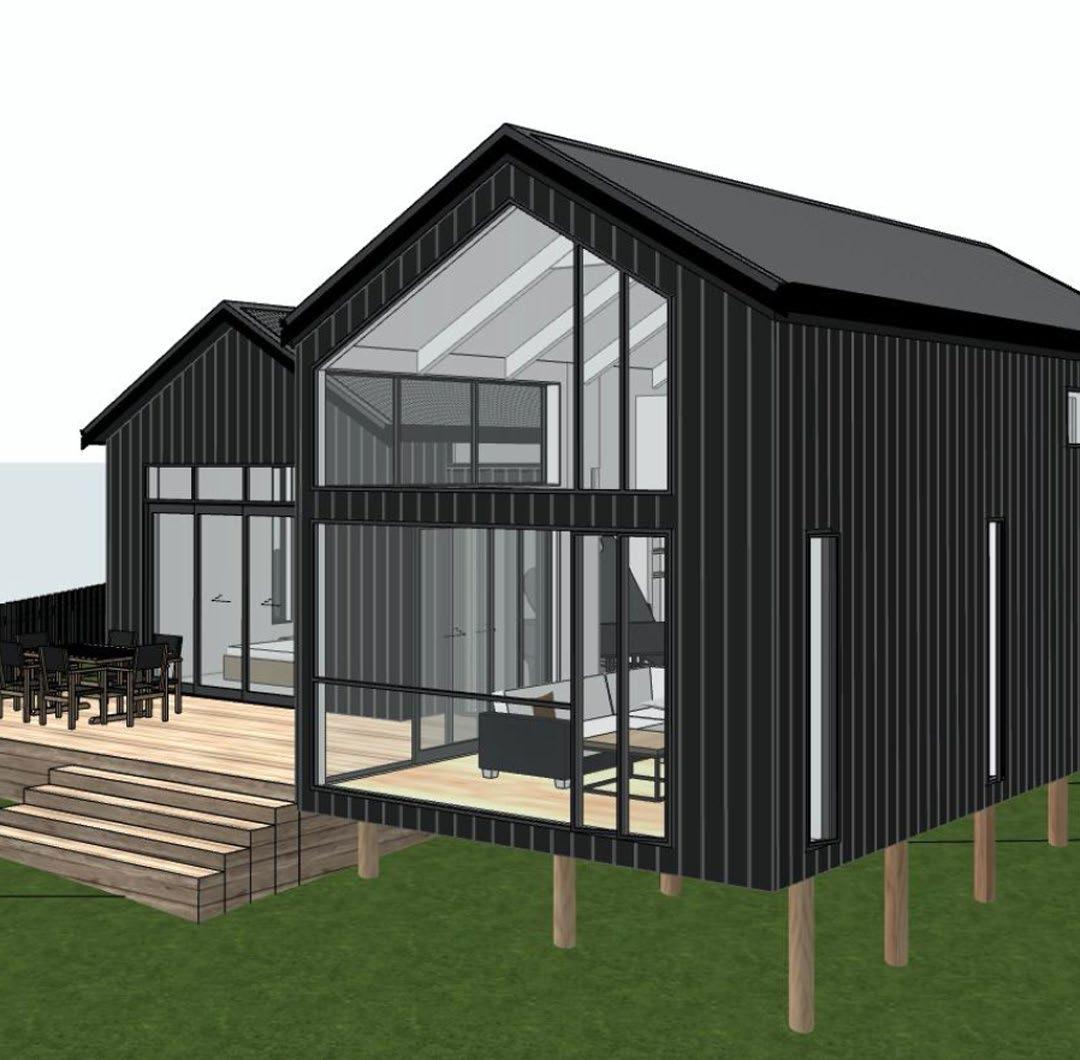
Everyone knows that a north-facing site is primo, but what happens when the best views are to the south? In this attic-style Waiheke home, we wanted to maximise the vista and the available sunlight, plus protect the occupants from cold southerlies. Two offset pavilions, running north/south on the property capture all-day sun, flooding in from the east, north and west through high clerestory windows, and create a sheltered courtyard to the northeast which is bounded on one side by a covered carport and storage. It’s a comfortable place to retreat to if the southerly is howling but there’s the option of another deck to the west to enjoy sundowners should it be calm.
Unusually, the living areas are to the south where they access the view through towering windows that push up into the gabled roofline, but the three bedrooms along the north-west elevation feature a mix of vertical and horizontal slot windows to provide both light and privacy. A mezzanine, set above the kitchen, hunkers under the exposed rafters of the roofline to comply with height-to-boundary regulations and, facing south itself, gets a magnificent frame of a Pohutukawa and the ocean beyond through the living-room windows.
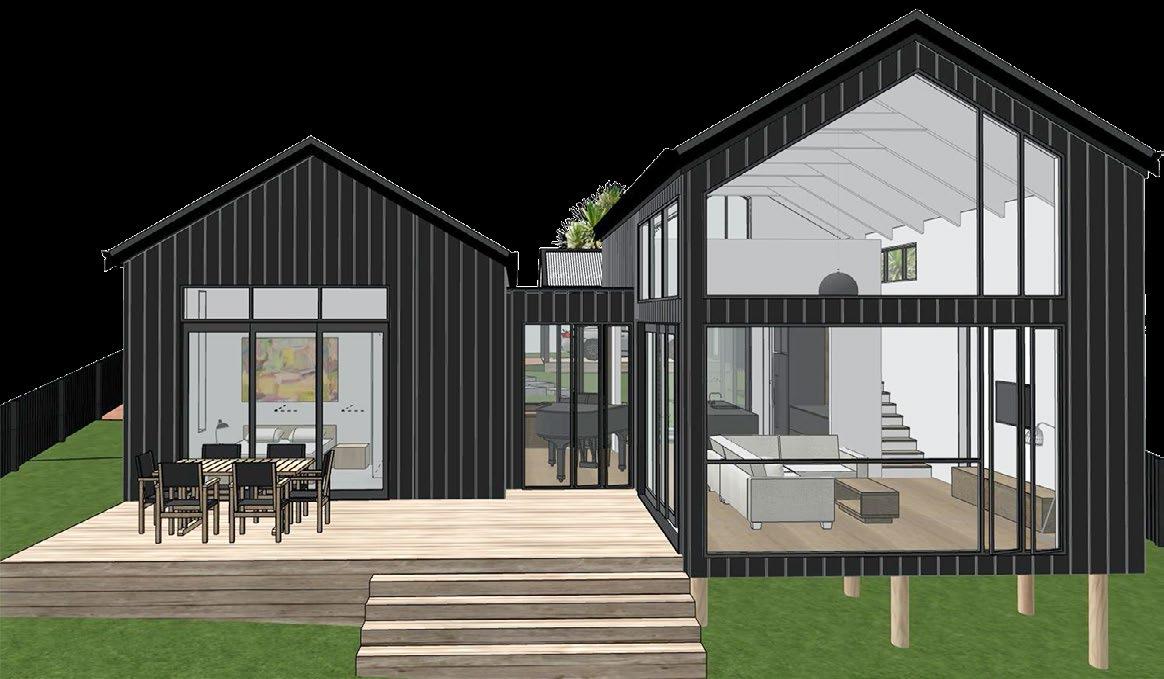
To futureproof the plan, Box™ included an allocated dining zone, but it’s also large enough to accommodate the owner’s baby grand piano instead, and the large kitchen island can accommodate lots of stools for casual dining. Grouping the living zones and the master suite together and using a stair to separate this from the other bedrooms, effectively creates the feeling of a self-contained space when it is only the owners in residence.

This home on a generous site had to operate successfully for just two people in their early retirement – and when a large family came to stay. With a 270° outlook, there was no shortage of views. Built in a subdivision in Kerikeri, on land where there were conservation values to encourage birdlife, the house had to have a restricted footprint although there was plenty of opportunity for a very large garden.
An L-shaped plan proved the answer, a form that would give the house presence and a sense of intimacy within this open landscape but where the internal rooms, along with covered and uncovered alfresco spaces, could make the most of views to the bush and the river and the Bay of Islands while following the sun. The communal living spaces – kitchen, dining and lounge and laundry - are in the centre of the plan. They act as a buffer between the owners’ wing on the eastern elevation (with a bedroom, a shower with an island view to celebrate and a morning deck to take it easy on) and their visitors. This latter part of the dwelling is larger and boasts its own TV room complete with kitchenette where young or old or those in between can be closeted away in peace, plus its own bathroom to serve the two bedrooms.
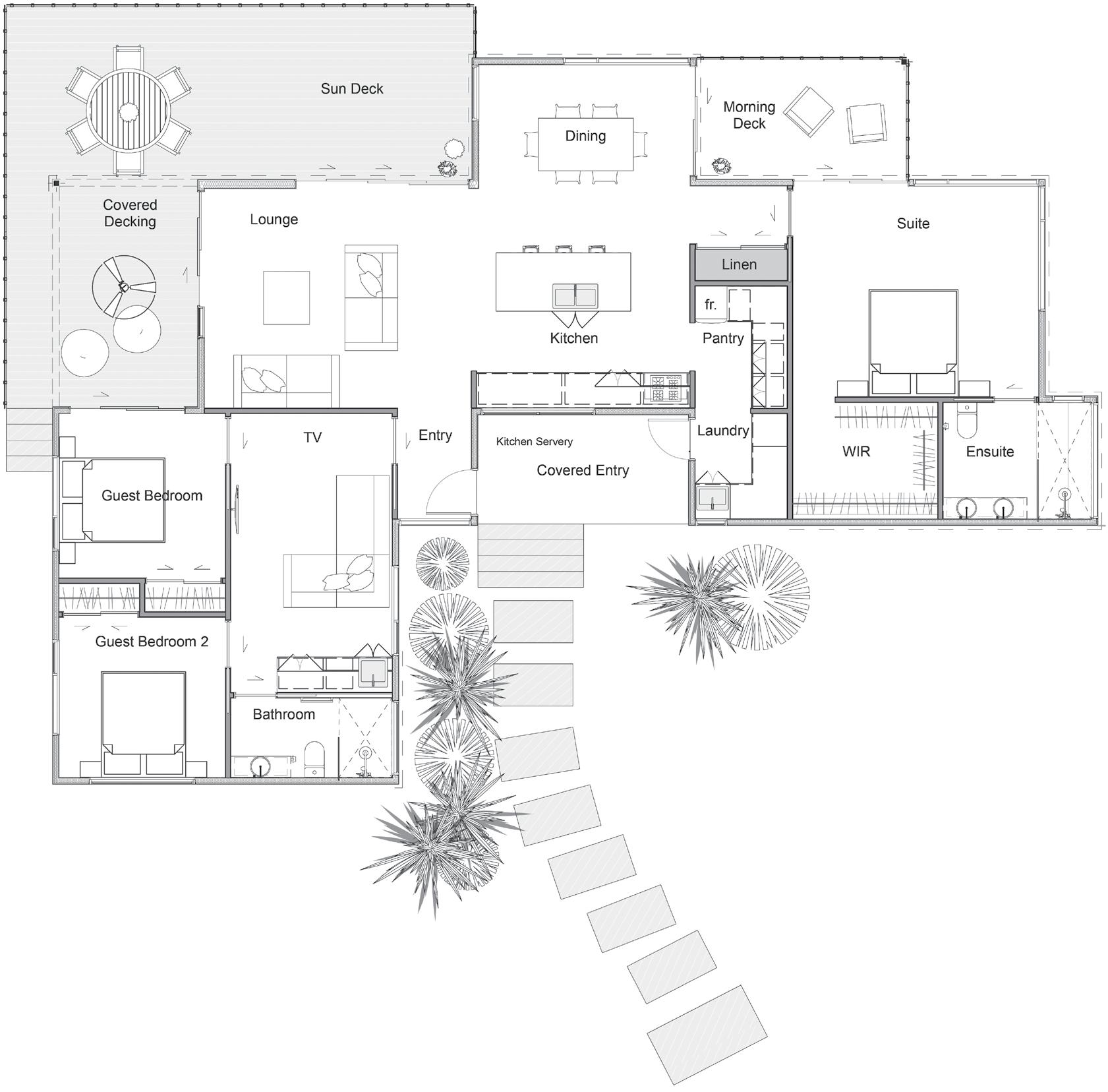
Box™ did not group the services in a single hub in this instance, as the client’s brief and the aspect of the site itself outweighed any financial saving. An opening kitchen window to the south acts as a servery onto the entrance deck and a grassed area with a carport which is another covered alfresco area in times when the northerly blows. Flexibility of living is key here and, when it comes to views, with decks wrapping around the north-west and on the north-east, everyone gets a chance to grab a slice of something nice.

This home of 87-square metres (a simple gable with big picture windows) is part of the pre-designed Artis collection. It will be built on a Waiheke property to accommodate extended family – and is blessed with views of the ocean and beach to the west. A larger home at the opposite end of the site will accommodate the owners. Wastewater requirements on the island necessitated a secondary dwelling that was smaller, and the challenge was to craft it without removing several native trees.
The solution is a two- level, two-bedroom house with hard-stand parking. A 3.5 metre x 3.5 metre deck, facing north, extends the living without pushing the property size beyond regulations. Entry is through a brightly coloured front door directly into the living space which faces the view opposite where sliding doors permit access to the deck. A double-height void above the living room allows the feeling of vertical volume and skylights in the roof above bring in yet more light. A guest toilet is tucked in under the stairs, making good use of every metre of space. Upstairs the two bedrooms share a bathroom. The main bedroom is positioned for a view of the ocean and is large enough to be able to accommodate two single beds if need be. A robe between it and the guest room provides a good sound buffer.

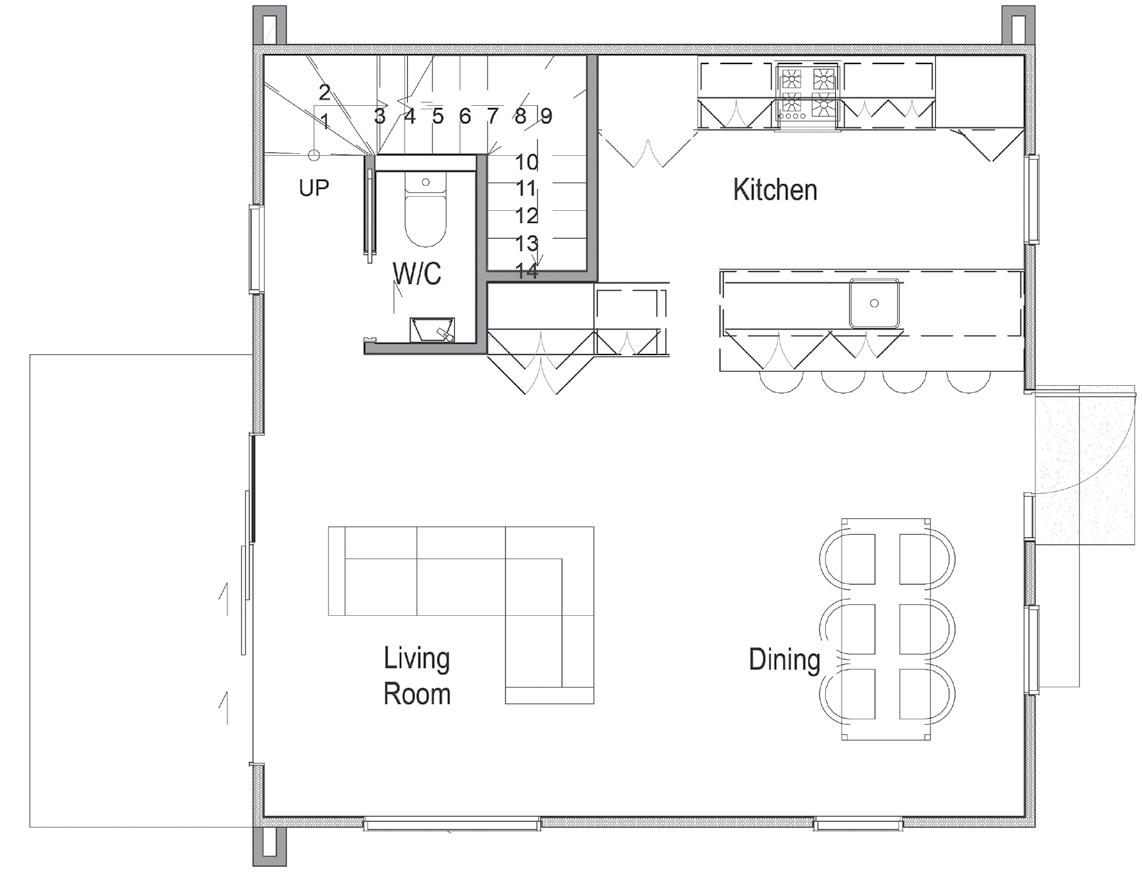

With amazing views across the water to Kapiti Island, this permanent home atop the sand dunes in Peka Peka, was exposed to high winds. A protected east-facing courtyard serves several purposes. It acts as an entry space via a security gate from the street, is a fenced off place for the owners’ dog to exercise (and provides somewhere to wash their beloved pet after long walks on the beach) and is protected from the winds – so a nice outdoor room to sit on mornings with a cup of coffee. Glass walls here and on the westfacing living area opposite mean the view of the ocean is unimpeded from the courtyard. This is a blended family so occasionally the house needs to accommodate six children. Capacious living spaces offer a convivial place to gather but crafting a floorplan that allowed for privacy was equally important.
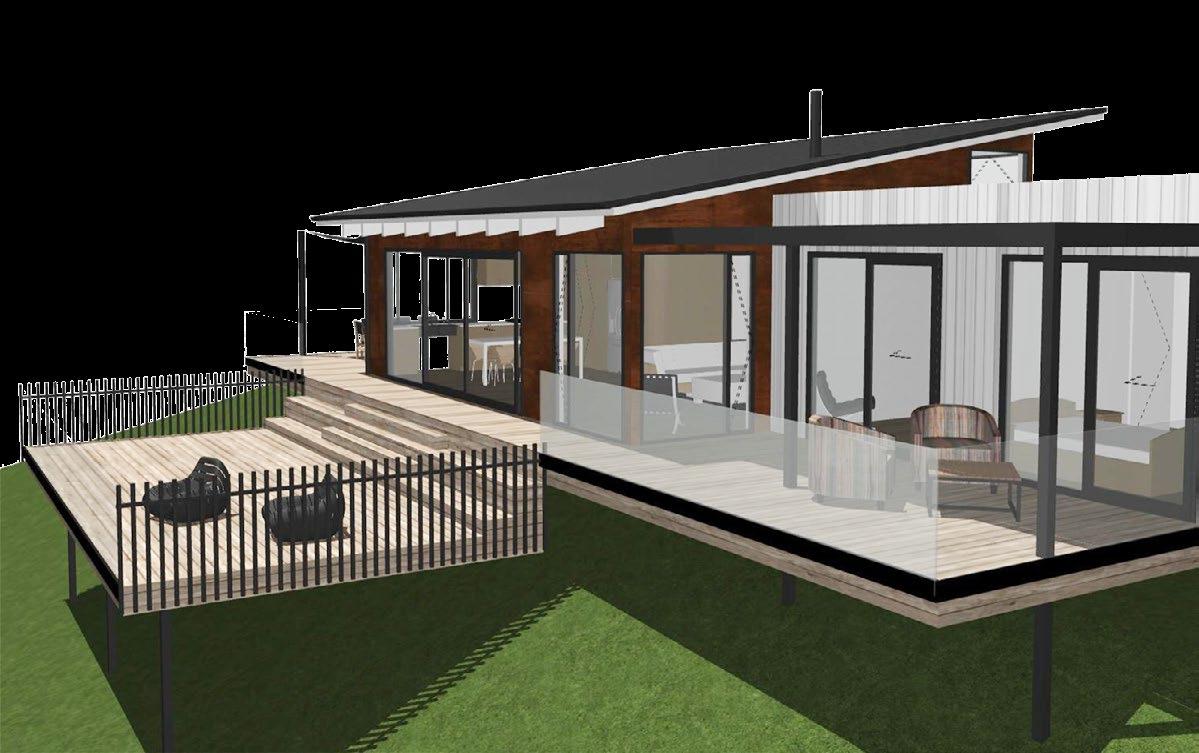
The main bedroom is to the north, separated from the remaining two bedrooms on the south side by the living zone. In this guest ‘wing’, there is also a flexi room which is a space to watch TV but can double as another bedroom. Built-in window seating (aka a daybed) in the hallway offers a secluded nook for reading or, when summer holidays roll around and the house needs to absorb the crowd, could transform into a further place to sleep. In the main bathroom, the WC, shower and vanity are separated with doors, rather like that in a caravan park, so that three people can use the facilities at once. High windows to the east bring in lots of gentle light and a shade sail on the northern deck means the home is protected from too much sun in the summer.

At 68 square metres (excluding decking), this is a tiny house that fits within the minor dwelling definition as stipulated by Auckland Council. Located in Sandspit on the waterfront, it is used as a holiday cabin where extended family can come and stay.
To save space, the entrance is off a covered deck directly into the dining/kitchen area. This extensive decking, accessed through sliding doors, amplifies the living zone which is also linked to a flexi room that has been equipped with sofas and a fold-down bed, so it can be closed off when needed and made into a third bedroom. In all the bedrooms, hanging space is provided by hooks on the wall. The need for wardrobes in a holiday home is somewhat negated but nevertheless a 600mm wide robe could still be provided in the 3.7m x 3m rooms.
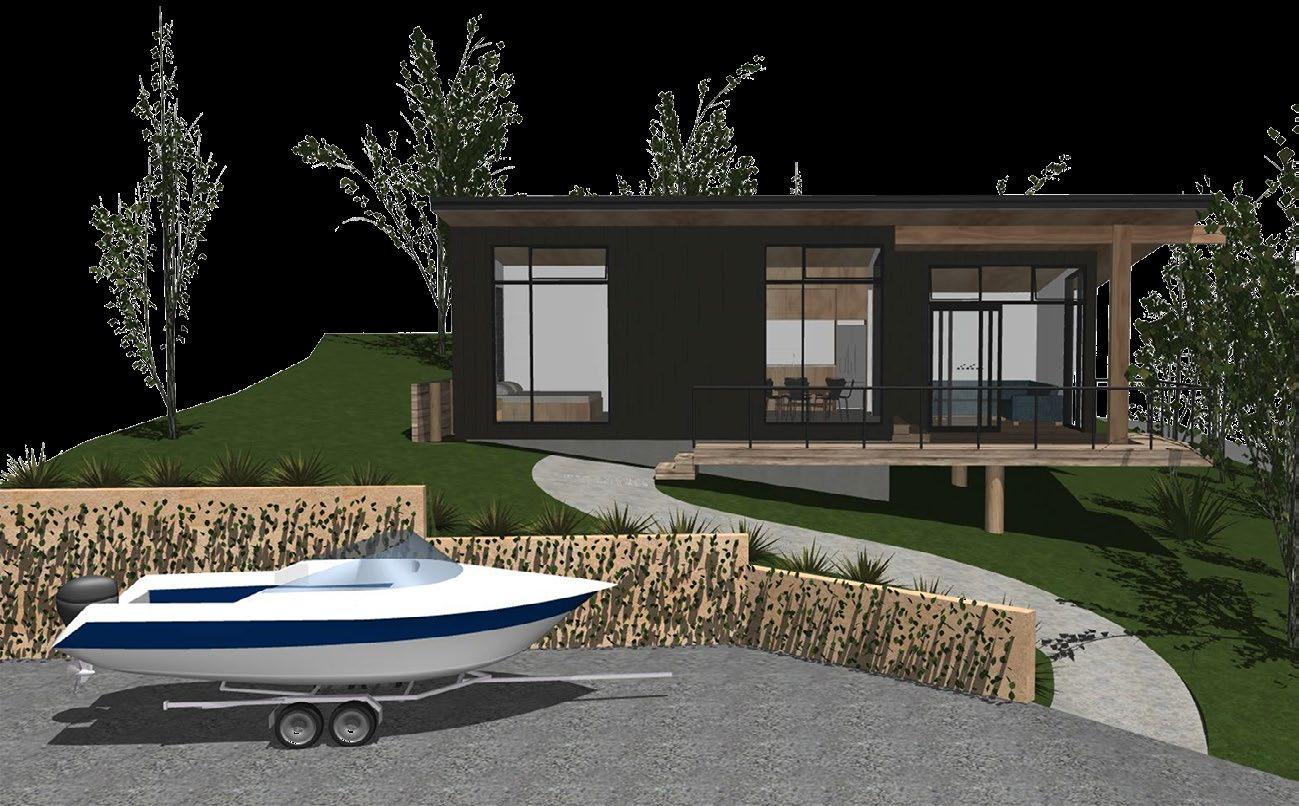
To save on plumbing costs, the services –kitchen, bathroom and laundry - are grouped together in the centre of the plan. The dining/ living zone and the main bedroom benefit from a higher roof stud at the northern end of the monopitch and highlight windows to the north and west allow this compact cabin to feel more spacious.
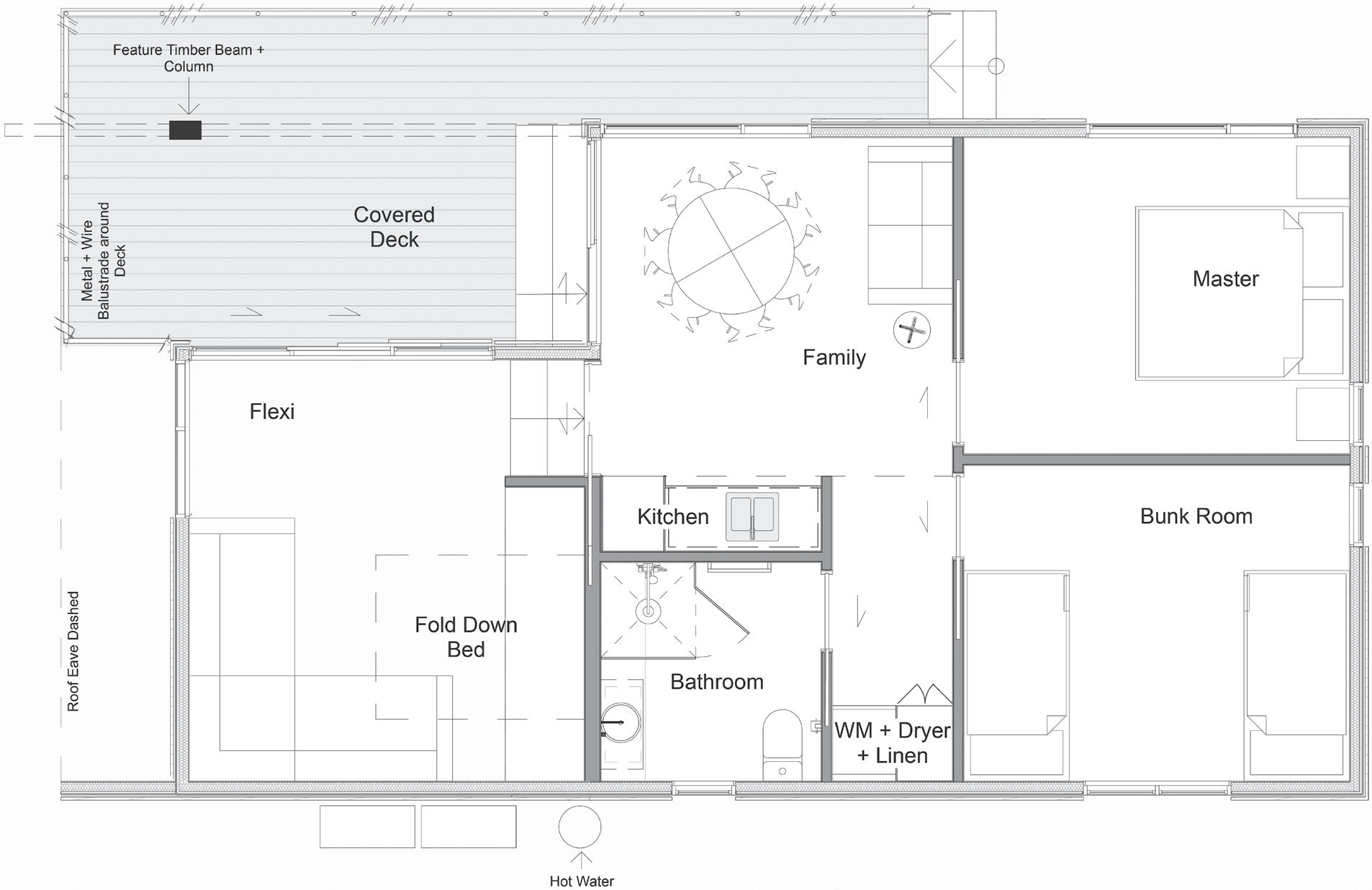
In 2009, when we began our company and called it 'Box'. It was a moniker that was easy to remember and playful –a name that caught the imagination and loosely referred to the idea of thinking about spaces as ‘boxes’ and how we put them together to create a home, rather like a game of Tetris.
Since then, we’ve evolved and pivoted as a result of our customers’ feedback and needs. So, while we’re often recognised for an aesthetic that can be termed ‘boxy’, our portfolio includes a range of styles. Here are some we think you might like.
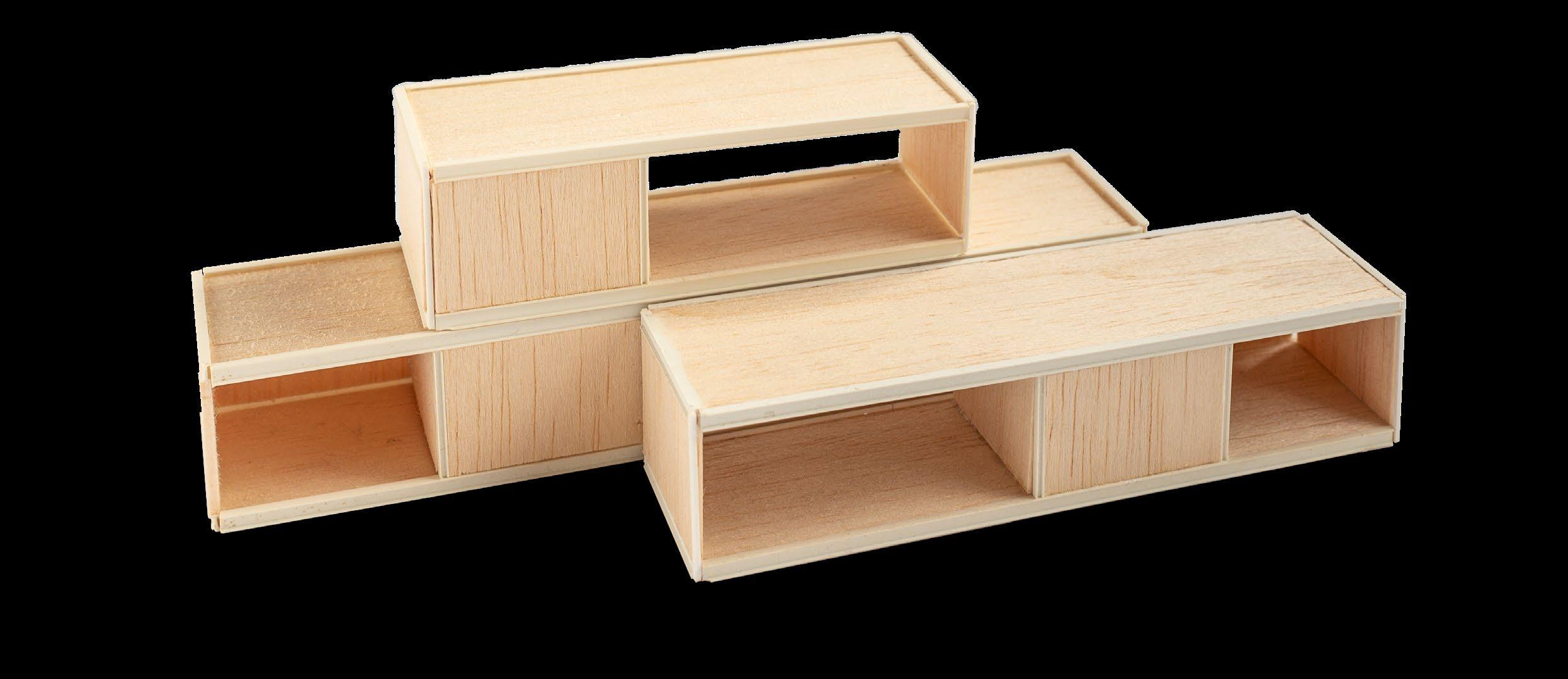
Jane and Peter's home. Often our homes, clearly contemporary in design, can be identified as the new kid on the block. Not always though. In this instance the owners, nature lovers who had holidayed here on the Tāwharanui Peninsula for decades, wanted their new place to blend with the environment. Its shape mimics that of the big old barn that already existed on the property, and which served as makeshift accommodation during memorable family excursions. The simple gabled pavilion is clad in vertical shiplap cedar,
dark stained to be low-key on the hillside. It has an iron roof and glazing to grab the views (of the sea and the bush-blanketed slope). Inside, exposed trussed and a concrete floor sport an agricultural attitude, a robust simplicity that makes this home feel rustic. Decks north (facing the hill) and south (to the sea) double the chances of comfy outdoor living. Small (116-square metres) and subtle in its context, this modern barn looks like a long-standing part of this rural/coastal enclave.

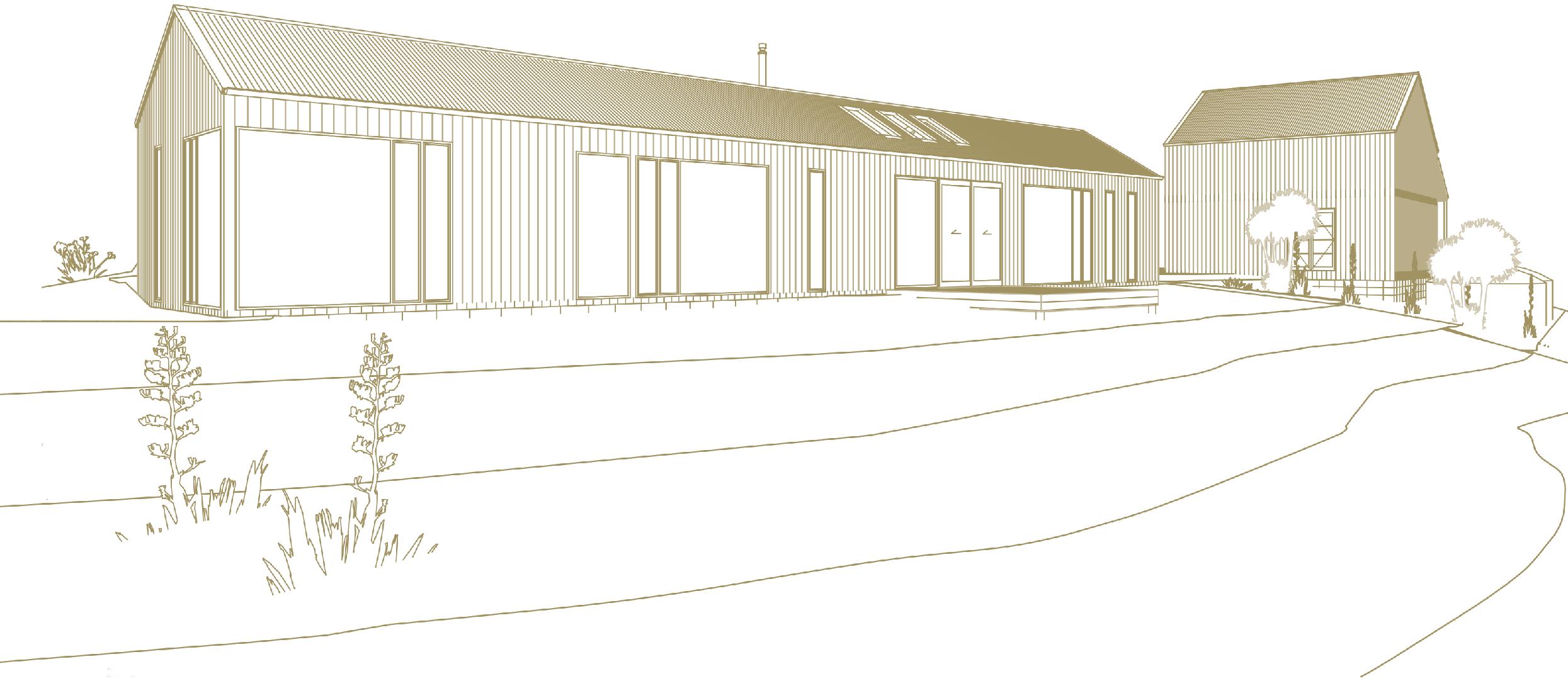
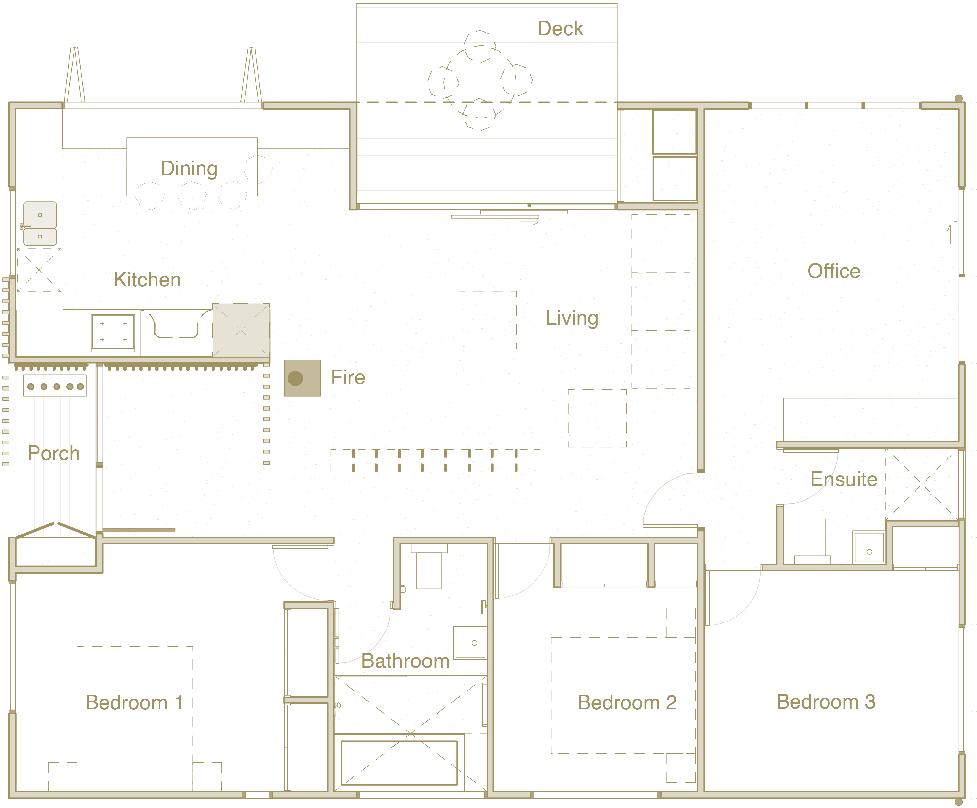
Ali and Ben’s home. With an architectural backbone of California modernism that has stood us in good stead, we aren’t particularly known for our gables, but this Onehunga house for a young family called for exactly that approach. The reason the clients came to us too, was slightly different. They had their hearts set on renovating the villa that once stood on this site, but when the costs came in, they realised starting from scratch was a better value proposition.
Their new home with its two-tone gable is everything that beloved villa is not. It has an open-plan programme useful for keeping an eye on four lively children, natural light floods in from morning until night, and it grabs as much of the view of the harbour as possible. But the best part is – the generous gable which is cut away to form deep eaves extending from the living room. This may not be the rectilinear, flat-roofed style of the modernists, but it still delivers huge indoor/ outdoor living.
Liz and Dot's home. One of our earliest clients broke the mould of post-and-beam houses that Box™ was focussed on at the time. In 2014, the same year we received an architectural award from the NZIA for a project in Wellington in the Small House Category – a 115-square-metre cube-upon-a-cube that the judges said proved that “cost effectiveness need not be predicated on the mundane”, we were working with West Auckland clients on a tight budget and a compact infill site. Height-to-boundary requirements meant a gentle gable was key to keeping within parameters without planning permission. So, we changed tack.
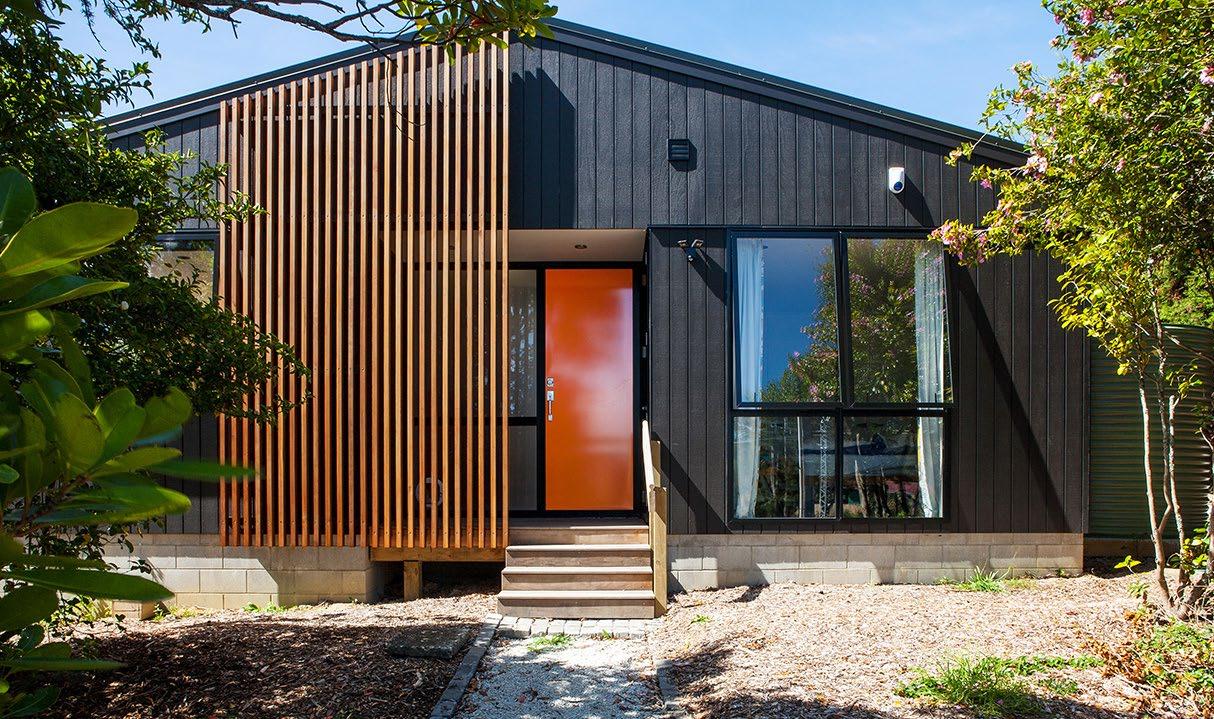
This design features less of our go-to methodology thinking from that period – no post-and-beam, no stainless-steel bracing – but we pulled out the stops to create an affordable home with a dash of flair (the built-in cabinetry and bench seating, and the timberslat entry screen are some notable twists). It made us understand that, despite not following the big-picture format, cherry-picking aspects of mid-century design was enough to elevate the end result. Its simplicity, attractiveness and functionality ensure it’s still one of our favourite projects.

Terri and Sam’s home. Having a kitset of tools, including a well-researched, somewhatdefined material palette, is not only pragmatic and cost-conscious, but has also allowed our built repertoire to hang together as a whole. And then you encounter clients who have firm ideas on the material make-up – and so you need to adapt. Box™ is not known for its use of brick (timber or engineered timber is our standout choice), yet brick cladding is enjoying a return to favour. You need only drive around the streets of the city-fringe suburbs of Auckland to see that architects are choosing it to reference the old brick buildings that once populated these streets. This Glendowie couple had other reasons. One had grown up in a red brick home, and the first home they owned together was a redbrick ex Statie. San Selmo’s ‘Aged Red’ brick, from The Brickery, is a tumbled, hand-poured product that makes it look rustic and reclaimed. Pairing it on the garage with pale Abodo timber weatherboards treated with a natural wood coating called Sioo:x gives this double-storey home a unique aesthetic. The red-brick wraps into the interior and carries up the stairwell to bring warehouse-chic to the spaces – and capture the owners’ personal sense of history.
Anna and Tom’s home. Those familiar with Box™ houses will know that they have a somewhat recognisable aesthetic – a modernist flavour with a street presence that comes from strong, confident design. This family home, in rural Pukekohe is a little different. Built on a sloping section, the entry elevation is low-key: in fact, as one of the owners describes it, “it looks like a very boring little house”. Far from it, of course. The planning uses the slope of the land to good effect. Down a set of stairs from the front door, the house opens up into a large, centralised kitchen, the raked ceiling soars up to 4.2 metres and a covered outdoor room occupies a void cut out under the roofline. At 170-square-metres the house is still on the small side, but its humble on the outside, expansive on the inside personality means its more than enough for a family of five.
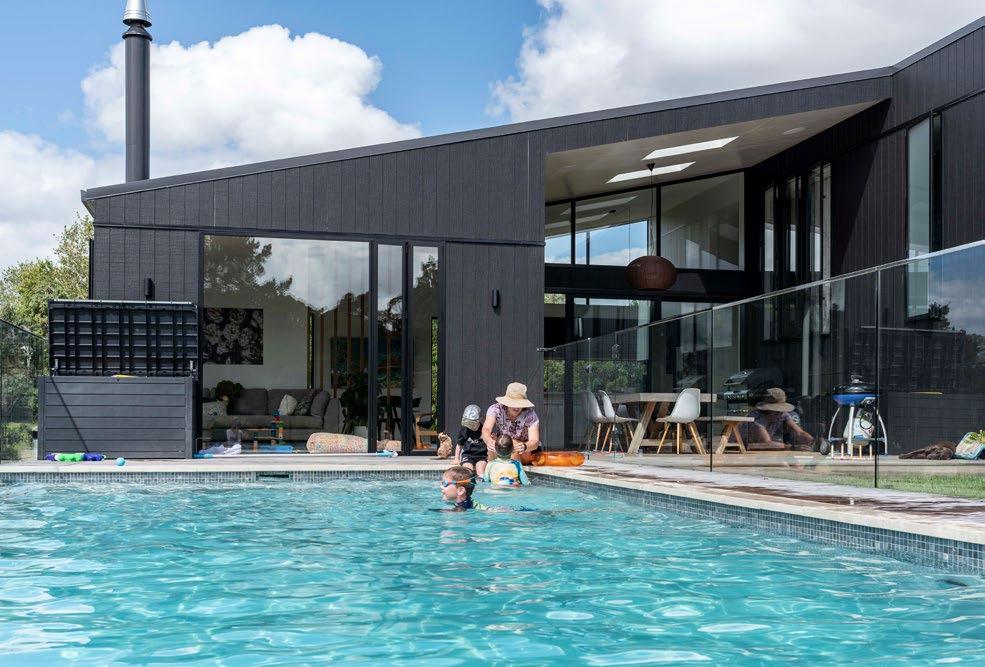



Gable roofs have been around since the ancient Greeks used them to protect their temples (The Parthenon is just one example) and only the evenmore-ancient Egyptians, who invented hip roofs – a precursor to the gable –could be considered to have spawned a more enduring architectural feature.
Watch any child draw a roof and they’re unlikely to produce a monopitch. They’ll tend to go for a gable. It’s sublime in its simplicity, which is why the beloved gable spans not only houses, but continents and epochs. That was until it met the California modernists. Suddenly it was no longer hip to be a gable. It was far more fashion forward for the roof to float out dramatically over the walls,
creating generous eaves and giving the appearance of being flat. The singular slope of the monopitch roof is as much a trademark of mid-century design as fullheight windows and open-plan rooms. While Box™ has become known for such rectilinear forms, we still believe in the geometry of the gable. One argument to take this angle (if you’ll excuse the pun) is their tried-&-true performance. But a cheeky pitch – the A frame being the most extreme example of such, where roof becomes walls – can have notable aesthetic impact. And there are many ways to tilt and turn a gable to modify and modernise the traditional form.
Over the years, we’ve designed and built numerous homes that give the gable a good outing. Here are a few we love.

If you’re gonna go gable, you need the perfect pitch. A roof tends to be define the exterior appearance of a dwelling so, while it needs to be practical, it should also look the part.

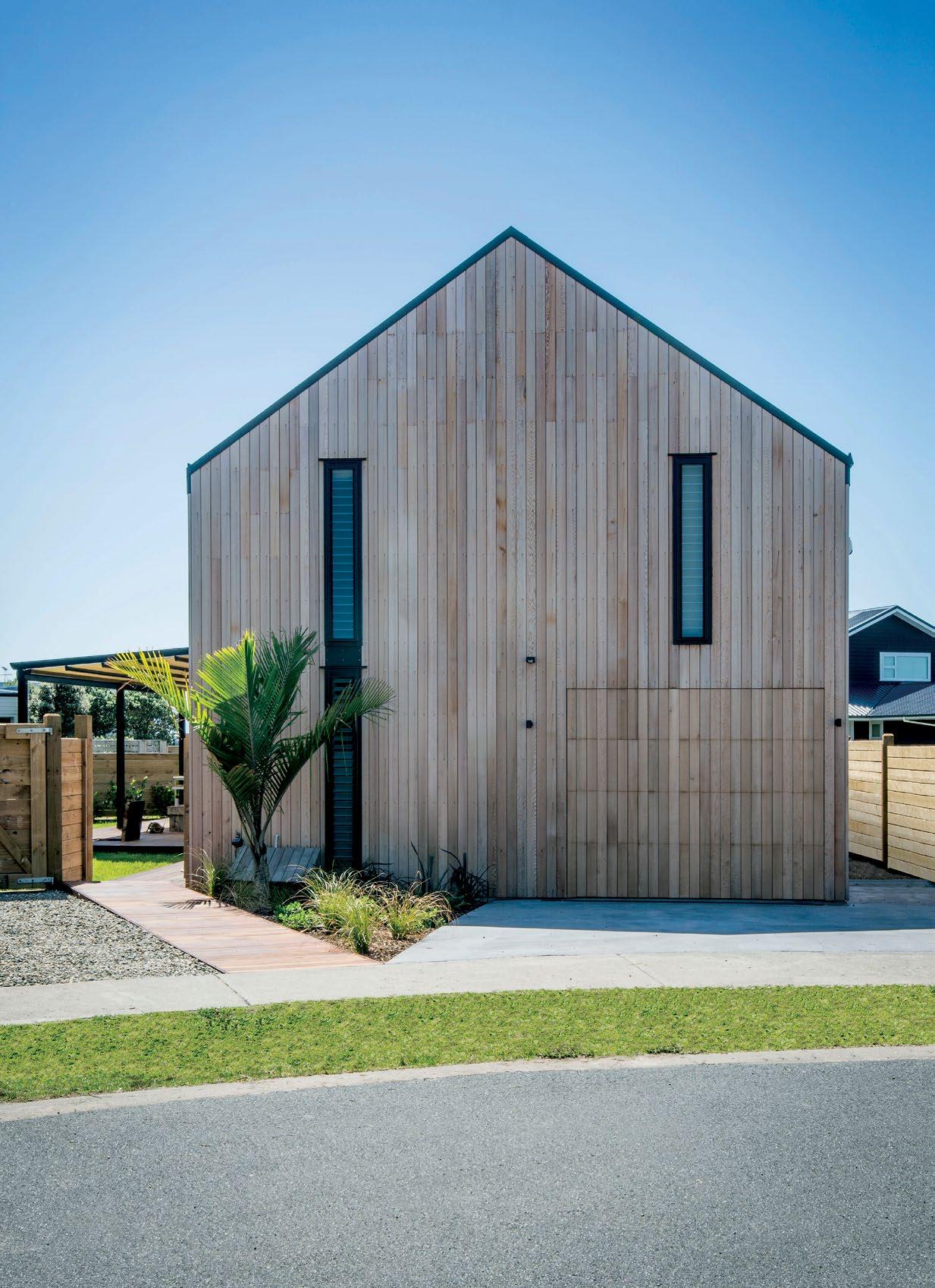
The majority of Box™ roofs are in long-run metal; you won’t find many clay tiles or shingles. So, it’s with colour and pitch that the roof can make a subtle or stand-out statement. Renowned English architect Sir Edwin Lutyens, known for designing grand country houses, is said to have termed the traditional 45° pitch as ‘the ugly angle’. He preferred his gables steeper. At Box™ , we fit the gable to what’s on the table. We take performance factors (such as if it is in a high wind zone) into account, along with how the roof will present.
One little beauty that’s a favourite - perhaps because the gable is steeper than most – is this holiday home in Omaha. The jaunty pitch makes it feel like a modern cottage and the gable end that faces the street is pared back, with a garage door veiled into the uniform timber cladding. Inside, a mezzanine tucks in beneath the roofline and the angularity of the ceiling lends the upstairs bedroom and bunkroom the cosy character of an attic.
Take a bite
Inspired by childhood memories, red brick was a must-have in the material palette of this Glendowie house, built for a family of four. The decision was made to use brick to clad the lower level, a form that runs on an east-west axis across the site, while using vertical Adobo timber weatherboards in natural tones to offset the solid horizontality of the brick on the north-south axis.
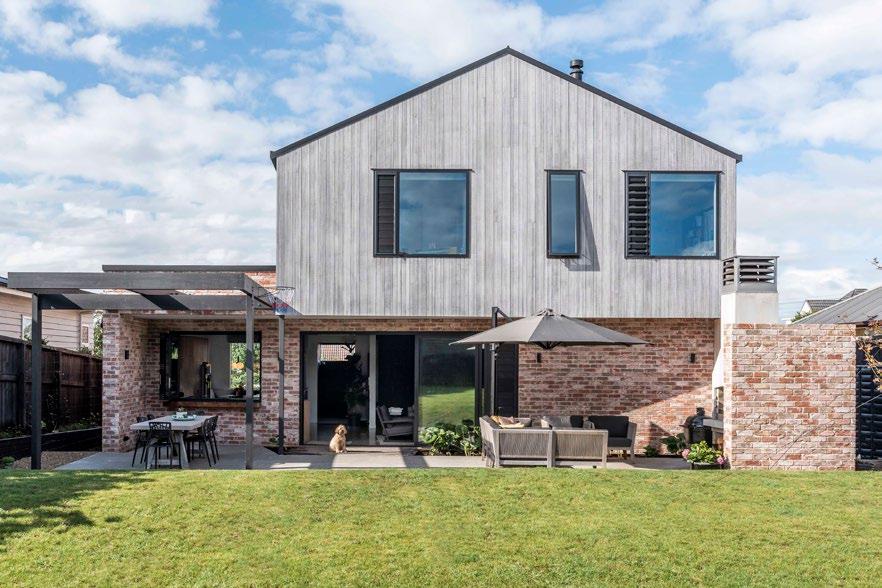
To the west of the site, a carport (disguised as a garage, behind a door) takes a bite out of the rectilinear plan, and the upstairs bedrooms wrap around this void. It means that the gable roof to the rear, overlooking the north-facing garden, is a traditional triangle, but the one street side is a half-gable: it’s missing its mate.
This breaks up the massing of this two-storey house making it feel friendlier to the street. Dark-toned roof flashing contrasts the pale timber – a trim that is crisp and elegant.
Built on a small suburban site, this gabled house punches colour into its neighbourhood through a bright-orange front door and internally, punches above its weight, feeling far more spacious than its 88 square metres.
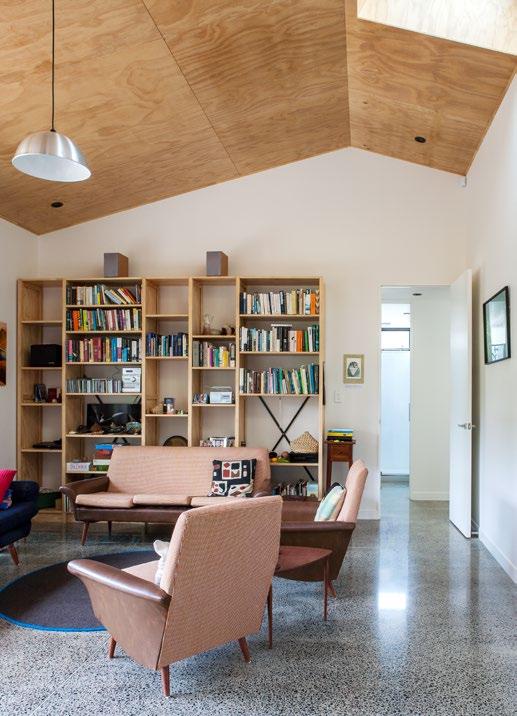


From the front, a gentle-angle gable teams seamlessly with darktimber cladding; it feels almost barn-like. The addition of a privacy screen in cedar adds interest to the face and a concrete-block base grounds the dwelling in an industrial aesthetic.
But it’s beyond the colour burst of the front door that the gable works its magic. A sloped ceiling rises at an angle to follow the roofline bringing more volume to the living spaces of this compact home. Lined in ply, the ceilings reinforce the nod to a barn while a dropped ceiling above the kitchen area serves to differentiate it within the open-plan scheme.
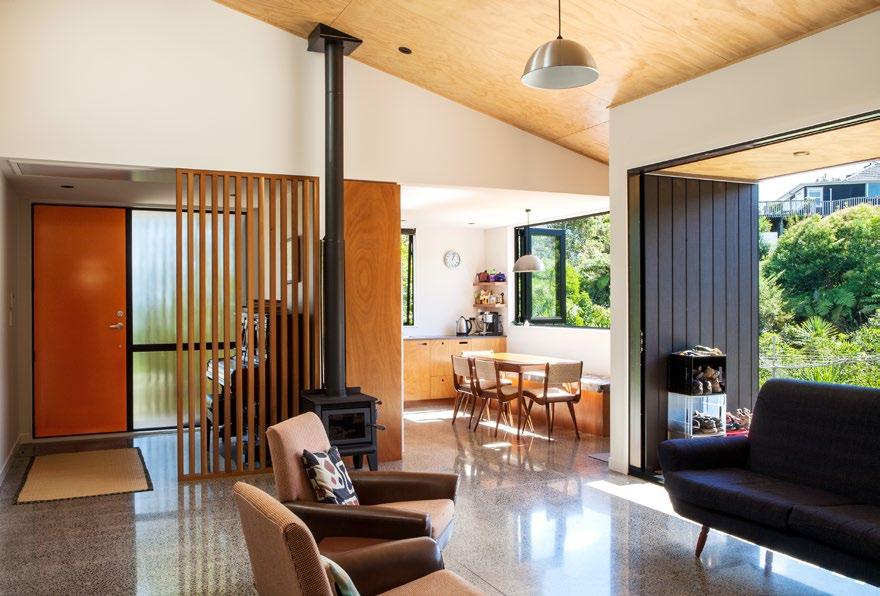
Pavilions were once semi-permanent structures found in the middle of posh folks’ gardens and used for glamorous summery occasions. But the way we live in Aotearoa lends itself to permanent pavilion architecture and this holiday home at Baddeley’s Beach, perched between the sea and the bush, is a good example.
In this modern take on the pavilion, a linear plan beneath a classical gable is simplicity itself. The silvery tones of the longrun-metal roofing are a low-key foil against the sky and a backdrop of native foliage.
Inside, exposed trusses in the living zone triangulate into the gable to set up a structural rhythm and clerestory windows on the end above the kitchen bring in yet more natural light. Full-height glazing opens the building to the landscape to create a contemporary pavilion with a lovely lightness of being.
The owners of this property overlooking the Manukau Harbour were already sold on the beauty of the gable when they approached Box™ to craft them a forever family home. This new build was to replace the cold and draughty bungalow they’d been living in, since renovating it had proved clumsy and costly.

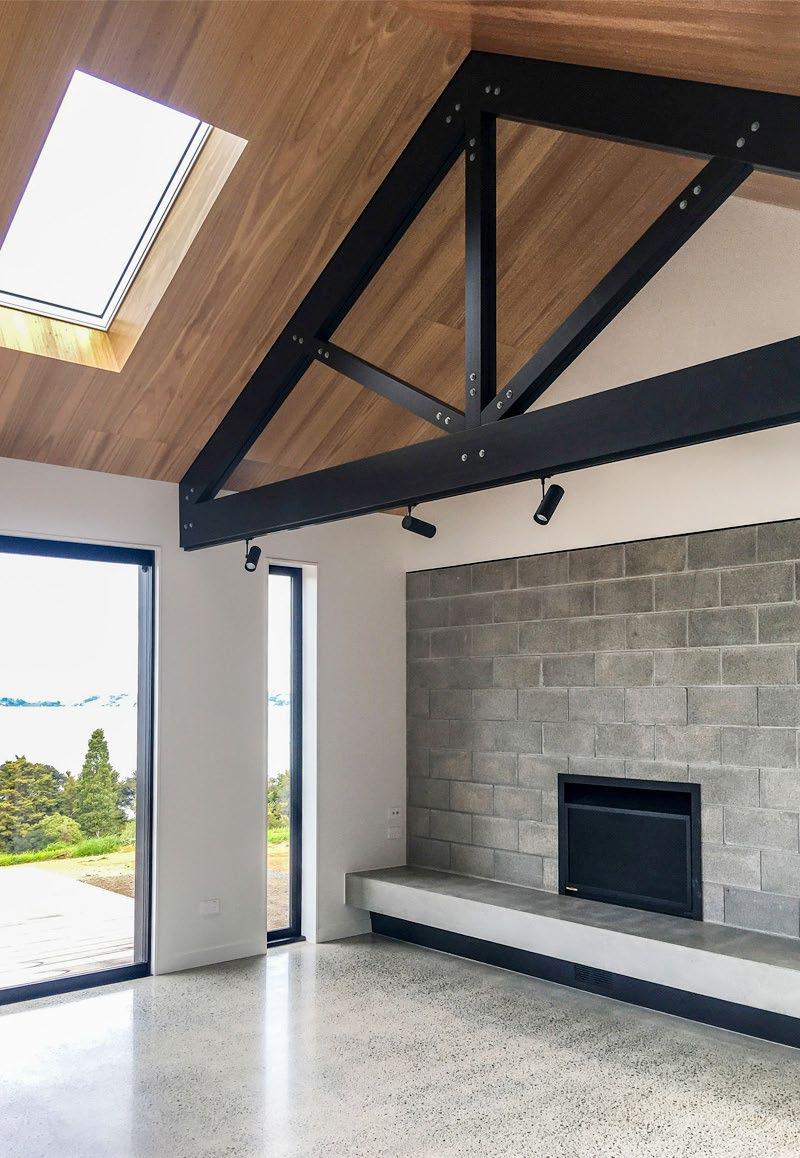

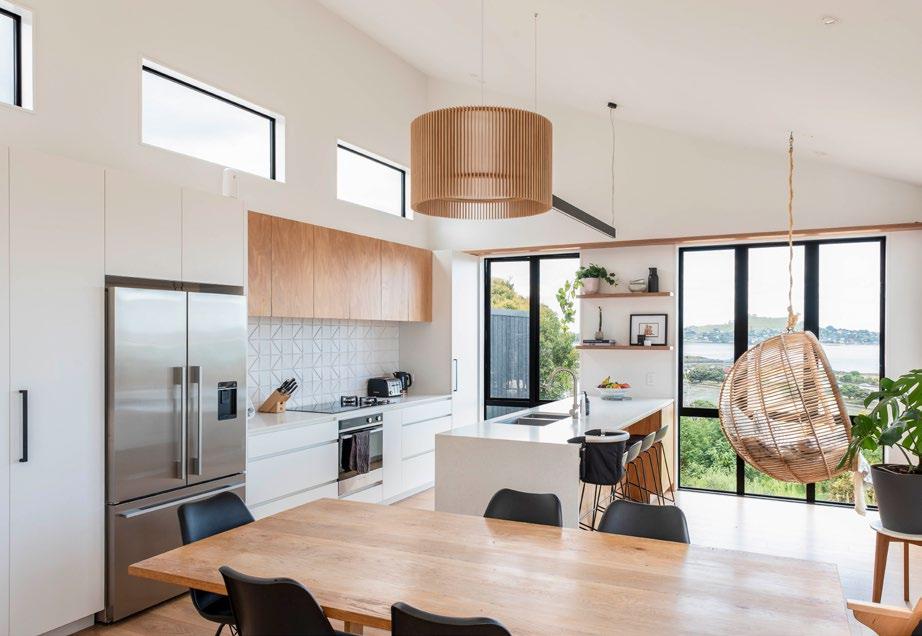
The result is a gabled dwelling that works hard for the couple and their four young children. The gable end is clad in Abodo pine stained to look like cedar and combines with dark-toned Weathertex to create a two-tone exterior that has interest, modernity and visual warmth.
Inside, the gable is expressed in lofty ceilings and on the eastern elevation Box™ included high windows for morning light to flood in and gently rouse the occupants.
To the north on one side, an outdoor room has been cut out of the symmetrical form of the dwelling. Covered and sheltered, it effectively extends the living zone by several metres and is the perfect place to hang with the fam in all sorts of weather.
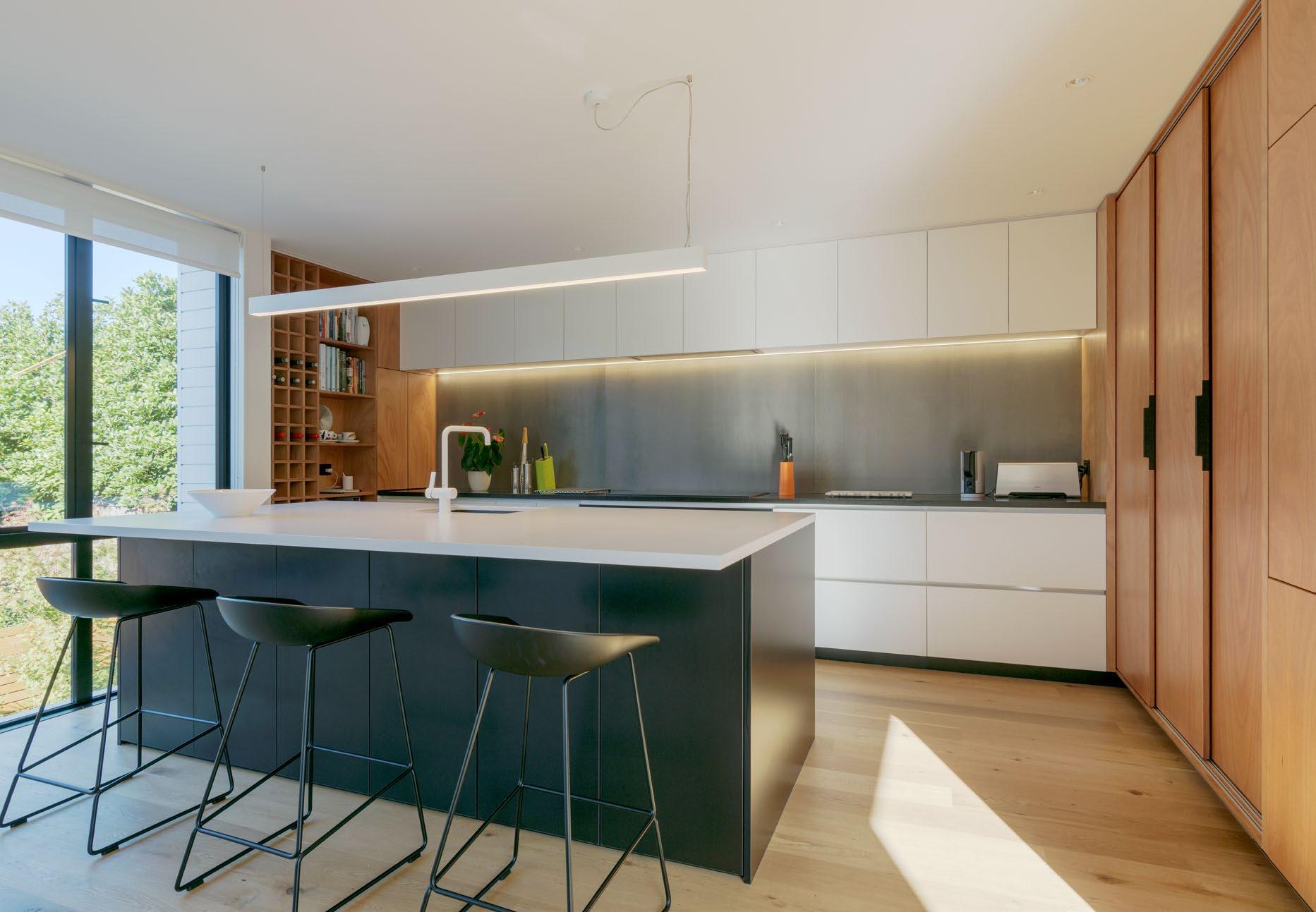
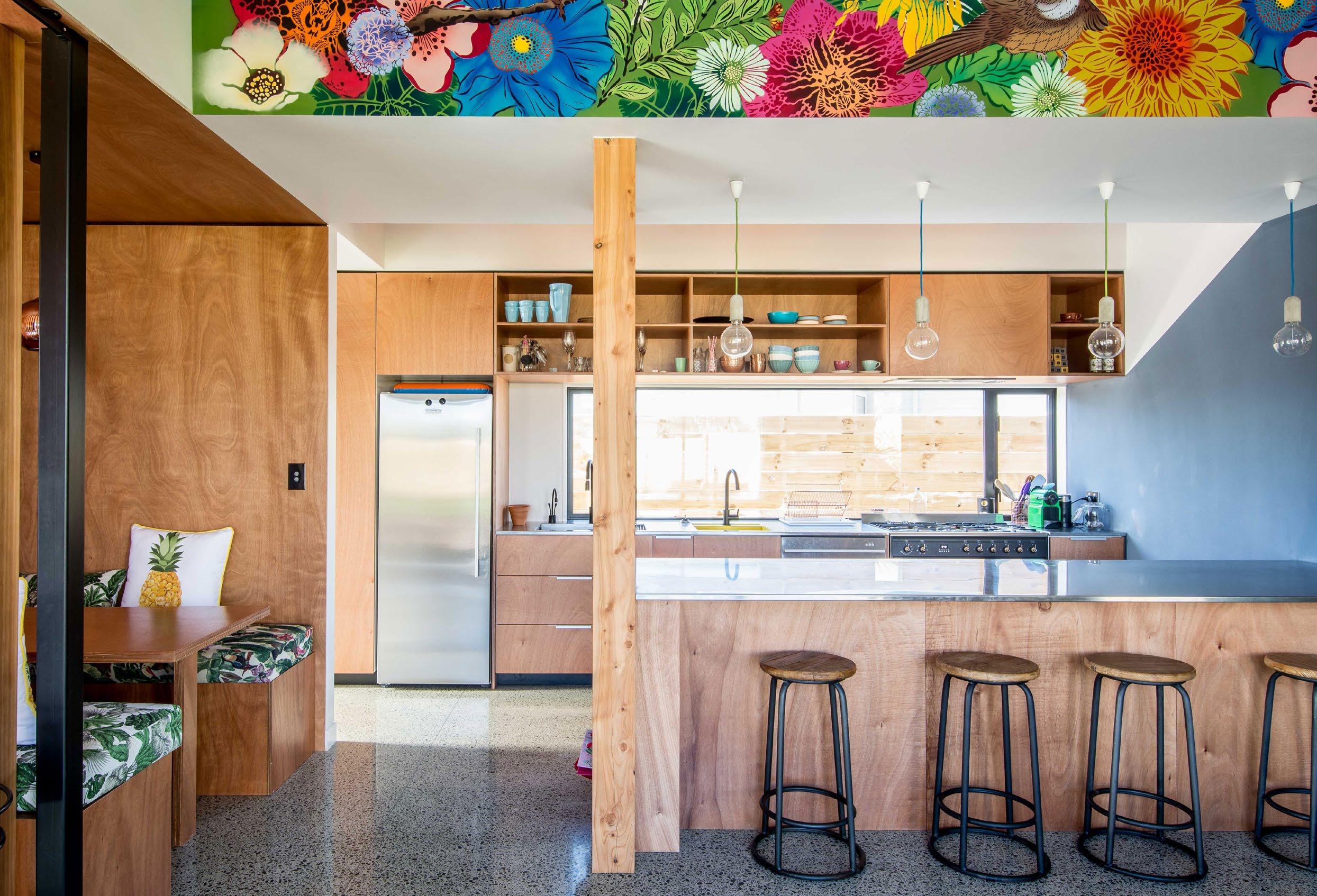 ABOVE Simplicity and openness define this coastal home in Omaha.
ABOVE Simplicity and openness define this coastal home in Omaha.

Tim:
"Tell us a bit about the relationship, how long have you worked with the Box™ team?
Sam:
"We first worked with Nat J on a project in Herne Bay way back in 2010, around about the time I think Box™ was being born. Our first collaboration with Box™ was for a house addition in Lambeth Rd in 2014. We also provided bespoke cabinetry modules for Box™ office fit out in 2015. We have now been involved with over 44 Box™ projects, so have a great understanding of Box™ ’s way of working and expectations.
Tell us a bit about your business and what makes it amazing?
Our business specialises in the fabrication and installation of high quality custom cabinetry. We don’t provide an in-house design service, as our main focus is bringing to life designs from architects, kitchen and interior designers and build companies. We focus on what we’re best at, which is high detail, quality craftsmanship. We work with companies like Box™ during the design stage to help them understand what can and cannot be achieved and of course, an indication of what things cost!

Do you have a favourite home build project, and why?
There are so many! We are fortunate to have been involved in so many special projects over the years. However, there is one project that stands out… I love the house at Patiki Place, Omaha: the simplicity of the design/ barn style, the materials used, and the feeling of openness/ volume inside, created by the open voids between the ground floor and the first level.
What current trends are you seeing among clients?
Fluted panels, battens and curved elements seem to be on-trend at the moment. This adds to the wow factor, but also to the budget, due to the fairly heavy labour content in producing them.
Any particular products you use and are really keen on at the moment?
We are seeing more and more “prefinished” panel products being used for cabinetry, for example, pre-coloured and coated timber veneers, and plywoods with high pressure laminate surfaces. Also, with advances in edge finishing, such as laser edging, we are increasingly using materials
like acrylic panels, which are great with their anti-fingerprint, anti-scratch and heat resistant properties.
Any tips to future clients to make their builds easier (and cheaper!)
Easy… use us! Seriously, one of the benefits of working with Box™ is that they involve us in the process to ensure that designs are practical and cost-effective to build.
What future plans do you have for your business? "
We have just recently moved our operations out to Riverhead. We plan to just keep doing what we are doing, which is to provide excellent service and do the best we can to support the businesses we work alongside. With over half our team coming from a background in the marine industry, at some point we would look forward to maybe getting involved in some marine based projects again. But for now our bread and butter is in residential cabinetry fit-outs, and we are all really proud of the quality of product we produce."
To learn more please visit: dockside37.co.nz
Small-home design is big news these days. A generation priced out of the real estate market has seen to that. It kicked off with the tiny house movement, morphed into a love affair with freedom courtesy the ‘van life’ brigade and even hitched up to our holidays where glamping became a glamour choice. Even if you’re not convinced of these extremes, building smaller is an authentic aim, not only because it is more sustainable for the planet and kinder on the pocket (in terms of initial outlay and in ongoing energy efficiencies) but because it’s NOT a compromise. Fewer square metres of floor area often mean that more money can be spent on quality design and materials which is why smaller-space living can be chic.
Text Claire McCall Images Box™In 1980, the average size of a New Zealand house was 148 square metres; by 2010 it had leapt to 209 square metres. That’s when sense prevailed, and New Zealand turned a corner. According to Statistics NZ, the median floor area of new homes in Auckland decreased by around 60 square metres between 2010 and 2019. Of course, although most of us agree in theory that smaller living is a worthier option, in practice we don’t want to feel hemmed in and claustrophobic. Thoughtful design makes all the difference. Here, Sophie Bishop, a project architect at Box™, shares eight ways we make smaller spaces feel larger.

Open-plan living may be old hat now, but this mid-century modern introduction has lasted the distance because, deleting the walls between the kitchen, dining and living areas, allows fluid spatial flow - a ‘single’ room feels more generous than the sum of its parts and can be defined as ‘separate’ spaces by using colour and material transitions, along with differing ceiling heights and floor-levels. Also, correct orientation on the site, means Box™ dwellings are better placed to offer shelter from the wind and access to the sun in winter. New Zealanders love their alfresco activities and with the thoughtful activation of external spaces linked to the open-plan living through, for example, big sliding doors means the outdoors becomes integral to the internal landscape and can be used for a large portion of the year.

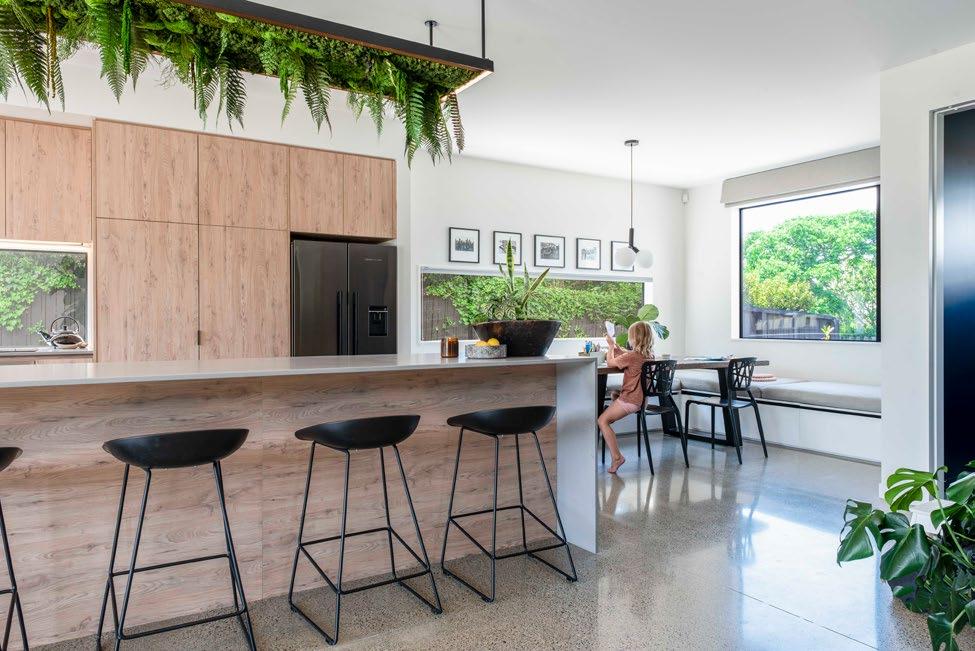
Proportion is integral to good design so, while most group home builders offer a 2.4-metre stud height as standard in living rooms, at Box™ our standard for these rooms reaches up 2.7 metres. Couple this with window and door joinery that stretches all the way to the ceiling, and that’s an incredible lightness of being. We also tend to extend the kitchen cabinetry to the ceiling which streamlines the design for a calmer, roomier state – and you never have to dust the top of the cupboards!
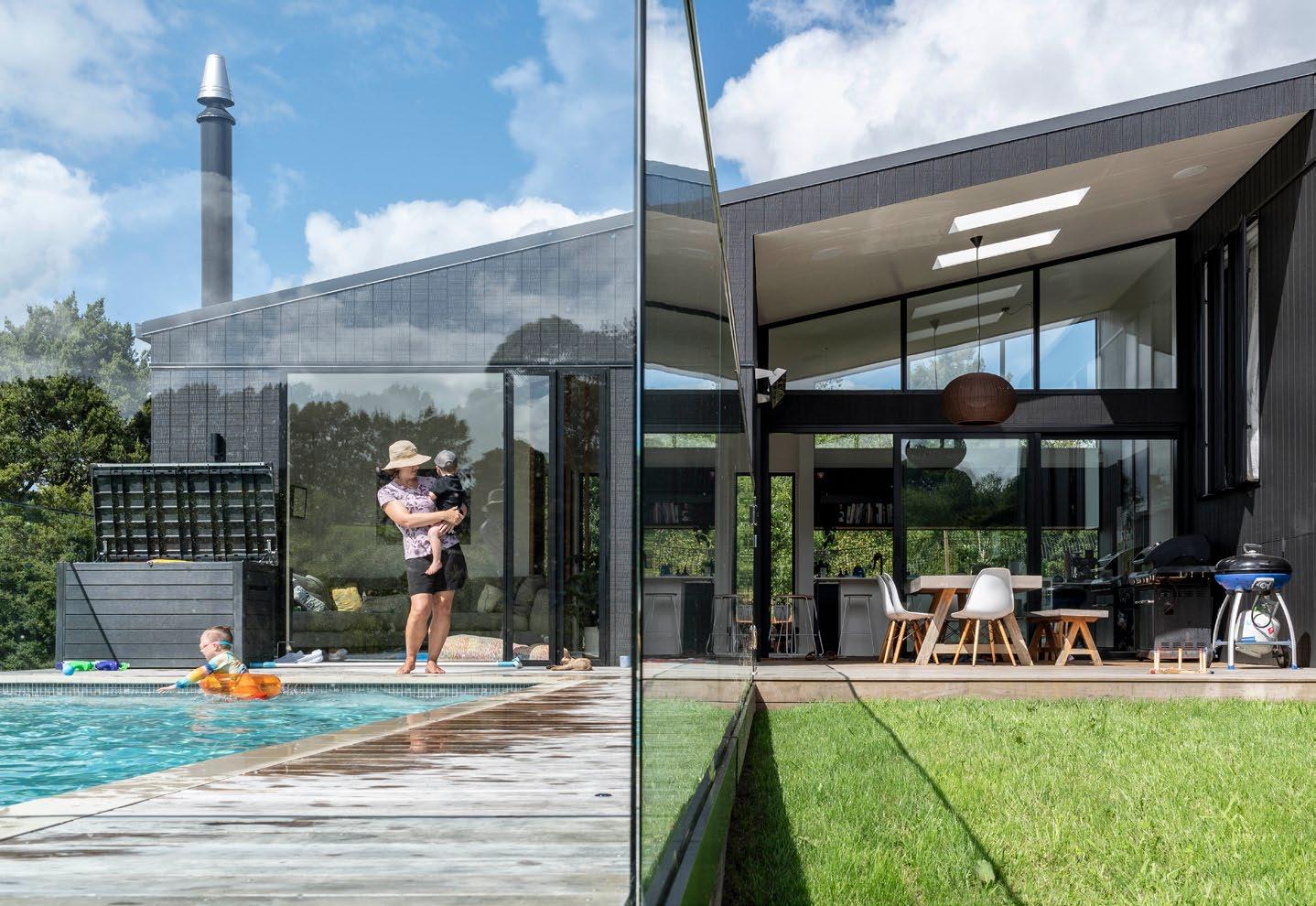
Swiss-French architect Le Corbusier was an exponent of natural light and its ability to enhance emotional wellbeing. He said: “Space and light and order. Those are the things that men need just as much as they need bread or a place to sleep.” While it is nice when the view shafts and natural light qualities are aligned on a site (eg when that view is north-facing), at Box™ , we make full use of clerestories and skylights to grab as much light as possible, no matter which direction it comes from.
In the 1960s, most homes were crafted with a central hallway and rooms leading off this, yet circulation zones such as this don’t tend to augment a feeling of spaciousness. It’s far better to prioritise more metreage for living than include an auxiliary space. A practical floorplan means the Box™ programme takes in the way you actually use the home rather than subscribing to an outdated precedent. For example, do you need three bedrooms if the children have already flown the coop? Instead, why not integrate a flexi room into the living area which can convert to a bedroom if needs must. Our advice is to keep the bedrooms compact unless you spend a lot of time in there. At Box™ , a standard secondary bedroom is a functional 3.6m x 3m – a size that can readily accommodate a queen-sized bed, bedside tables and a built-in wardrobe.
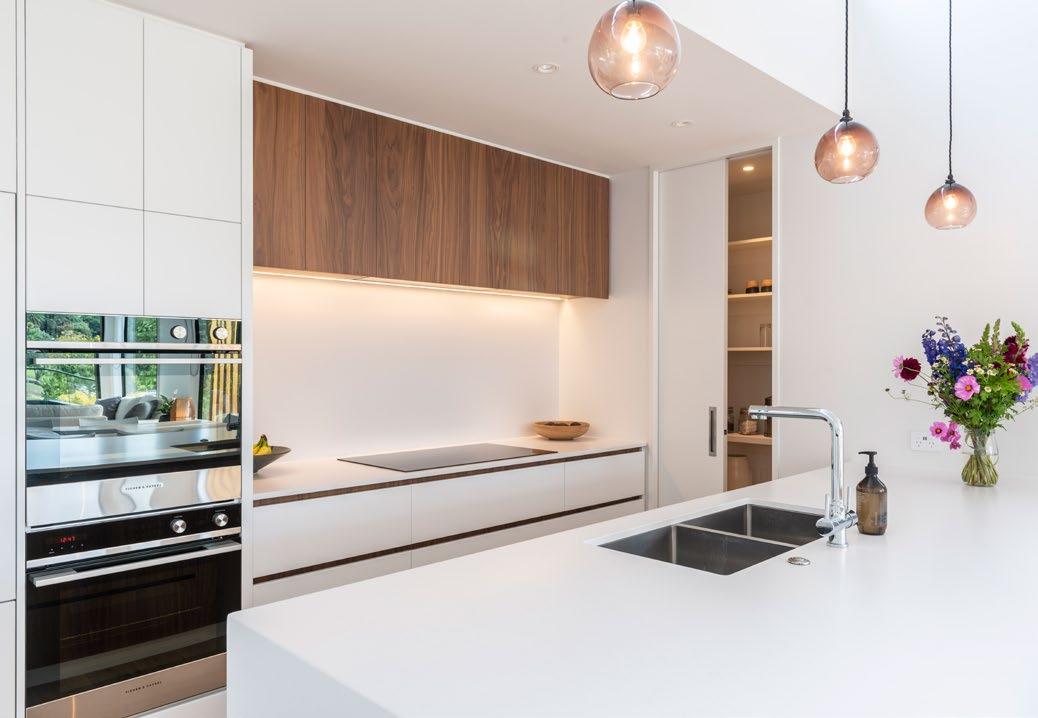



You may need to let go of firm ideas. While a scullery allows a clutter-free benchtop, which always bolsters the room-to-breathe impression, this can also be achieved by a hidden scullery cupboard built over the benchtop so that small appliances which are in high use, such as the jug and toaster, can be hidden from view. Also, if you’re building smaller, consider the ‘need’ for an island bench. Either simply use your dining table as extra bench space (works particularly well in country-style kitchens) or incorporate a dining extension onto the island so there’s no need for an added piece of furniture.
Well-designed storage makes even the smallest dwelling more open and expansive. While planning your design alongside Box™ , find a place for everything (don’t forget the suitcases!). Built-in bench seating and window seats are among our favourite space savers – plus they provide storage. That’s a win/ win right there. On the same subject, don’t allow a double garage to become an expensive storage unit.
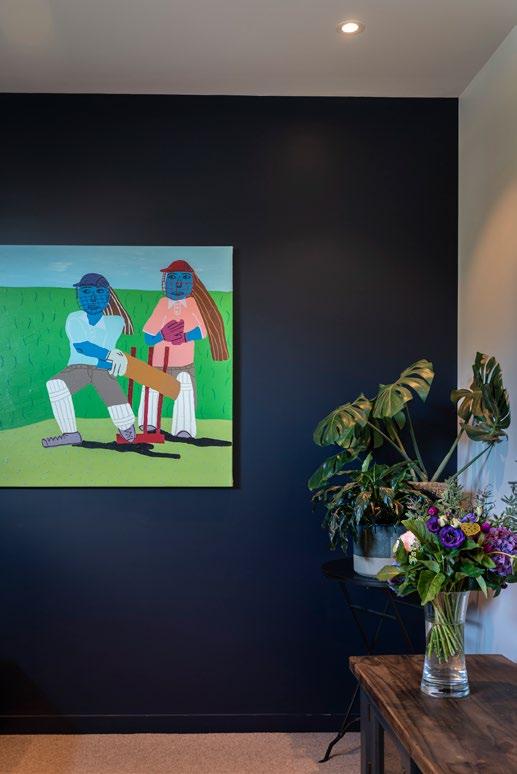
Architects love to play with spatial tension – the aspects of compression and release. This works at an emotive level and is often incorporated into the entry journey where the arrival zone is intimate and welcoming before, a few steps later, the main space expands to feel bigger and brighter. The very contrast amps up the volume. Decoratively, if you wish to give rooms a capacious touch, paint the ceiling a shade lighter than the walls.
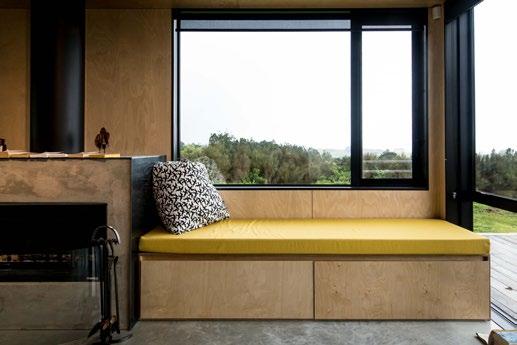
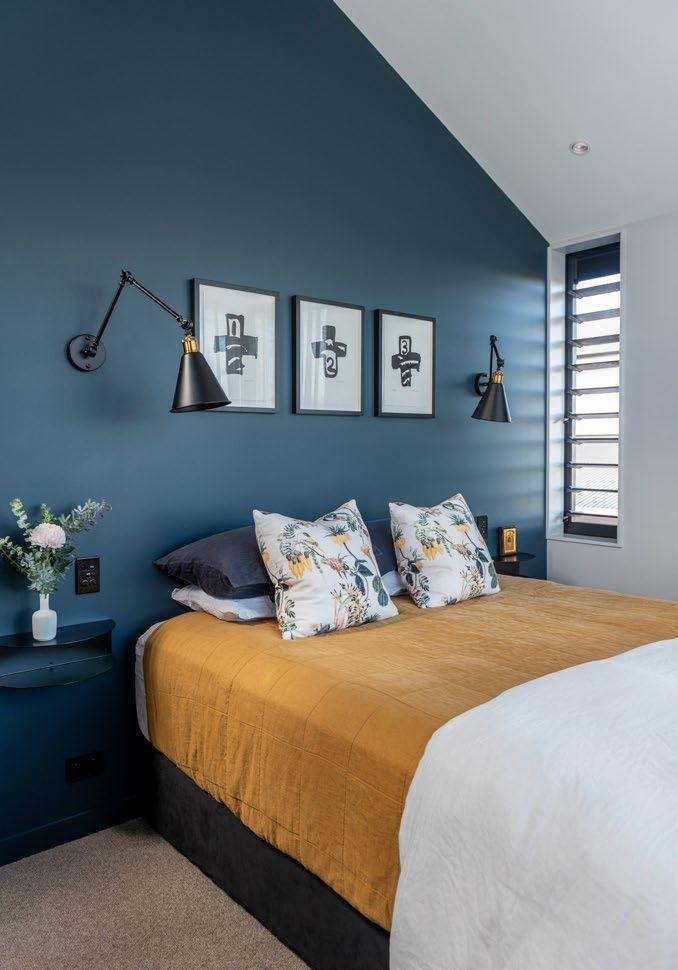
Finally (and perhaps we should have put this up the front of our list as it’s a subject that never fails to grab attention), remember that the cost of building has a close correlation to the square metreage. At Box™ , we advocate ‘right-sizing’ rather than downsizing – a carefully planned, compact dwelling that keys into, rather than compromises, your lifestyle.


Landscaping is so much more than just ‘doing the garden’ – in your new home, it’s a fundamental aspect of the architecture. Integrating landscaping with the design of the indoor spaces will guarantee you get the best from your site (large or small) and enhance your lifestyle and enjoyment of the property.

Landscaping involves a big-picture overview of the compositional parts: from where the driveway should be in relation to the dwelling, to the paths that make individual areas accessible, to where the water and electricity access is. It necessitates design thinking for essentials you may like to disguise (such as where the bins or washing line will be) and for other features that are set to become the heroes of the piece: for example, vertical structures which can provide privacy but also places for a celebratory creeper, and horizontal elements such as the ever-important deck (a Kiwi institution).
Once you have your landscape plan in place, you’ll be ready for the garden design – adding the plants that soften the hardscape into a living tableau – whenever that might take place. Keen to begin? Here’s our advice to ensure success.
It may be tempting to cut costs by not setting aside a budget for landscaping but, anecdotally, we can tell you that our clients almost always regret this. Add a little on to the mortgage to put in the structure while building; you can always fill in the tapestry with plants and outdoor furniture later. Typically, clients spend between $50K and $80k on this ‘hard stuff’: the decking, steps, pergolas that result in that much-embraced indoor-outdoor flow. Of course, the sky’s the limit. Add in motorised louvres, screens, fancy fireplaces, etc and your outdoor room can easily set you back $150K
The raison d’être of an outdoor space is to embrace alfresco activity but if that puts you directly in the line of fire of Mother Nature’s vagaries, you could end up with too much sun or an annoying wind that takes the enjoyment out of it.
Orienting the building so it shelters you from the worst of these elements is a key part of the mitigation strategy. Classic plans such as a U or L-shaped footprint can ‘cuddle’ a courtyard, protecting it from the worst of the weather.
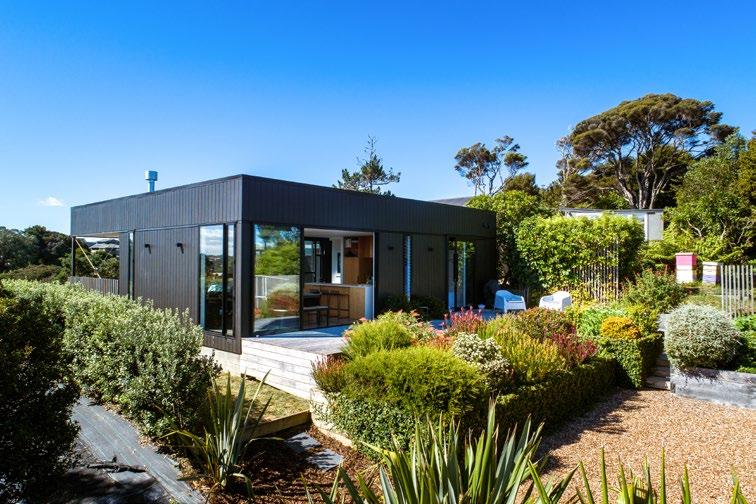
On the north and west elevations, overhangs (such as deep eaves, or cantilevers or balconies) can be designed to give shelter from the sun with the bonus that this negates the need for an outdoor umbrella or a pergola.
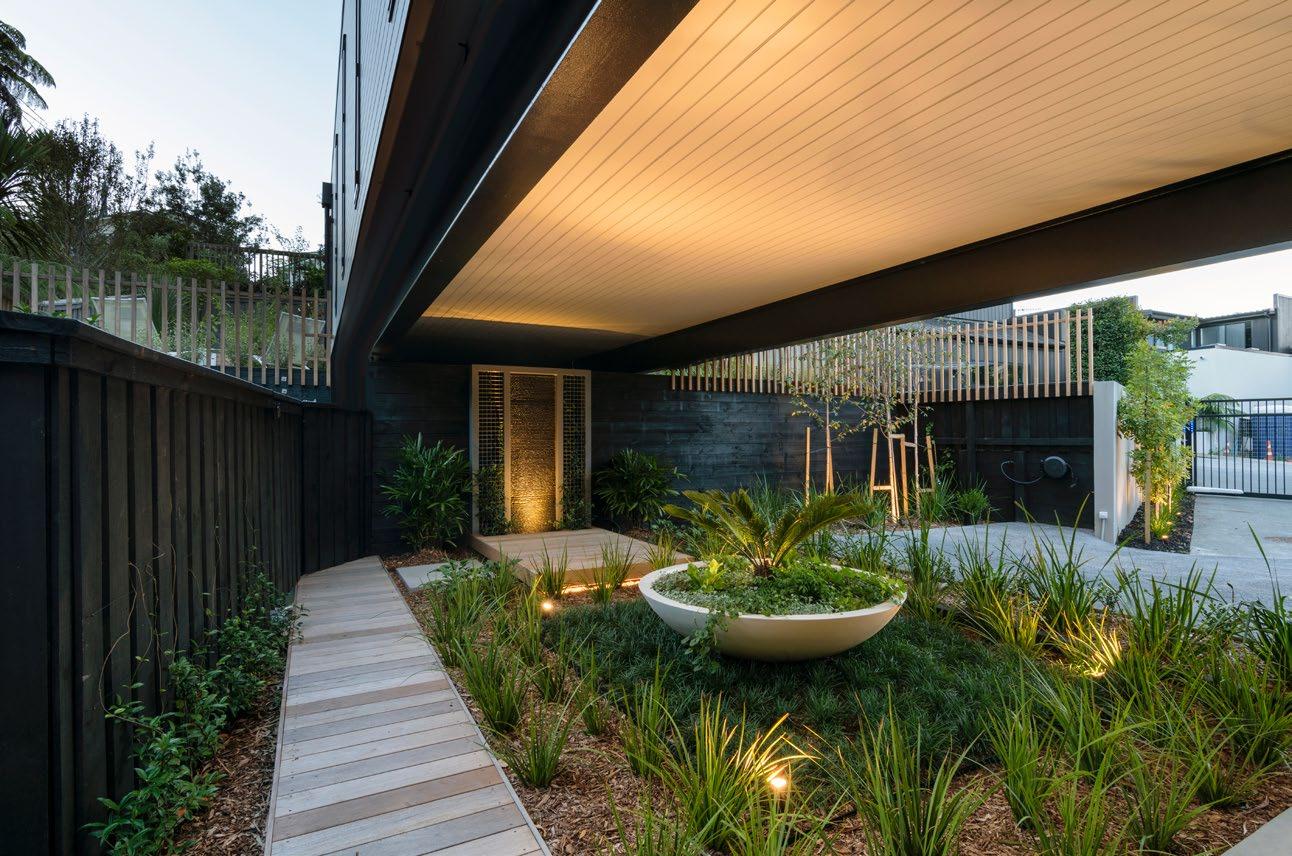
When it comes to acing the outdoor action, options are your BFF: spaces that allow you to move according to the whim of the wind and the passage of the sun. In the perfect world, we’d include an east-facing decks for morning coffee and breakfast and a west-facing one for evening entertaining, but if you’re in a location where Norwesterlies prevail, a south-facing spot, ordinarily not high on the priority list, could be just the ticket.


The first thing a Box™ designer will ask you when you are discussing your landscaping is how you like to use outdoor space. Are you a keen gardener? How much do you entertain? Do the outdoor spaces need to be geared to young children or teenagers? But there are so many other questions to be answered. What about the future – how could your life and ability to get into the garden change? In a holiday house, what is practical? Remember to not only put thought into the glory spaces but also those little areas that, if well-planned, will make everyday life so much more comfortable. Do you need a dedicated place for a shed? Will a lawn become too high maintenance? Can stairs double as seating? Now is the time to consider how hard or soft landscaping will give you privacy from neighbours. Now is pertinent to ask whether you really have time for a built-in raised vegetable garden. If a pool is on your wish-list, the considerations become even more intense. It’s not the type of thing that should be installed retrospectively and safety regulations need to be adhered too (finding the right fencing solution often takes some doing).
The time is also now to contemplate your energy needs: the hot water cylinders, compressor unit of the heat pump, batteries for solar power that are positioned somewhere outside the dwelling whether it be in a separate utilities shed, the back of a carport or in a fully fledged garage. Once you start to think about it, you’ll soon realise the landscaping plan needs to incorporate so much more than just a place to enjoy summer beersies with your mates.


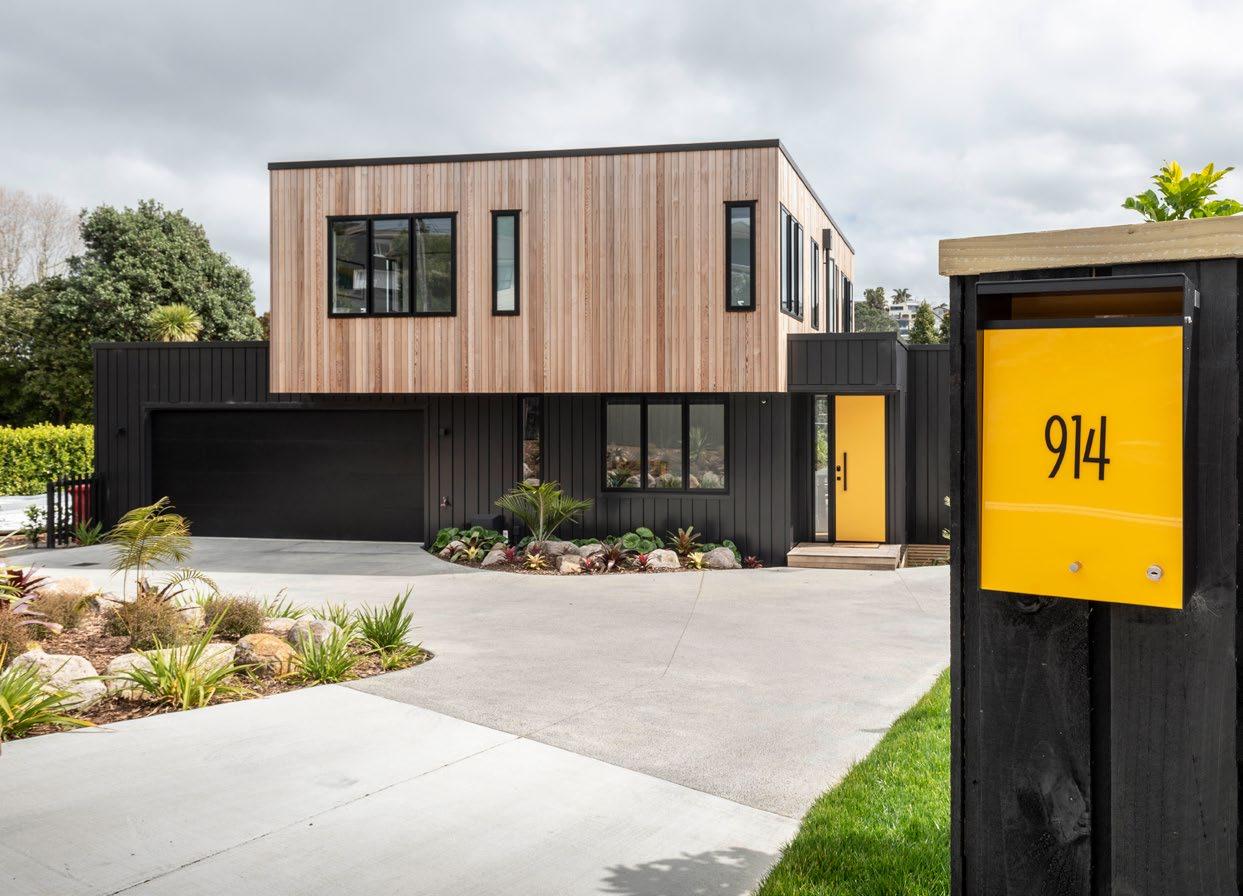
Okay, we acknowledge you’re probably going to build a deck - and that fits really well with our modernist-inspired designs - but we feel compelled to mention that there are other options. A paved or bricked patio, perhaps interspersed with hardy groundcovers, is highly durable and requires less maintenance (no oiling or staining) and looks great with a contemporary aesthetic in an urban setting.
Rural properties, on the other hand, could suit a gravel courtyard. It’s one of the cheaper options, has permeability for better drainage and, depending on the colour of stone you choose, can take on different looks (from formal to rustic). Gravel pathways are easier to install on uneven ground and deliver the ‘crunch, crunch’ factor - an audible warning of unexpected visitors.
Well-designed outdoor rooms are plentiful from fully covered spaces that operate as another living room, to balconies that overlook a pool, to holidayhome decks with glass balustrades that project into the backdrop to feel part and parcel of the view. These are the much-photographed ‘wow’ moments of a landscaping plan. But there are other gems. Some recent ones we’ve incorporated in Box™ projects include: landscaping around a gnarly old lemon tree to keep the living history of the site intact; punching a circular skylight into the roof of an outdoor room to maintain connection to the sky; designing an entry courtyard beneath the pavilionstyle home that was suspended on steel beams above a stormwater drain that required 24/7 access (well that was a pretty grand-scale idea we admit); and incorporating a firepit with built-in tiered seating into the deck.

So, you see, landscaping is not just an add-on to the house; it’s a vital arm of the architecture and an investment that will pay dividends in memories made.



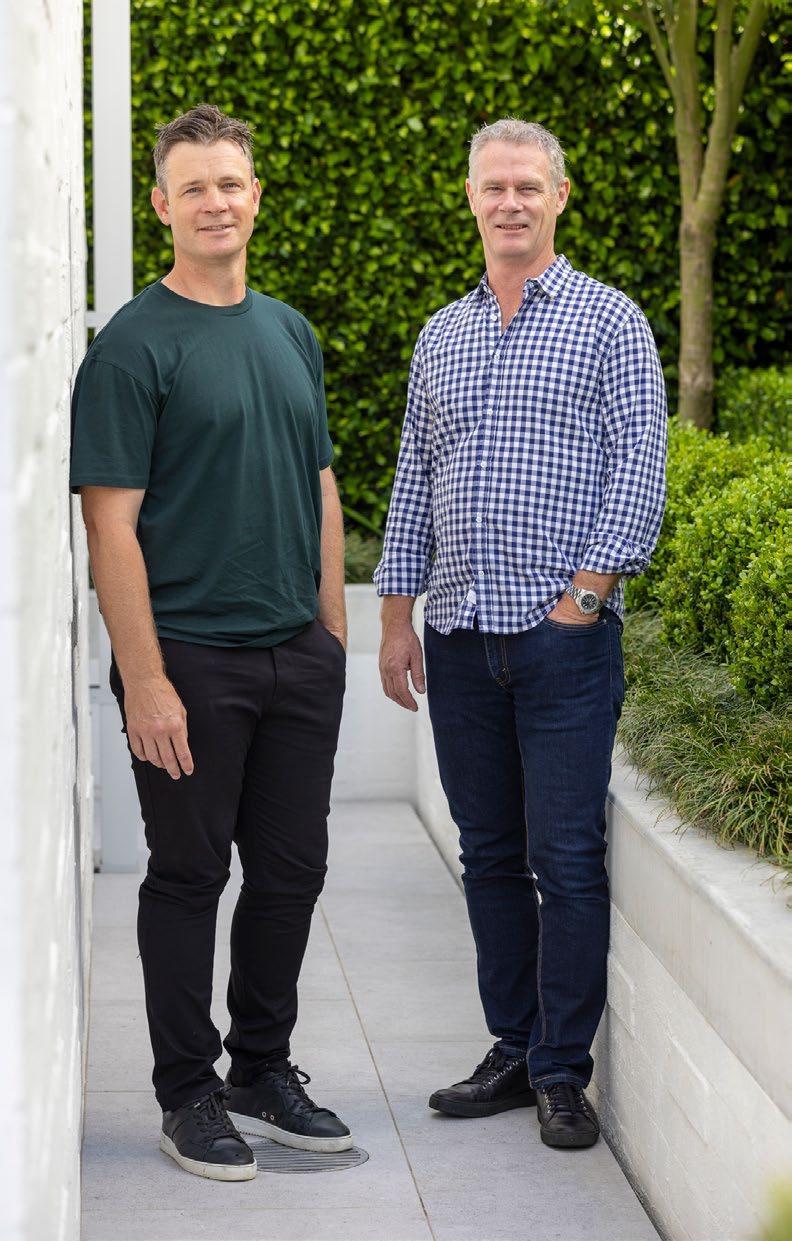
Dan:
"Tell us a bit about your business and what makes it amazing?
Paul:
"At Humphreys Landscaping we design, build and maintain elegant and timeless outdoor spaces for homes across Auckland. We are unique like Box™ in that we can provide all the services a client requires to build their landscapes with one point of contact. We do this through our three companies: Humphreys Landscaping, Pool Magic and Executive Pools. Traditionally, homeowners need to deal with multiple companies to achieve this.
Tell us a bit about the relationship, how long have you worked with the Box™ team?
We have worked with Box™ for many years on exciting projects across Auckland and Waiheke Island. We currently specialise as the pool design and construction partner of choice. Through our Executive Pools brand, we create concrete pools that are of exceptional standard to match Box™ ’s high end construction
standards. The relationship with Box™ is excellent and the clients benefit from two companies that work well together to produce a quality result.
What current trends are you seeing among clients?
Clients increasingly want to create a swimming pool area to be a social space for families and friends to come together. A well thought-through design is key to this. Our in-house design team, led by Jeremy Cole, are experts at ensuring the design of the entire landscape matches the wants and desires of the client. A landscape should not be thought of as separate to the pool or the home itself but as a complete package and clients expect this as standard. Our close relationship with Box™ gives the client this service every time.
Planning early is key. It is crucial to engage with a talented, experienced design team at the beginning to ensure the overall
process is cohesive and the result is a project that is well designed and connected to the house and property. A well-planned project not only delivers a beautiful result at the end, but it also enables all parties to collaborate on the construction process, making sure that every efficiency that can be made, is made. This enables the project to be as cost effective as possible.
We are proud of the partnership we have with Box™ and pride ourselves on our high standards and quality of work we deliver together. That will continue to be the case for all of our clients. Our garden and pool maintenance business continues to grow, now being the largest in Auckland, and this provides fantastic ongoing relationships with our customers who we often work with for years beyond their initial build project."
To learn more please visit: humphreyslandscaping.co.nz
OPPOSITE TOP Clean lines and open spaces integrate this outdoor space into the landscape beyond. OPPOSITE BELOW This fully-tiled pool impresses with a darker colour complementing the surrounding landscape materials. ABOVE Design Manager Jeremy Cole with Humphreys owner Scott Humphrey.It’s become something of a holy grail in Aotearoa: how do you produce housing that is architecturally designed but standardised, without being generic?
The guys and girls at Box™ have been pondering this for a while. The outcome? A sister company ‘Artis’, which launched late last year and specialises in smaller homes with designer flair.
Box™ has been working on streamlining building for the better part of two decades. For years, senior architectural designer Laura McLeod and project manager Amelia Wilson met people who wanted something architecturally designed, but lacked the budget.
Eventually, they realised there was an even more streamlined way of doing things, and that became Artis: a set of design principles with considered components and details that could be arranged in a variety of configurations. Rather than a set of predetermined floor plans – which will inevitably be changed and pulled, sometimes beyond recognition – the Artis approach offers considered elements that fit together to suit each brief and site. The designs are fun, made from hard-wearing materials, with a sense of beautiful simplicity and a minimum of circulation spaces. The result is compact, highly efficient housing built to a set specification and system.
“Building a house can be stressful and complex,” says McLeod. “This really speeds up both the design and build process – but retains architectural flair.”
The process starts with a feasibility study, which takes in the broad-brush challenges and opportunities of each project and moves to concept design. But here’s where it gets really interesting. Along the way, the pair have conceived of a system of “blocks”, built to scale, which allow an intuitive, collaborative design process – there’s a standard-sized bedroom, bathroom and a couple of options for living spaces, along with a choice of roof forms. “We realised we need flexibility,” says McLeod. “So where do you allow that and where do you constrain it to keep it efficient and keep the costs down?”
Together with their clients, they haul out to-scale modules and arrange them, pushing them about to find the right layouts before proceeding to detailed plans that involve standard building system and a choice of pre-designed material palettes. “It’s kind of like we’ve made 80 percent of the decisions,” says Wilson, “and then we let you have a go with 20 percent.”
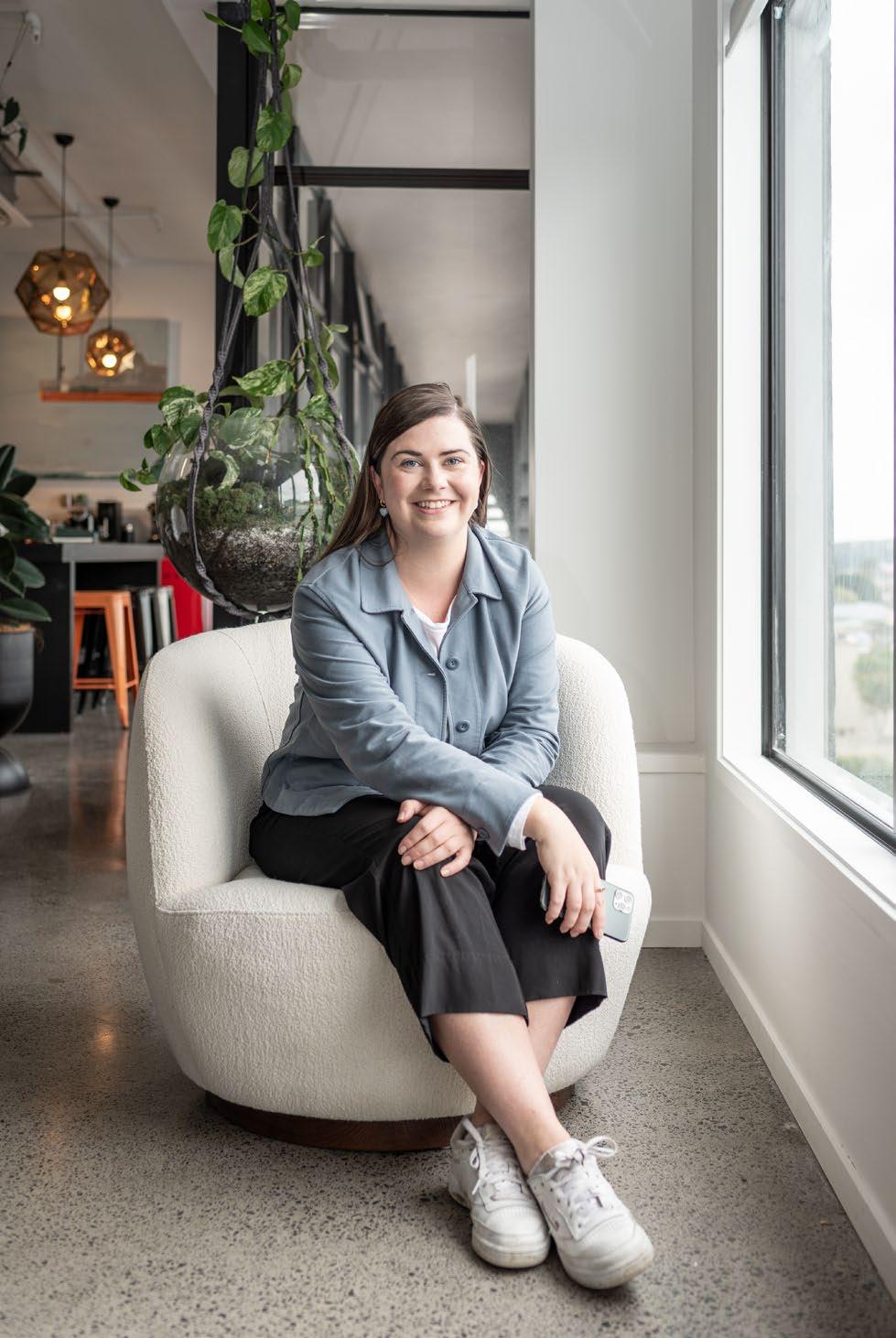

Examples of homes that can be designed from the Artis system to suit different clients, locations and budgets. Prices guides are for mainland Auckland, and exclude any required siteworks.



One-bedroom home with an adjoining bedroom and ensuite module.
Price guide 2024: $650,000 – $750,000
2 bedroom bach with large covered and uncovered decks.

Price guide 2024: $500,000 – $600,000
Traditional 2 bedroom home, with a selfcontained studio annex.
Price guide 2024: $700,000 – $800,000
Urban 2-bedroom home.
Price guide 2024: $500,000 – $600,000
Project BELL Project RANG Project NEPT Project RUAWUrban 4-bedroom home, two-storey.
Price guide 2024: $750,000 – $850,000
3 bedroom bach including separate 2 bedroom + ensuite module
Price guide 2024: $700,000 – $800,000
100sqm, split-level 3-bedroom home.
Winner of NZIA Small house award.



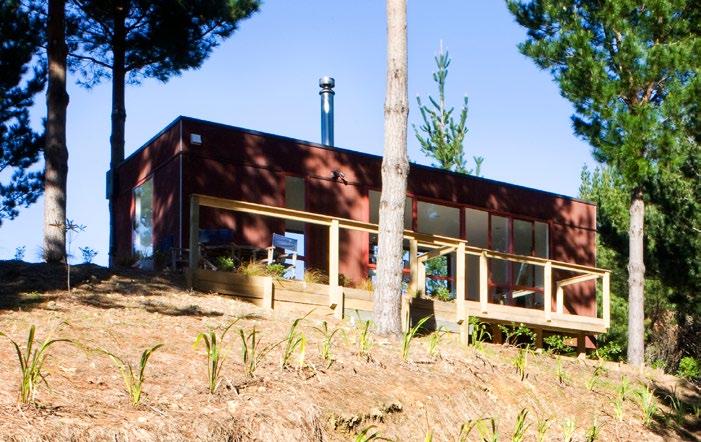

Price guide 2024: $550,000 – $650,000
To learn more about Artis homes and see what configuration might work for you, please visit us at artishomes.co.nz
Small 50sqm artist studio + ensuite.
Price guide 2024: $200,000 – $300,000
3 bedroom bach including separate 2 Urban infill 2-bedroom home.
Price guide 2024: $500,000 – $600,000
Project PAK2 Project CORR Project WHIT Project HELE Project JONESince our architecture-and-build studio started more than a decade ago, Box™ has relied on creative collaboration within the team to imagine and deliver homes that are not only functional and great to be in but uniquely personalized for our clients.


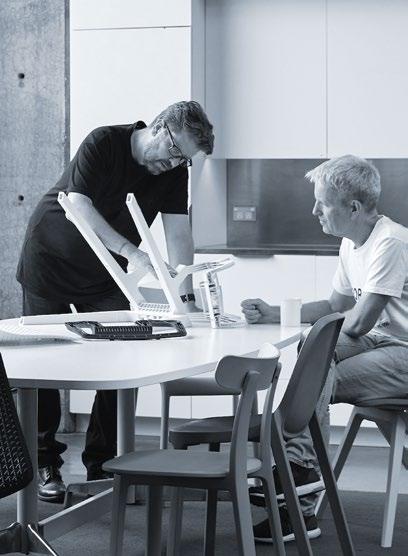
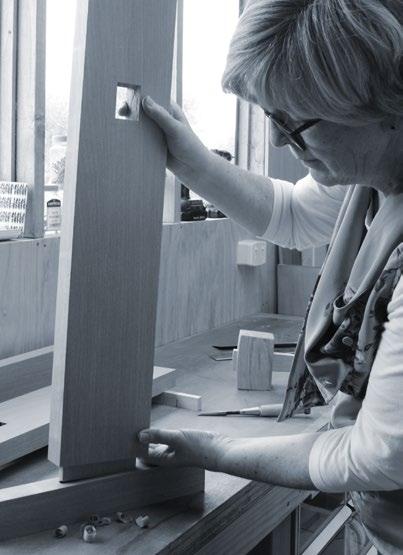
Now we’re spreading that net wider, inviting craft-ists and artists to connect on a new online platform we’ve called Collective by Box™. Think of it a bit like Etsy meets The Design Chaser: it’s a curated assembly of Kiwi-made homeware products and objects that speak to our aesthetic and to our soul.
Keeping it local is key but also... keeping it real. The items in this online store include pottery, rugs, furniture, lighting and art.
“It’s anything that brings us small moments of joy and resonates with the in-house team,” says Box™ co-founder Dan Heyworth (who secretly wants a spot reserved for his homeroasted spicy almonds).
We’re open minded and excited to be able to nurture homegrown talent. We want to celebrate and support design innovation, plus unearth some products and pieces that key into the Box™ DNA. We have a particular fondness for authenticity and hand-crafted objects.
The launch of Collective by Box™ was in late 2022 and we’re hoping the site will grow organically.
So, if you’re a start-up designer or an artist who appreciates our brand and think you make something that would fit with our thinking, get in touch (hello@collectivebybox.co.nz). It could be the start of a beautiful relationship.
 Jane Inge / Workshop Four Forty
noho
Jane Inge / Workshop Four Forty
noho
Box Design started with a simple intent, to improve the design of the humble letterbox. Now, two decades later, known for having created New Zealand’s smartest letterboxes that make a real entry statement for any property. They’re more secure, maintenance free and easy to install.
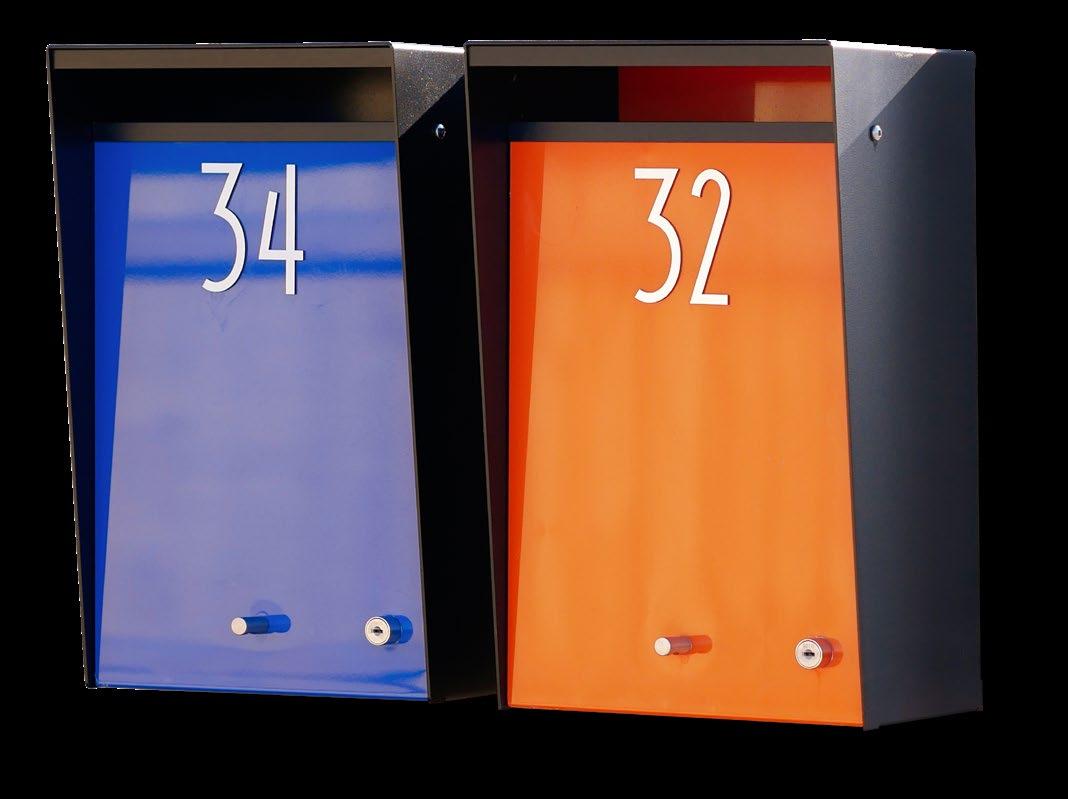

Anne Daniel creates unique, quality, hand-woven wall art, kete and three-dimensional pieces, out of harakeke (NZ flax) and other plant and animal fibres. She is based in Kaniere near Hokitika.
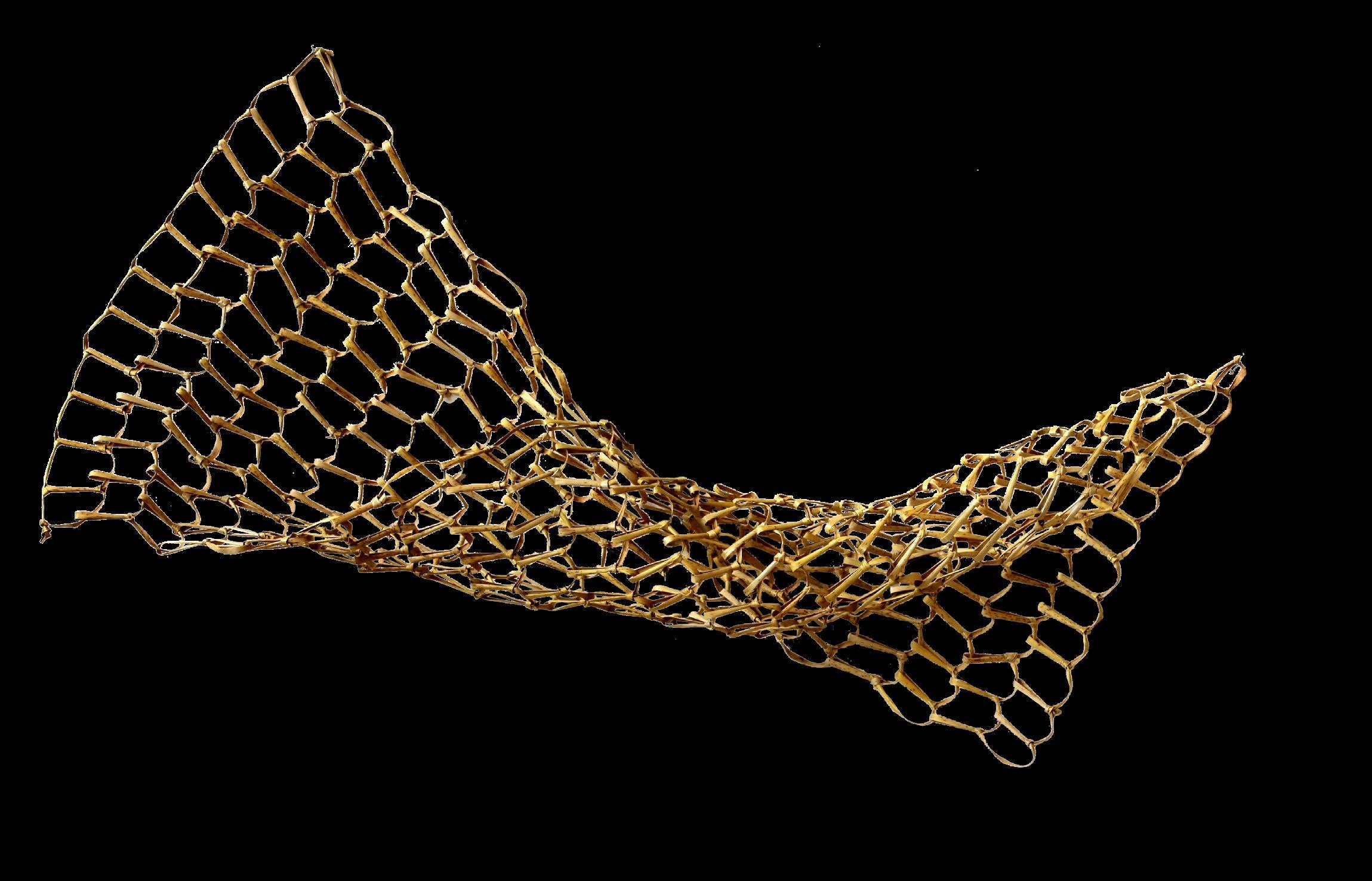
Jack Marshall is an Auckland based painter and also one of our builders at Box™ . He graduated with a Bachelor of Design and Visual Arts from Unitec in 2013 and has painted both large and smaller format works since.


With over 60+ years of experience, Bremworth wool is not only 100% natural, biodegradable and renewable, but it’s also a brilliant fibre for design innovation and overall performance on the floor.
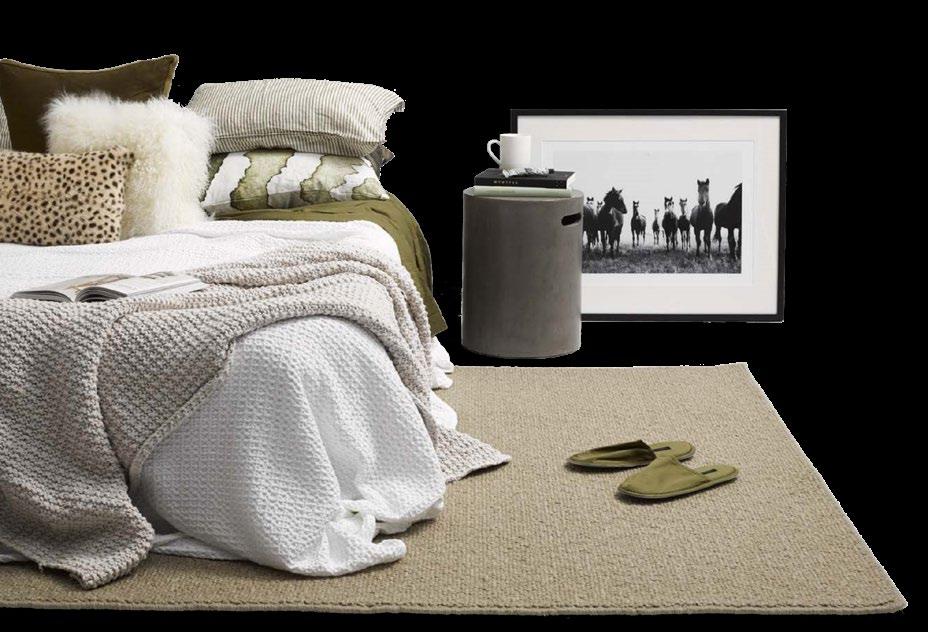
Form. Focus. Function. The Crisp & Co range is made from aluminium sheets and brushed stainless steel; robust materials that are made to last.



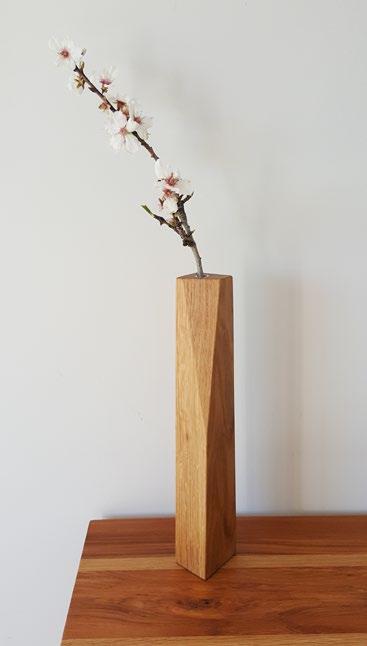
Jane Inge is passionate about working with timber to design and make beautiful functional furniture, mirrors and lights celebrating the many tones and grain patterns.
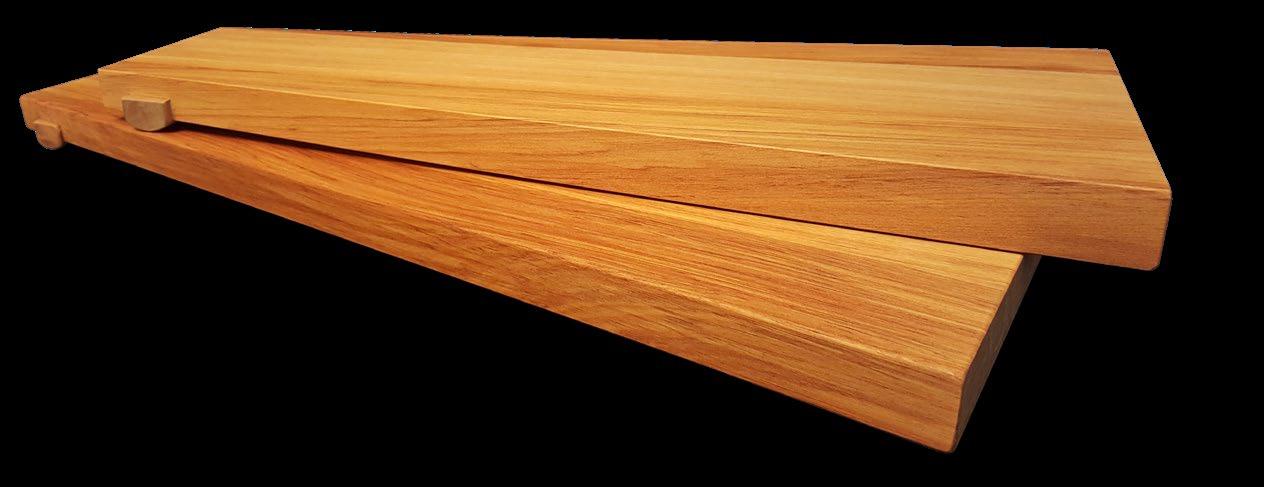
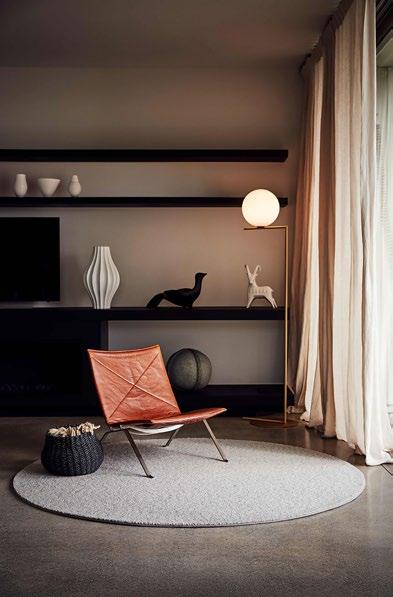
Solomon Marshall is The Solo Blacksmith . His passion lies in teaching the self-reliant craft of forging and believes raw materials are given value by the skilled hands and time of the maker. Building on traditional methods and using time-tested materials, his focus is on useful, rough and ready, pared back design to create long lasting objects of daily use.

Made of Tomorrow are drawn to the curves and colours of retro design. They use minimal plastic throughout and recycle where possible. In every product they create, they consider three things, is it made responsibly? Is it made to last? And is it practical?

Lukeke create a range of quality crafted lighting pieces that blur the line between art and design to illuminate your home. Each piece is individually crafted and hand blown with a unique contemporary-retro fusion that adds warmth, character and a refined statement to any interior.
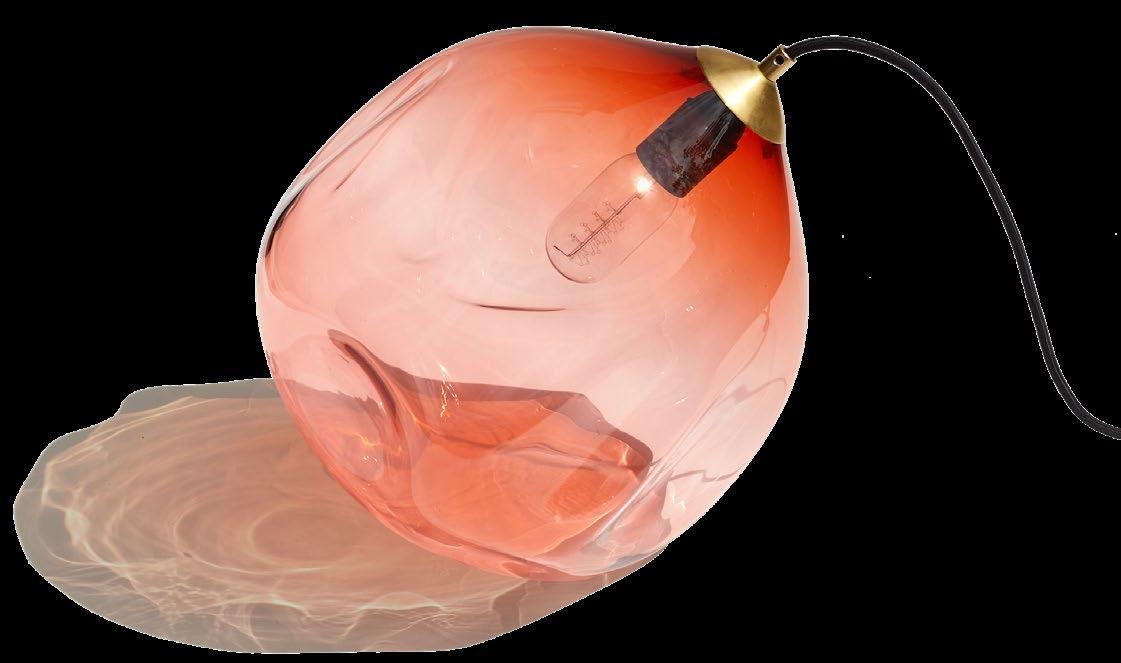
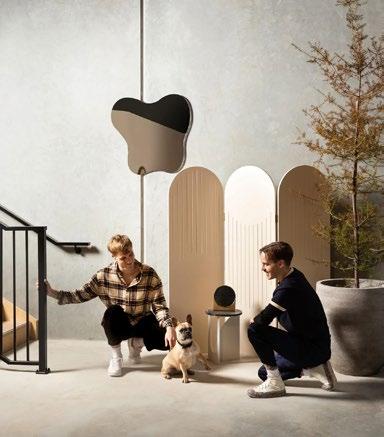

Comfort without compromise. Noho believes that furniture should look and feel good while doing good for our planet, too. It’s why they don’t rely on conventional thinking or materials, but instead create earth-friendly designs that help clean up our oceans, protect our environment and enrich our homes, our well-being and our everyday lives.

Founded by Tate Watson and Sam Taylor, lowercase is an expression of what they value – quality materials from sustainable sources, traditional woodworking techniques that ensure longevity and a design ethos that focuses on enduring appeal.
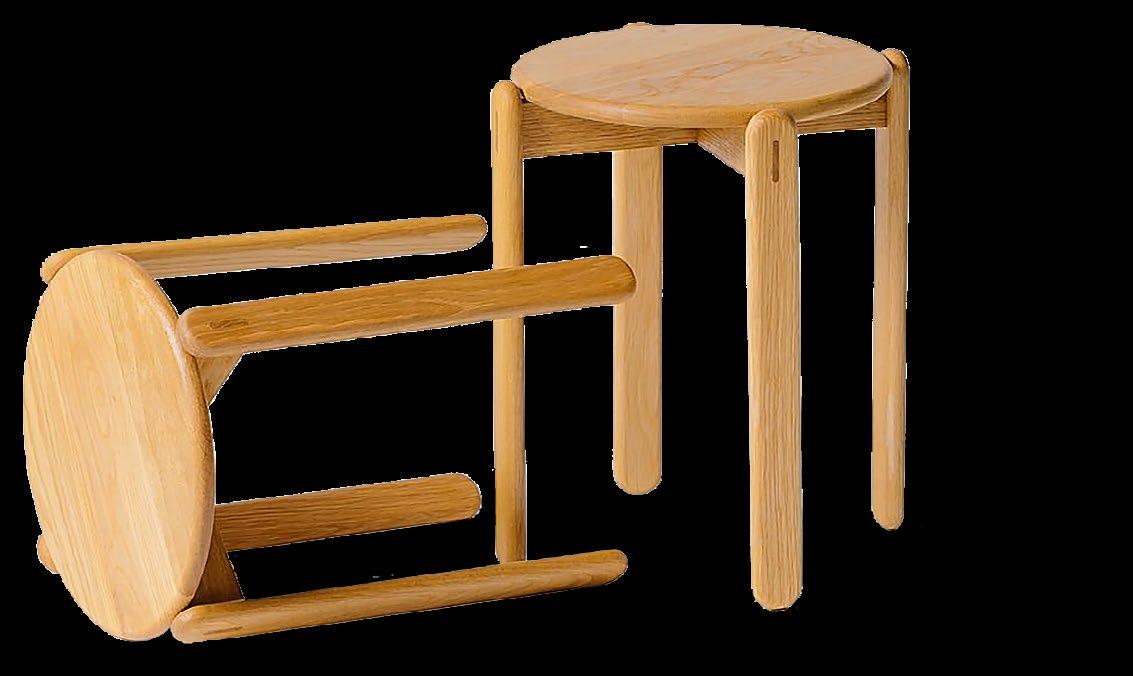
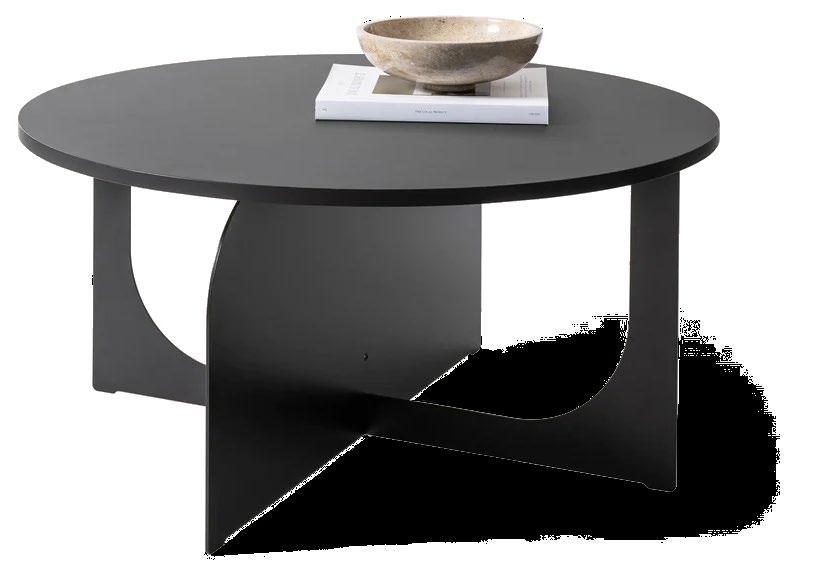
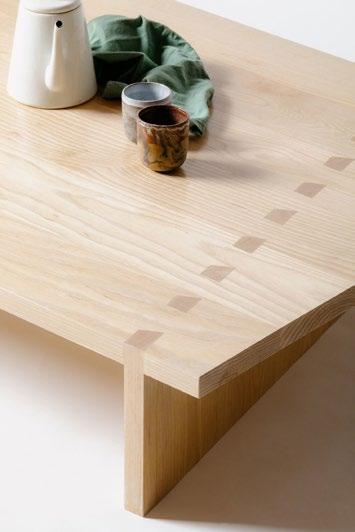
As an architectural photographer, Sophie is naturally drawn to lines, colour and texture but especially to people. Auckland's public spaces provide her with the inspiration for her personal work, as well as sparking a familiar connection for the viewer.

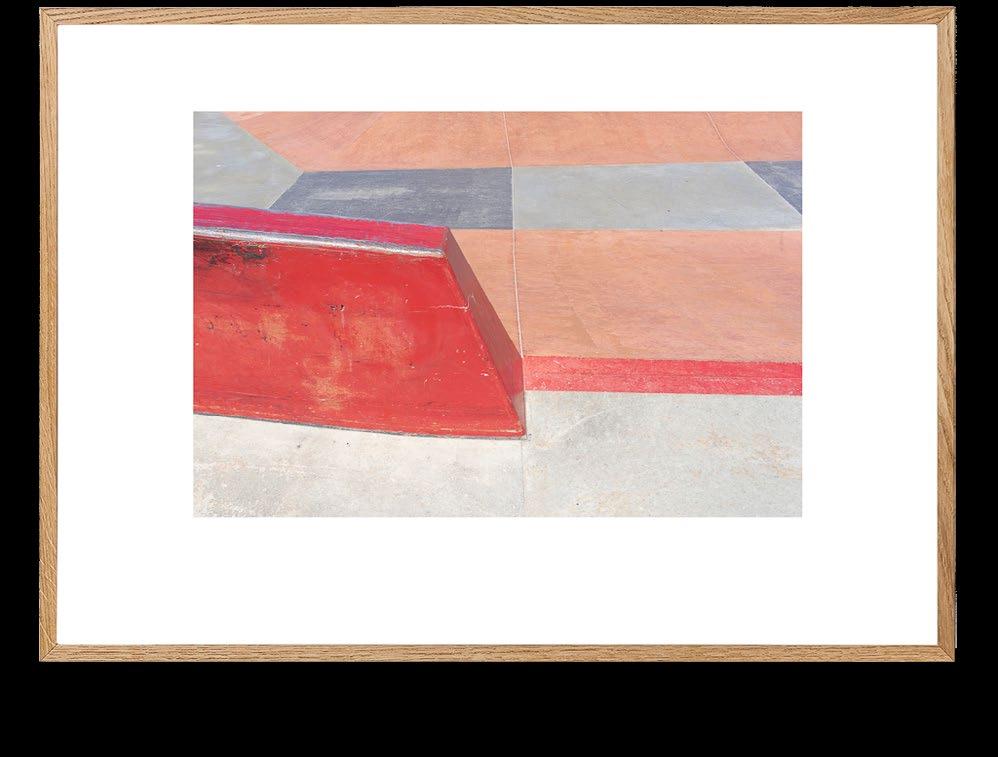
As a design studio, the focus of the Arc Dept is on creating spaces with an emphasis on considered details. The meeting of points and junctions between materials are so important and can become the hero of a design.

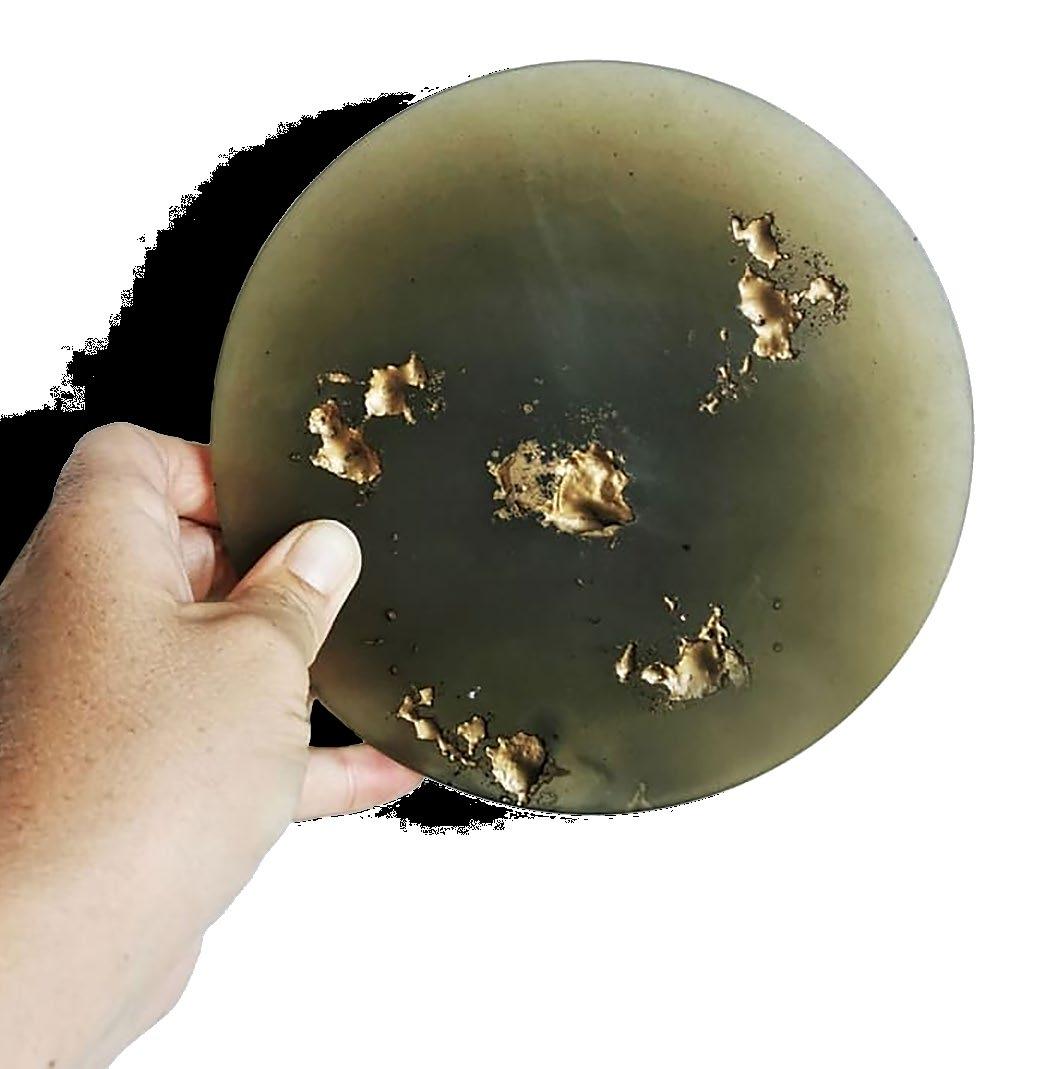
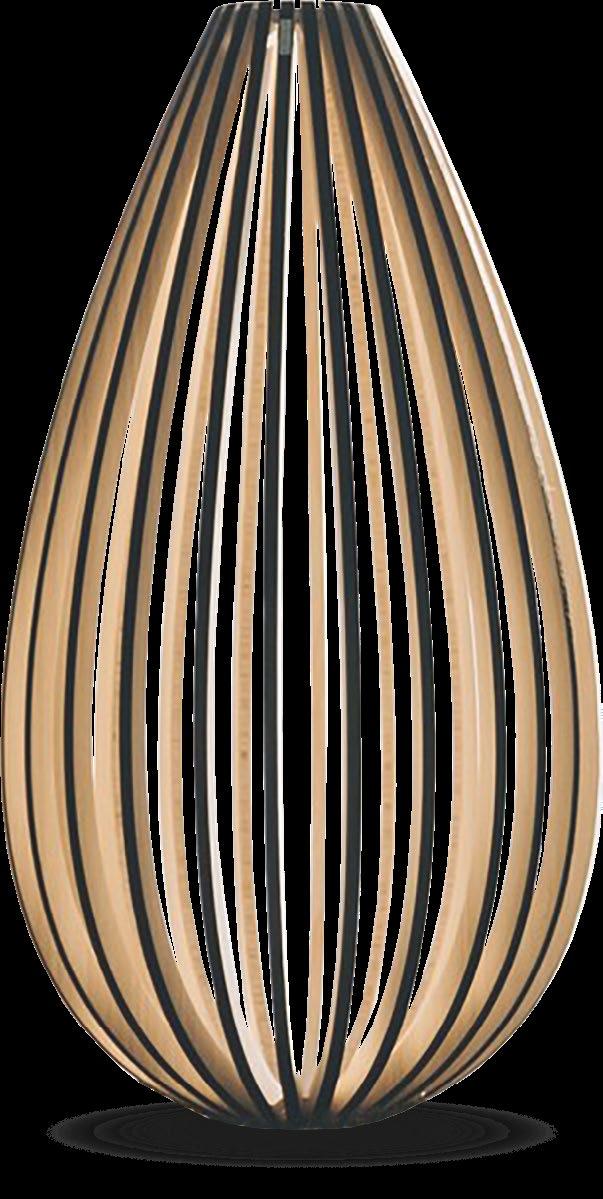
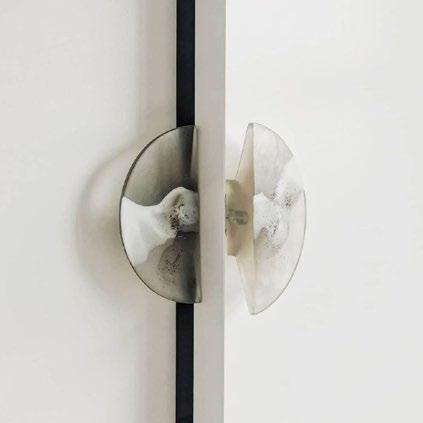
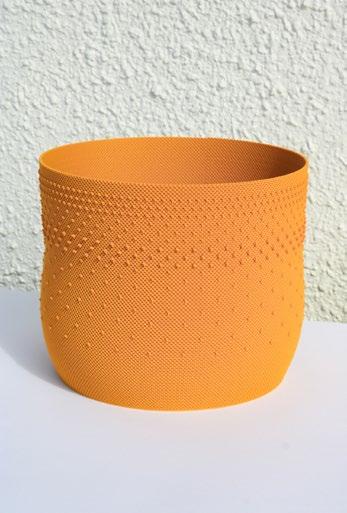
Gus Leen is an Industrial Designer based in Timaru, New Zealand. Gus has a passion for creating ambient, sculptural lighting & furniture products in his joinery workshop, situated on his family’s farm.

Courtney and Matthew are a couple of Kiwis who share a passion for creativity, design and nature. Their mission at Utilize is to create timeless, NZ made homewares which offer an eco-friendly way to live an aesthetic life. By only using recycled or sustainably sourced materials within every aspect of their work, they hope to minimise our environmental footprint, and influence sustainable consumption.
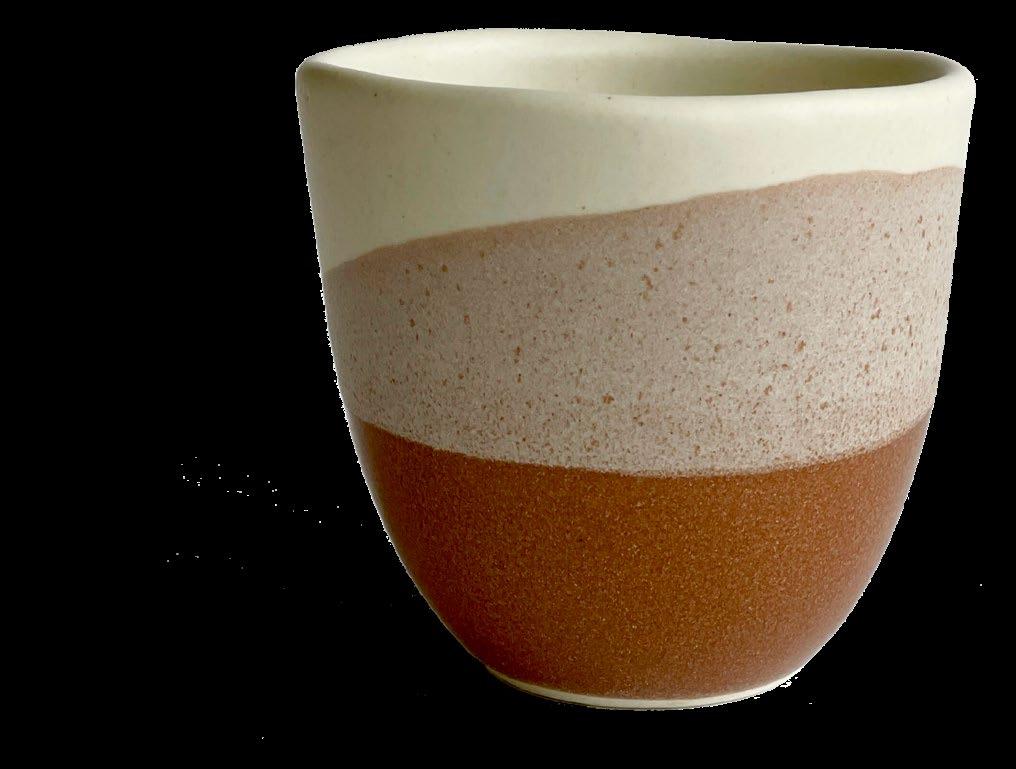

Waiheke Ceramics made ceramics designed and created on Waiheke Island. With strong naturalist backgrounds inspired from the beauty of native flora and fauna. Their designs are grounded in Danish and Māori heritage.



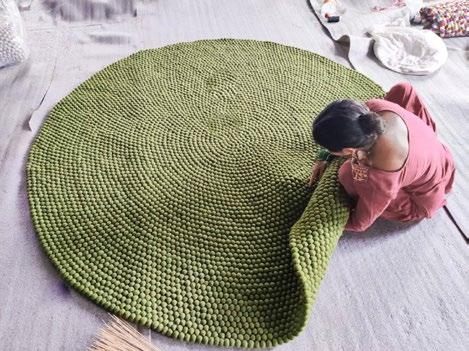
Mindful slow-crafted rugs that are easy on the eye and the planet. All Weaver rugs embody the ethos that we should work in harmony with nature, leave no waste and create no harm. Weaver uses only natural biodegradable fibres that are free of AZO dyes, adhesives and toxic chemicals. At the end of its life, your rug can be returned to the earth through composting.
Social Light breathe life into products that are designed and manufactured locally by talented craftspeople, that are timeless and classic to ensure longevity and value.

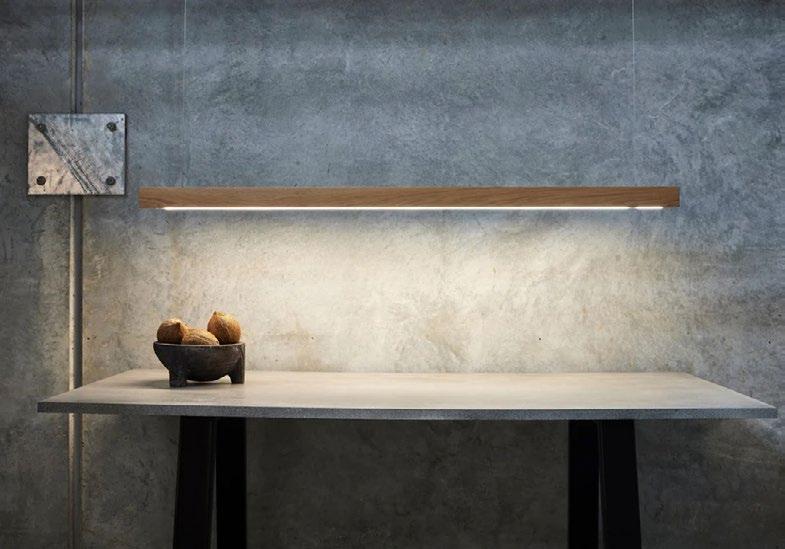
Pegasus.art is the reuniting of two primary school friends after decades spent apart on opposite sides of the world. Together they create environmental sculptures that leverage landscape and light to beautifully enhance both indoor and outdoor settings.

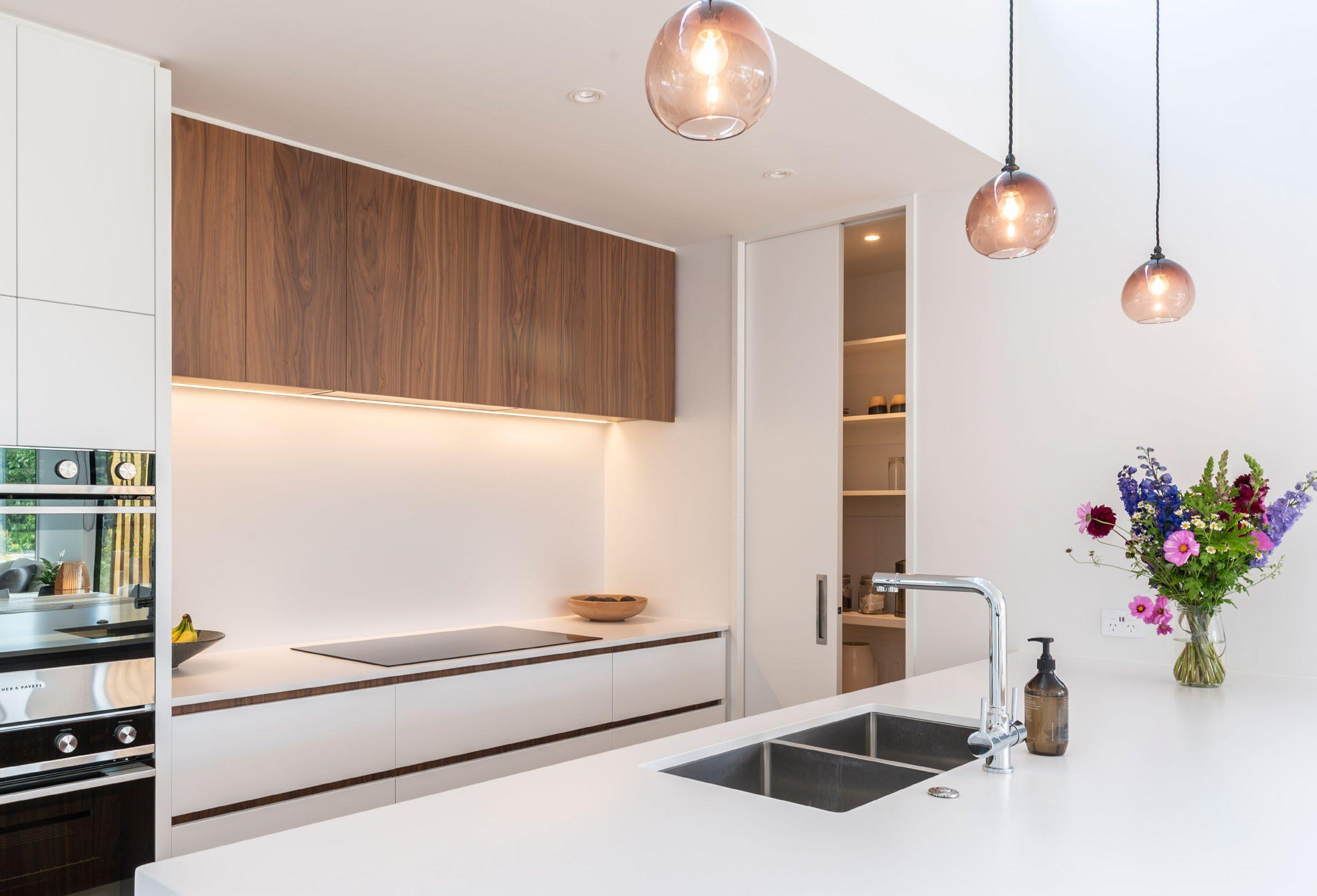

Stu:
"Tell us a bit about the relationship, how long have you worked with the Box™ team?
Mark:
"Since our first project in 2018, I have got to know the people of Box™ well on a professional but a personal level also which I believe is so important. Having regular catch-ups and an opportunity to sit down and discuss upcoming electrical trends, pricing and the like has been vital with solidifying the relationship. My team and I feel proud when looking back at the homes once completed and handed over to the client. We’re always pumped to work on Box™ jobs. Mainly because we know we are working with industry leaders who are committed to creating amazing spaces and getting the best results for our clients.
It’s our people, our teammates. We’re a great bunch of people who thrive in enabling projects and deliver top quality work every time. Our mission has always been to provide our customers with intelligent, energy efficient homes. Smart homes are safe homes, and this is a key priority for our customers and their families. This is the work we love.
Any particular products you use and are really keen on at the moment?
Living in comfort is one of the most important features of a home. Lighting is
a simple but often overlooked solution to making your home more comfortable. A newer product in the residential market is Tuneable lighting. Lighting colour can be customised and works with automation or smart lighting systems such as Casambi. The colour of white light can automatically adjust to a warm ambient light as it gets dark outside to mimic the sun setting. This results in a comfortable and relaxing evening environment, and most importantly, sets you up for a good night’s sleep. Lighting scenes can be configured to automatically turn off certain lights (such as kitchen) and dim to warm other circuits (lounge and hallway) in the evening, adding to the relaxing atmosphere and also saving energy.
Any tips to future clients to make their builds easier (and cheaper!)
Be honest with what you want in your home and plan for it. Try to avoid changes and variations, they are expensive and easier to plan for at the beginning. This also allows you to get a realistic cost of your overall contract ahead of the work starting so that there are no surprises or complications later on.
What future plans do you have for your business?
We love new innovations and will always continue to evolve as new technologies do. But what really excites me is evolving
our ways of working, including how we work together as a team and with our clients. Processes such as completing ‘retrospectives’ at the end of projects to understand what went awesomely and what needs some fine tuning are so important but often overlooked. When we understand where there are opportunities for growth, we are more efficient and everyone wins.
If you were designing a house for yourself, what type / style of house would it be?"
A home that is comfortable and works for me and my family. We work hard enough outside of the home that we want our home to work for us. This means warm and dry, with lots of natural light (and intelligent lighting where there isn’t). A home that can be controlled, even when we’re not at home (hello to coming home to the heating and lights already on when you pull in the drive). And a home that I don’t have to worry about leaving my family in, with reliable security. And because we’re a young family, single level with amazing indoor/outdoor flow and an easy access driveway. Ocean views wouldn’t go amiss either :)"
To learn more please visit: topmarkelectrical.co.nz
 OPPOSITE Seamless lighting between living spaces requires top-level electrical knowledge and experience. ABOVE Mark from Topmark Electrical.
OPPOSITE Seamless lighting between living spaces requires top-level electrical knowledge and experience. ABOVE Mark from Topmark Electrical.
What our clients tell us shapes their new home. At project initiation we listen to their wants and needs, and in turn we design the living spaces that meet those requirements.
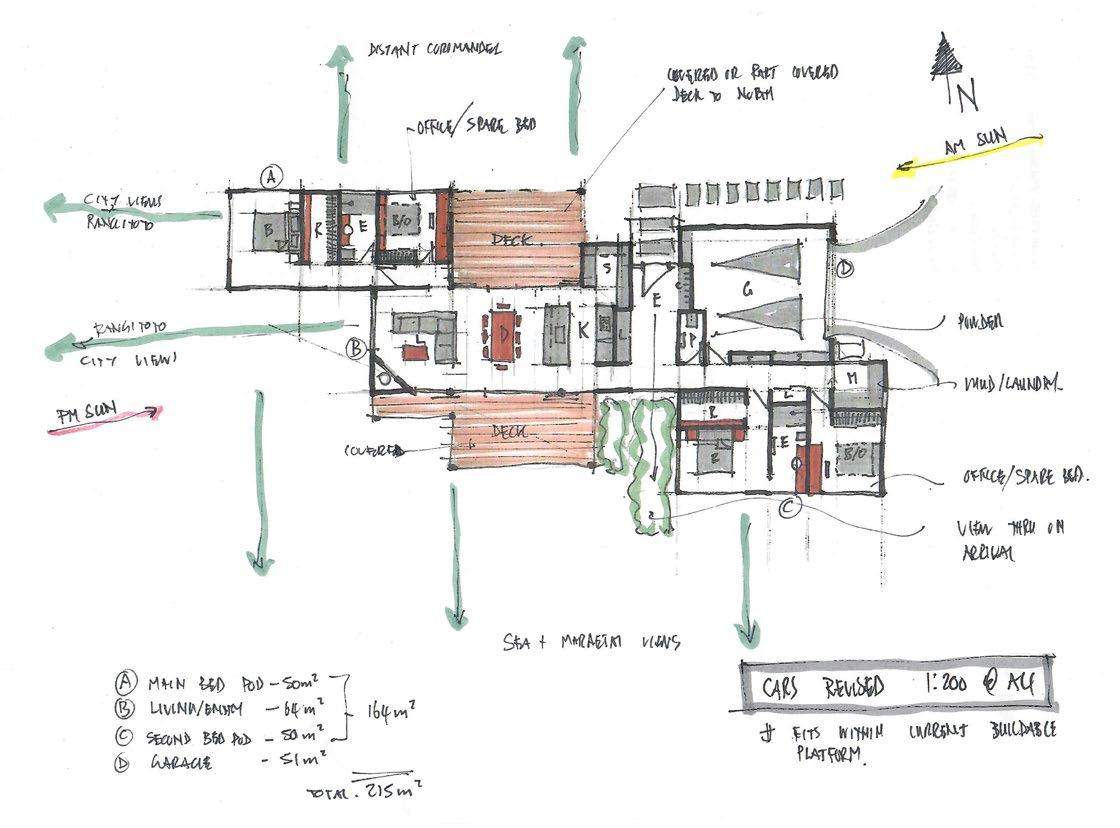
At the other end of a project timeline clients also communicate with us. For the three projects presented here, clients tell us in their own words how Box™ created the new home they wanted.
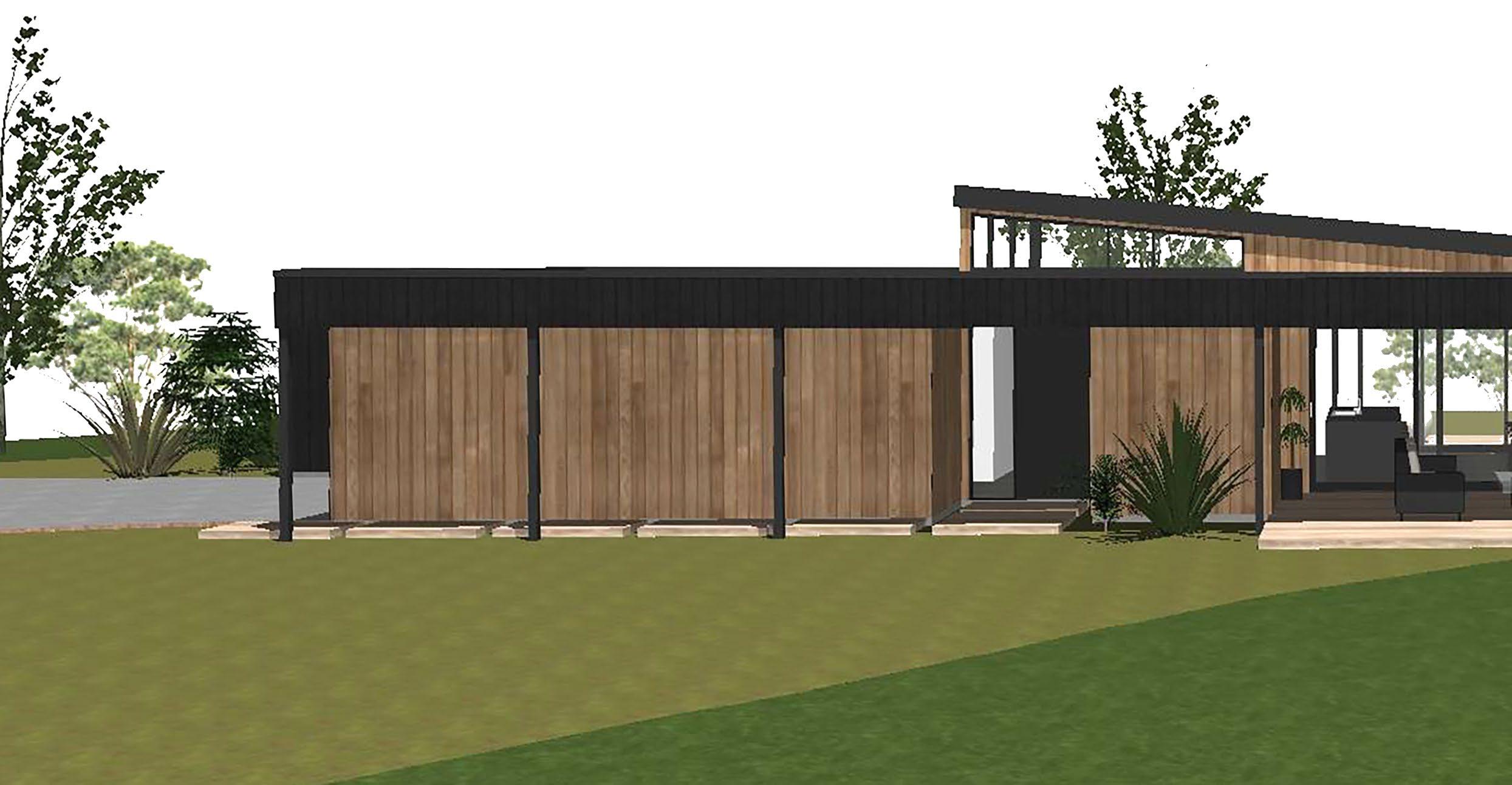
When Peter Phillips and Deborah Blood renovated their 120-year-old villa in Auckland during 2010-2012, it was, in Deb’s words, “an arduous process – that took years off our lives”.
So, when it came to building a family holiday home on a piece of land the couple had owned on Waiheke Island for over 20 years, the idea of a comprehensive package, with design and build wrapped up in one, moved to the top of the list. As Deb remarks, “We had already been through the experience of a non-integrated build project.” They did not want to repeat it.
The couple’s daughter, Lara, who was the third party in the project, suggested Box™ . And from the very first meeting with the team, it was evident this was going to be a beautiful relationship. “It was professional, interactive, compelling. Everyone was really engaged. It was so very clear it was going to be easy to work with them,” says Deb.
Box™ provided the couple with some on-island references so they could do those crucial credential checks. When Deb phoned up, previous clients invited them round for a cup of tea and a look-see. “Everyone was so enthusiastic and generous about sharing their knowledge and experience; we felt part of the Box™ fellowship,” laughs Deb.
Then, when Design Manager Tony Borland-Lye went to visit the site on a significant ridgeline overlooking the gulf, city and Coromandel, they felt even more reassured. Box™ anticipated every aspect that needed to be investigated before the concepts began, such as archaeological assessments and engineering surveys. “It was all very thorough,” says Deb.
Collaboration was an important ingredient with several sketches and back-and-forth iterations to explore ideas and respond to feedback. Once their thoughts had evolved sufficiently, a 3D model helped the clients truly visualise the possibilities of their home –and more changes were made. The couple, who trusted the process, now feel 100 per cent happy with the result.
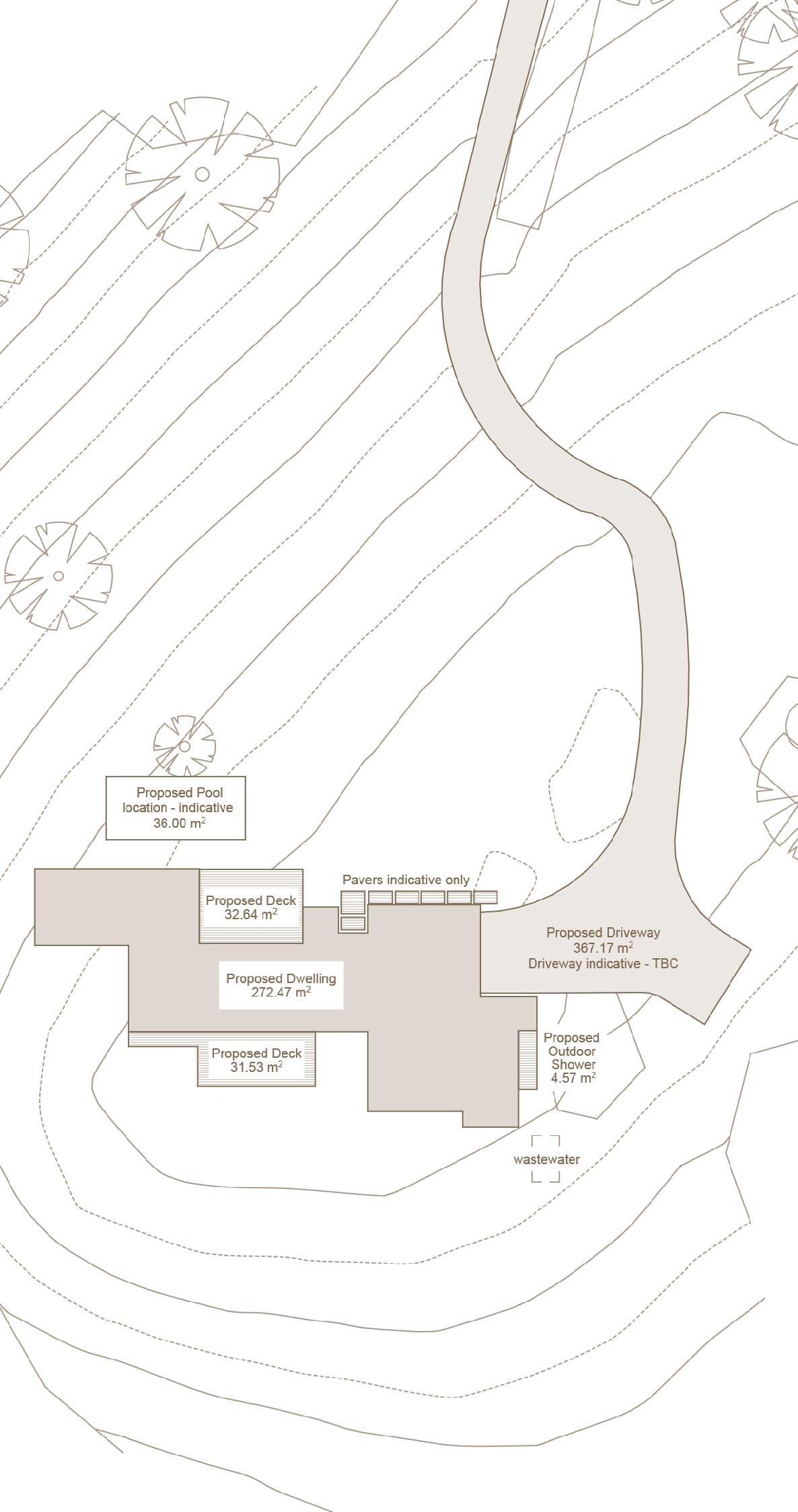
Although the project is currently on pause until Lara returns from a stint in Sydney, they are itching to get started on the construction phase. “The design stage was a sheer delight, and although building on the island has its challenges, we are confident because we know Box™ has done it many times before.”
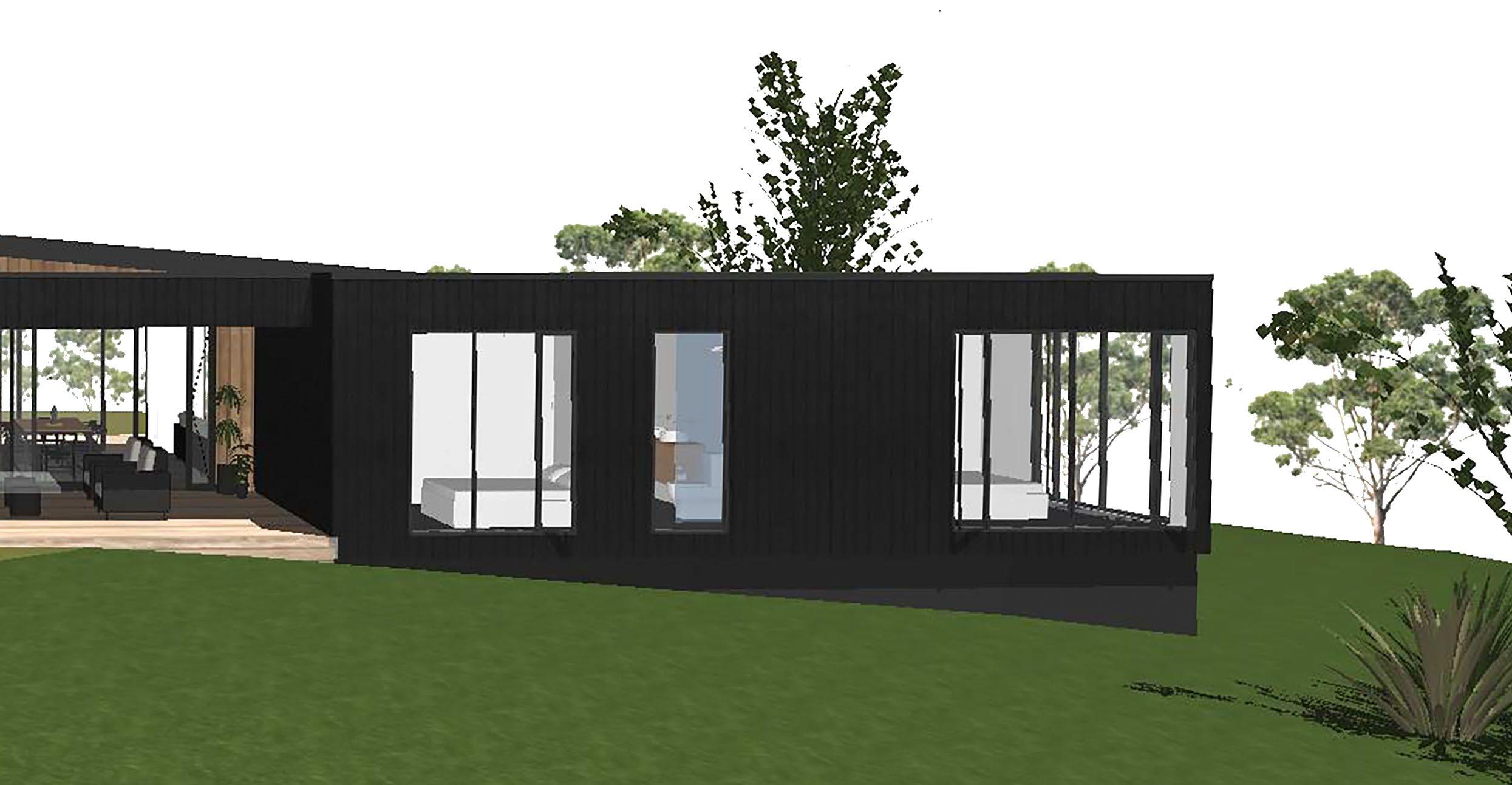
When Covid confinement gave Mary-Louise Stocker and Dave Gregory the impetus to renovate and extend their cute Arts & Crafts brick house in the Waitākere hills, and they asked people they trusted for advice, one friend immediately mentioned Box™
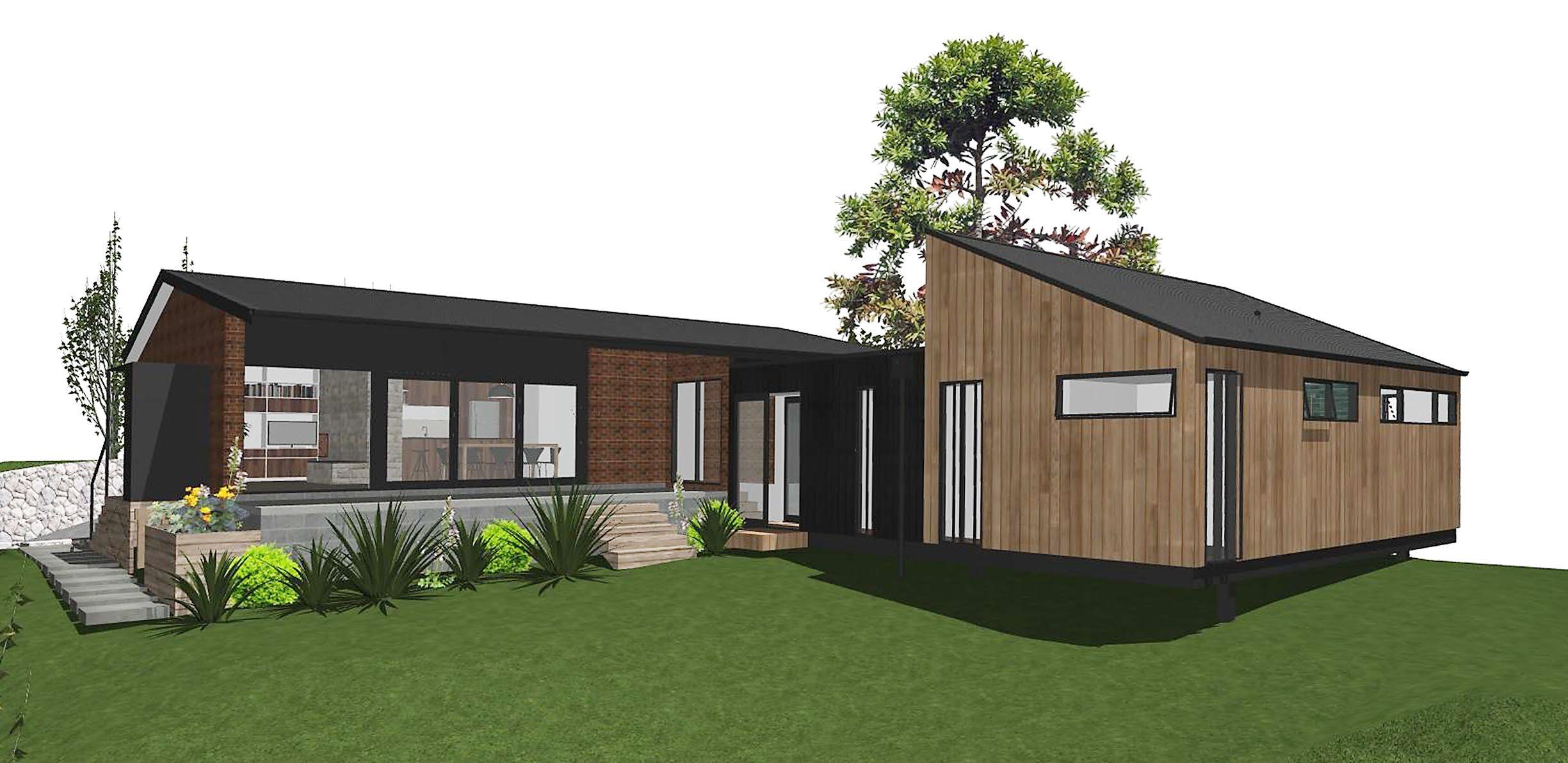
The couple, who bought the 1959, two-bedroom home a decade ago had initial ideas of moving somewhere bigger with their daughter, Pearl. But prices were skyrocketing, and they found it impossible to replace what they already enjoyed: an acre of land with views to the city and the backdrop of a bush reserve.
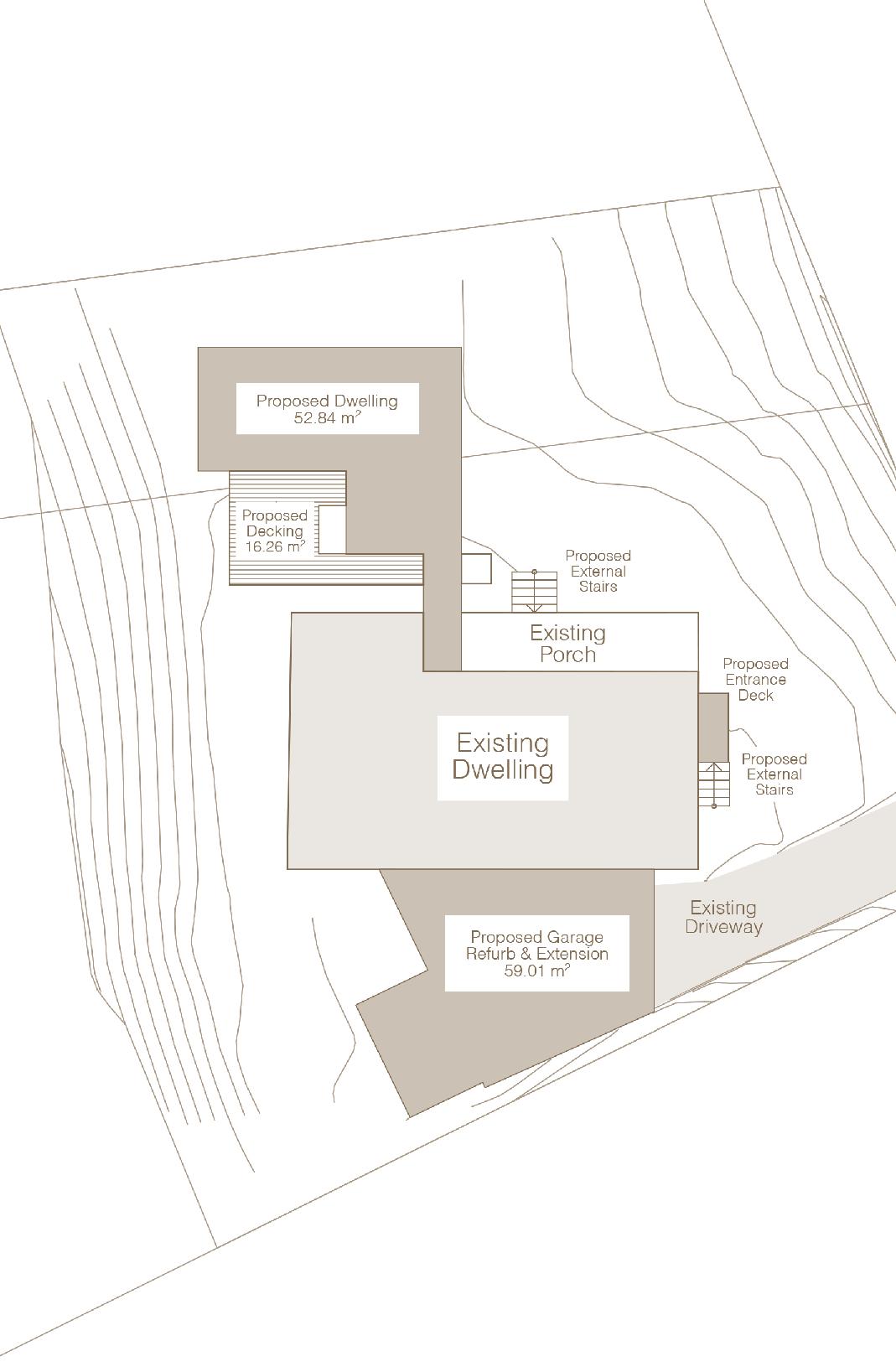
They asked three design-and-build companies to provide a general indication of price for the project – an extension that added two more bedrooms, another bathroom and an office effectively doubling the footprint. “The Box™ cost was in the middle, but we found they listened well and were engaging, plus we liked their modernist style and their vibe best,” says Mary-Louise.
As busy professionals, the pair appreciated the wraparound service and found the design process straightforward. “For months we’d been thinking about ways to achieve what we wanted but when [design manager] Tony came to the site, he understood our aesthetic.” The couple fell in love with the very first design submitted which retained the mid-century features that made the home unique – the arts & craft brick, original flooring, Hinuera stone and a big concrete verandah – but gave them far more space to breathe. “We made a few tweaks in terms of room sizes but we were really happy, and the 3D simulations helped a lot.”
Aside from a few timing hiccups, the extensive 11-month build ran like clockwork: “It was seamless and if there ever were issues, the team was quick to respond”. When steel costs soared, Box™ altered the plans to bring the budget back into line.
Now ensconced in their expanded home, the family say it is more than they could have hoped for. Cathedral ceilings and generous glazing allow a closer engagement with nature while considered planning and modern materials keep the place toasty warm. “The renovation has enriched our lives hugely. We love living in this beautiful space” says Mary-Louise.

Houses in the East Auckland suburb of Mellons Bay are tightly held so when Nick and Kathryn Swallow were looking to upgrade from their first home there (a little bungalow close to the sea) they were fresh out of luck. The couple, who have two young children, loved the location but the house was too small and, after “going around in circles for many years”, they decided to build on the property.
At the time, the couple was based overseas so began to look for a design-build business – a one-stop shop that would make launching into the project remotely so much easier. “It simply wouldn’t have been feasible to negotiate a number of disparate teams from the UK,” says Kathryn.
Previously, when a Box™ bach was built around the corner from theirs, they liked what they saw. Then they Googled the company and liked what they read. A long-distance call with founder Dan Heyworth won them over. “They were clear about how the process works, gave us some good ideas and some realistic expectations about budget, so we decided to go for it.”
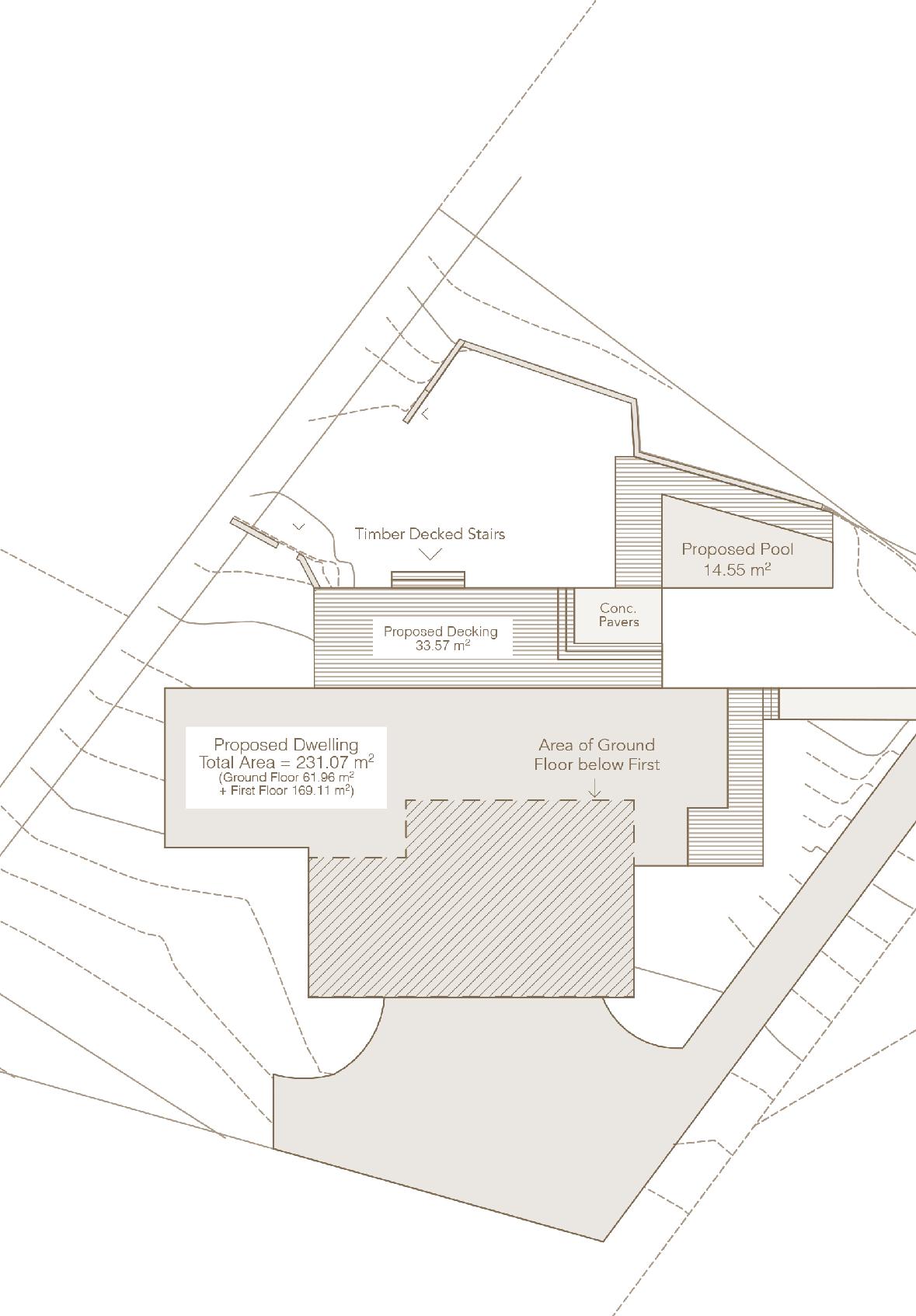
The Swallows acknowledge this was a leap of faith. They were both working, Nick was finishing his masters and there was the worry of an ill parent back in Aotearoa. “We wouldn’t have been able to build from overseas without Box™ ,” says Kathryn.
Their big “lazy A-frame” took a cue from an album cover - Billy Joel’s Glass Houses - that had stayed with Kathryn since she was a kid. Through Whatsapp messages, samples posted over and email correspondence, the design was carefully completed. By December 2022, when the family touched down in Auckland, the framing and cladding was already sorted. They moved in six months later. Throughout, clear-eyed communication and strong relationships were cornerstones. “It was a challenging period to be building in, but Box™ was clear on any limitations and gave us certainty about any rising costs, so we never felt overwhelmed.”
At one stage, project manager Amelia Wilson drove the couple around looking at Abodo cladding when their original choice would have caused a long delay. Going the extra mile was no surprise: “It was apparent right from the start that they had our best interests at heart.”
Now that the family of four is in residence, the future looks bright. “It’s so good to be here,” says Kathryn. “Really, really good.”
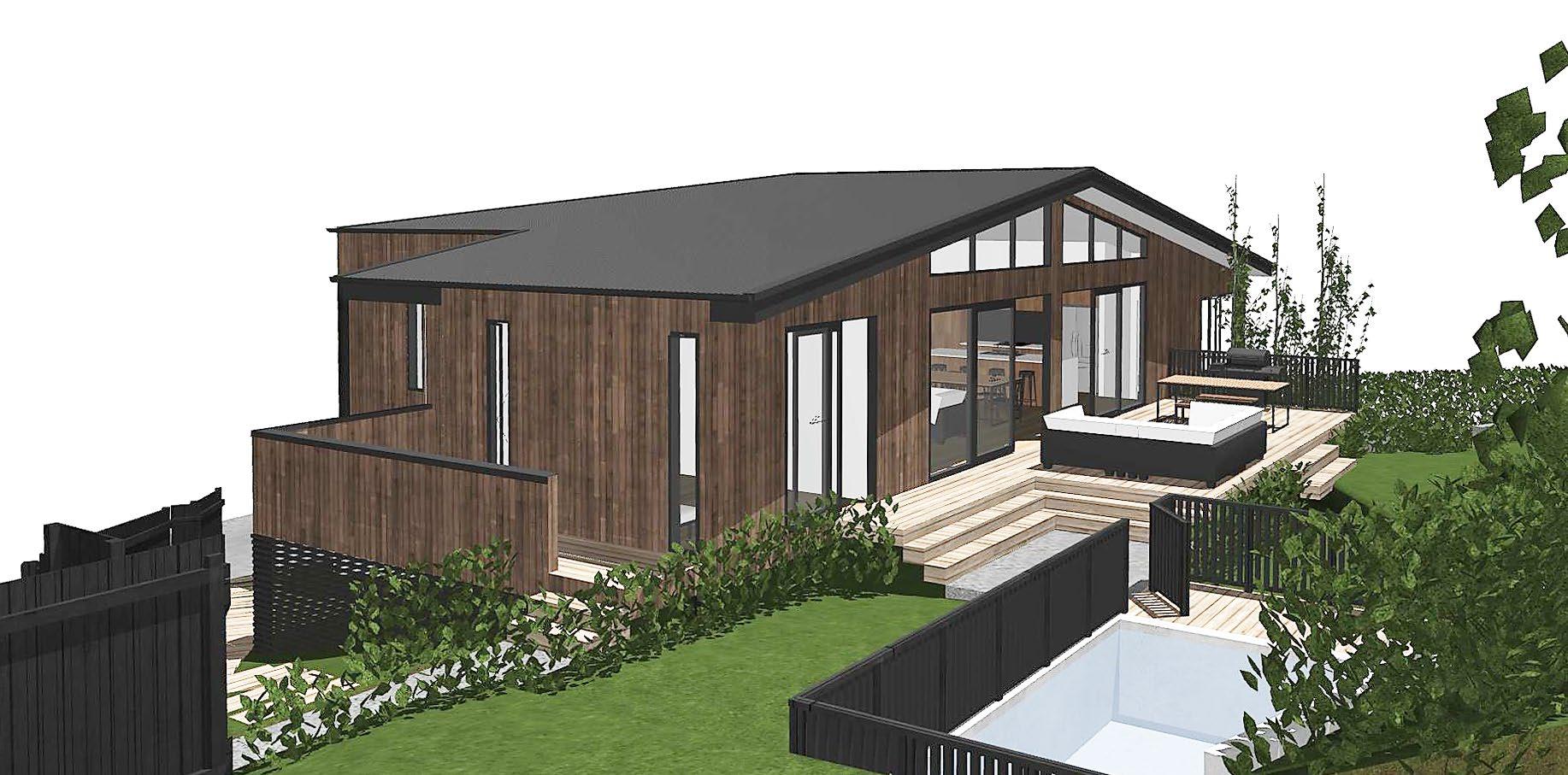
Here we present a couple of 'live projects' showing various considerations that take place before work above ground starts to take shape.

Project manager Amelia Wilson has been giving her gumboots a good workout since late February when the diggers moved in on this Mission Bay project.
As Aucklanders probably know, on the back of Cyclone Gabrielle, there has been no shortage of rain. Keeping the site safe and the cut from crumbling has been a priority. For reasons of access, this multi-storey house is being built from the lowest level up. First though, the section needed to be cleared, particularly of fill that had previously been dumped on the property, of wild ginger and thick, waist-high grass that was cut back by a fearless contractor. With access via a shared driveway, the big machinery moved in to dig out a hole and drill piles for the swimming pool which is at the very bottom of the site. Timber piles at the base of slope beneath the decking also had to be robust to carry the vertical pressure from above.
Getting to this point has involved a fair bit of consultation.
During the design stage, the geotechnical crew used augers to test ground conditions at various positions on the site. Their report indicates the depth of topsoil, of fill (sometimes including old building materials), clay and finally dense, stable ground. It gives an idea of the depth requirement for the piles. However, it’s only indicative; until you dig down, it can’t be confirmed.
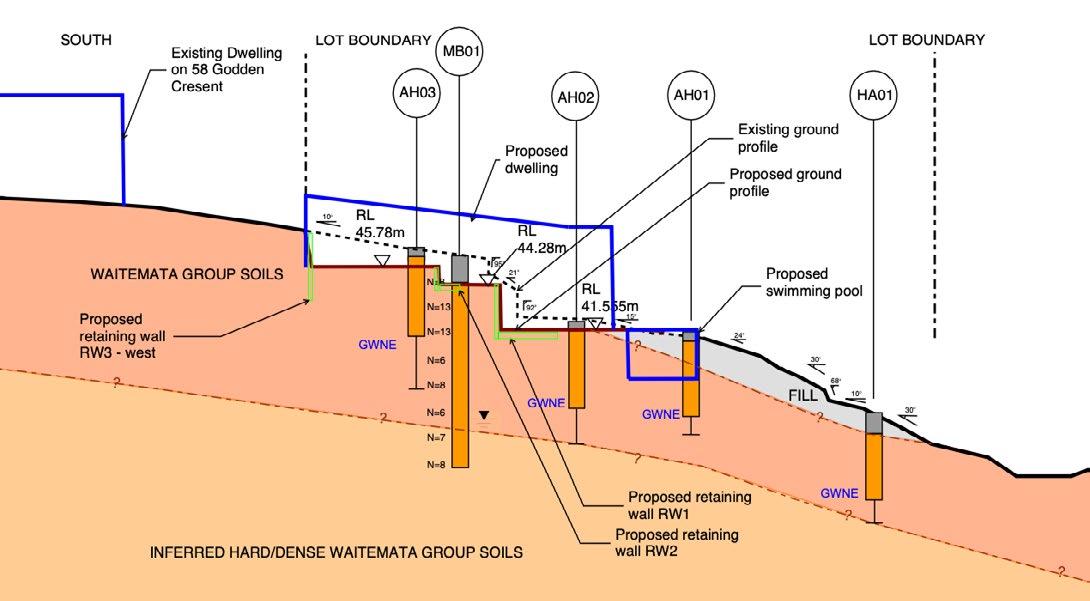
Fortunately, there were no big surprises here (such as contaminated asbestos fill) - and the only unanticipated expense, driven by the weather, has been to stabilise the large four-metre bank with sprayed concrete to reduce the risk of slips caused by rain until the final block wall can be constructed.
Preparing the footings properly is, of course, crucial. We certainly don’t want this house to slide down a hill. Below the ground-
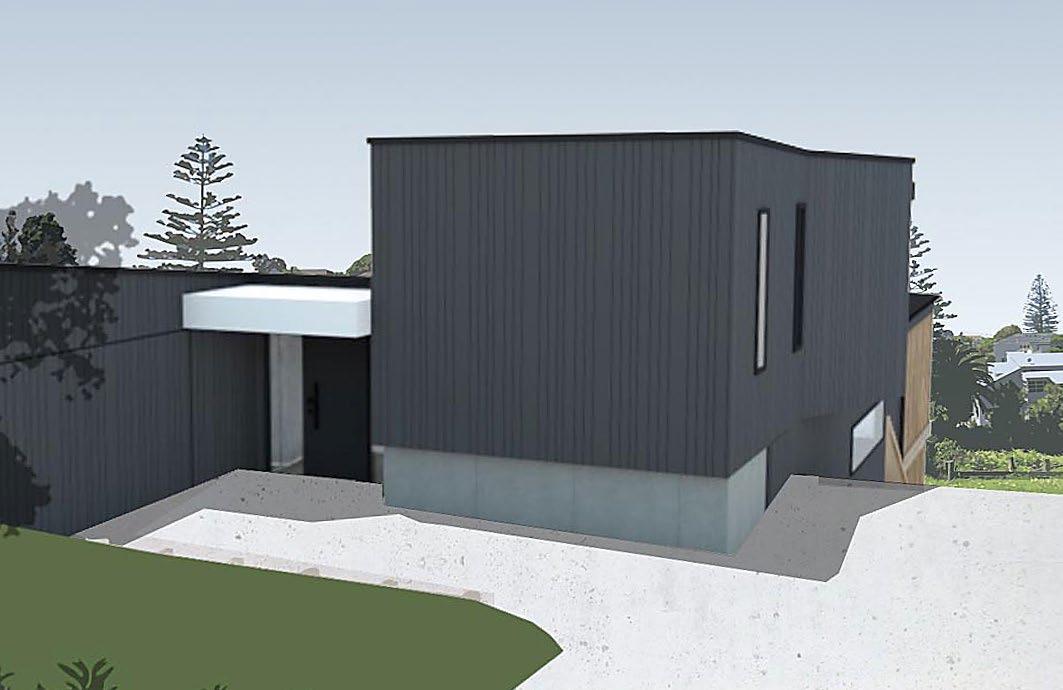 ABOVE Views from the bottom of the site looking back up, and top to bottom. BELOW The intricacies of foundation engineering on sloping sites.
ABOVE Views from the bottom of the site looking back up, and top to bottom. BELOW The intricacies of foundation engineering on sloping sites.
floor slab that can be seen in the photos is a huge amount of steel reinforcing, and a number of concrete cylinders that go down four metres. What can currently be seen on the slab are two rectangular recesses - one to the west, another to the east – which are for the showers along with pipework for the in-slab plumbing, be it a shower, a sink or a loo. By the end of April, when the ground-floor foundation was laid, we moved on to building the concrete-block walls for the downstairs zone. They are reinforced with steel bar and the area behind them will be backfilled so that, when the house is finished, the retaining wall will not be seen.
Communication with neighbours, who were pleased that the section had not been bought by developers, with the clients (who enjoyed fortnightly catch ups to understand our progress) and
01 If there’s one thing Box has learned over the past 15 years in business, it’s this: siteworks (including earthworks and foundations) can significantly increase building costs.
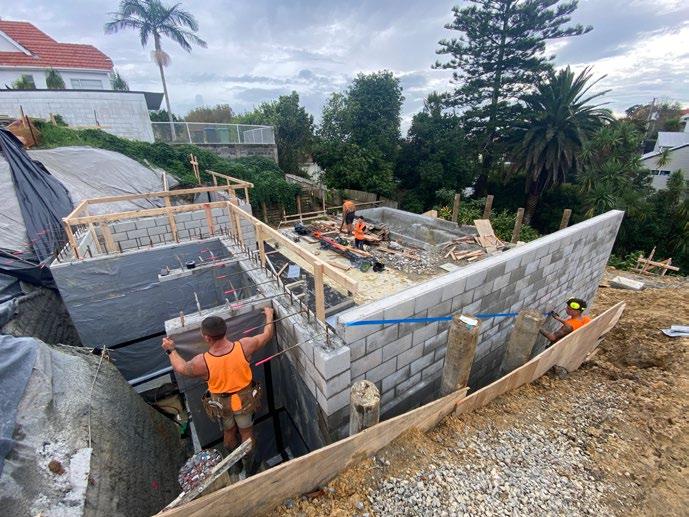
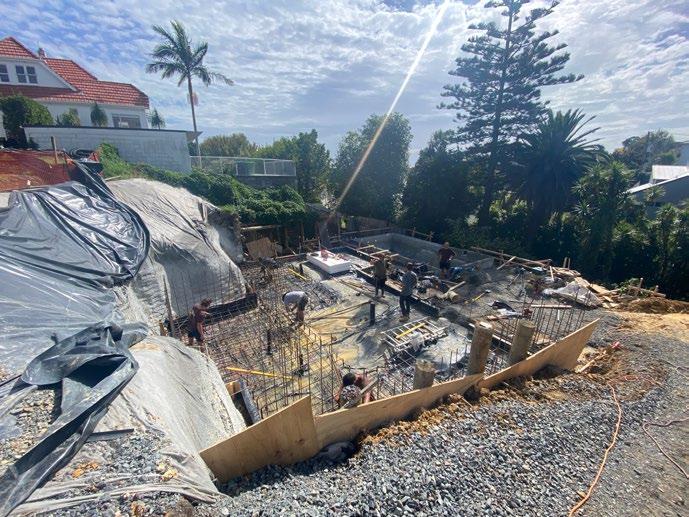
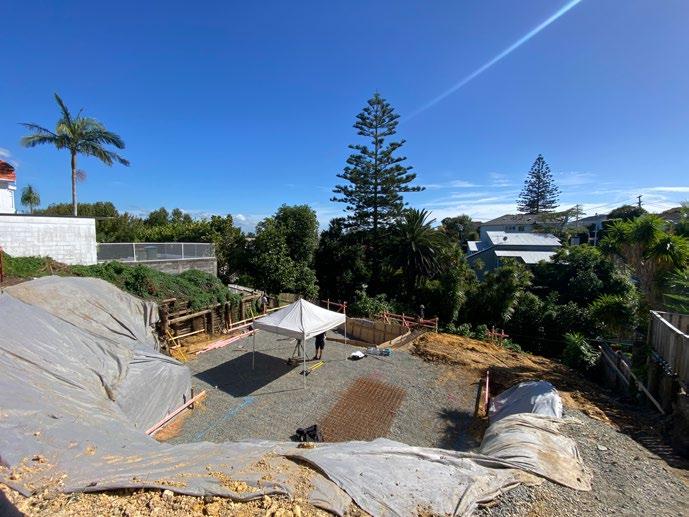

02 The site cut and pile installation involved a fair bit of consultation. During the design stage, the geotechnical crew used augers to test ground conditions at various positions on the site. Their report indicated the depth .of topsoil, of fill, clay and finally dense, stable ground.
03 Preparing the footings is, of course, crucial. Below the ground-floor slab is a huge amount of steel reinforcing, and a number of concrete cylinders that go down four metres.
04 By the end of April, when the groundfloor foundation was laid, Box™ moved on to building the concreteblock walls for the downstairs zone. They are reinforced with steel bar and the area behind them will be backfilled so that, when the house is finished, the retaining wall will not be see.
between members of the Box™ team is a key part of the projectmanagement role. The true value of having regular on-site catch ups between the design-and-build team is that we can spot opportunities to tweak the plans. We aren’t just blindly following a set of instructions from a third party.
One example of this was in the bathroom on the western elevation which was initially designed with a full-height block wall, with no windows. On site, it became apparent that even though this room was somewhat subterranean, we could nevertheless replace the block with a timber-framed wall – and the potential to add a window. After a discussion about costs, Lara and Terence decided to go for it. All in a day's work. Putting our heads together to achieve the best outcomes for clients is how we roll.
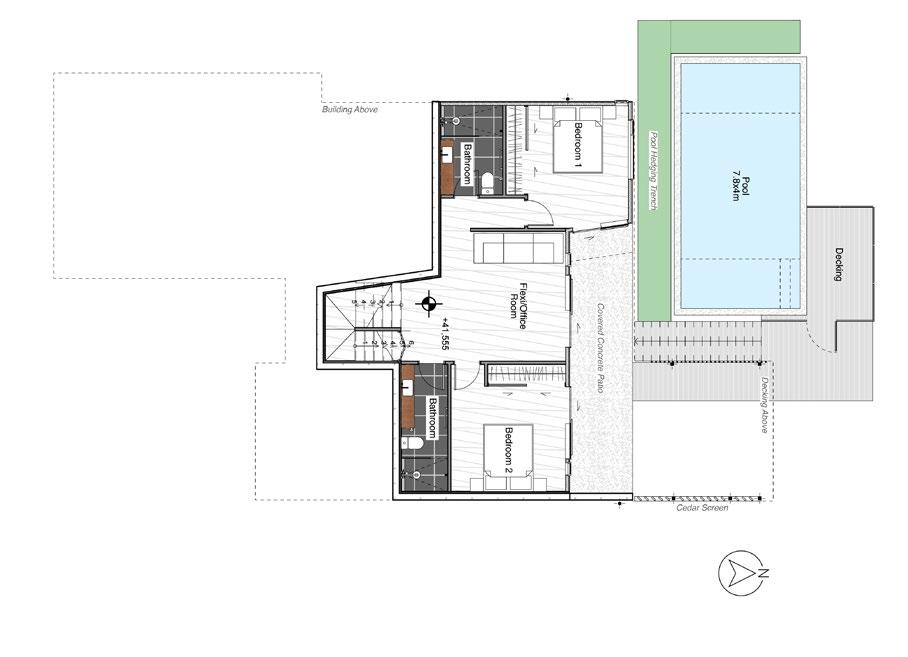


This long, skinny site at Muriwai had a few issues even before Cyclone Gabrielle ravaged the district.
From the road, it drops off seven metres to the natural building platform. A stream runs through the middle of it (effectively bisecting it) and to the front of the 83-metre-long section, a rocky cliff faces the sea. To even build here in this coastal hazard zone requires resource consent and plenty of determination.
Still, the young couple with three children between them aged 5, 8 and 10, had identified Muriwai as their paradise. They had been renting in the area and loved the relaxed outdoorsy vibe. Surfing on the doorstep? Yes please.
They were realistic about the development potential of the 1200-square-metre section where Pohutukawa bloom and the waves at Maukatia Bay pound the headland. Due to the generous setbacks required and the need to dedicate almost half the area to a wastewater field and tanks, the options became more constrained. No worries. With a limited budget, they envisioned a small home anyhow, with ample decking to embrace the carefree lifestyle. And, as luck would have it, the part of the site that could accommodate the dwelling, boasts an unencumbered view out to sea.
The key move within this simple, rectangular plan is to pull it apart and insert a covered deck in the middle. To the north-west are the living areas and the main suite, while across the decking to the north-east are two more bedrooms for the children. This way, the adults have their own sanctuary, removed from the hubbub at the furthest end of the home – a master suite with a grand-stand view of the trees.
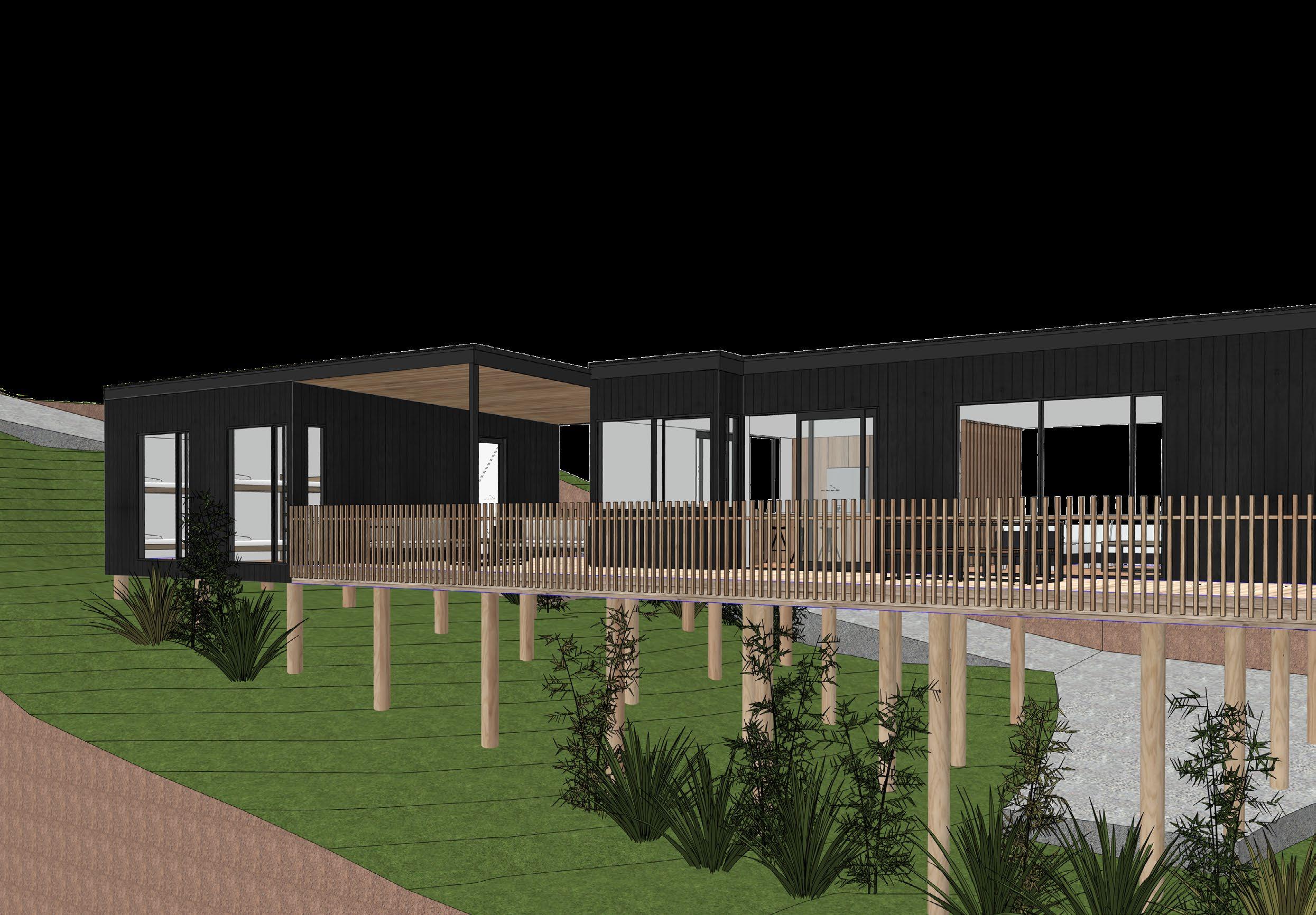
At 113-square metres, the building is by no means large, but it is tightly planned. The dining and kitchen area have immediate access to two decks (one covered, the other a wraparound that extends the alfresco action) and grab the lion’s share of the sun. The children’s bedrooms, which will be fitted out with bunks so the youngest two can share, are 3m x 3m – enough for a queen-sized bed, a built-in wardrobe and a desk for homework. In their zone, the shower and toilet are separate, rather like in a campsite where many people need to use the facilities, and a stand-alone laundry nearby means they don’t have to walk far to put their clothes in the washing basket!
The owners love to cook and family time around the table is important, so a built-in 50s-style dining booth was created to save valuable space. A pantry was also on their wish-list and an extra square metre was eked out for kitchen storage which pops out on the southern elevation, breaking the line of the rectangle. To the south too, a parking area will be created so the active couple can drive right up to the house. They agreed that a garage was not a necessity but, since the home will be built well off the ground, there may be the opportunity to drive under it. In the meantime, this elevated design will provide under-floor storage for all the toys, the surfboards and beach paraphernalia the family will, no doubt one day get good use out of.

LEFT Relaxed and practical entrance onto a covered entry deck.
BELOW Expansive deck stretching over a natural overland flow path.

RIGHT From drawing-board concept to developed design.
CONCEPT PLAN
ARCHITECTURAL PLAN

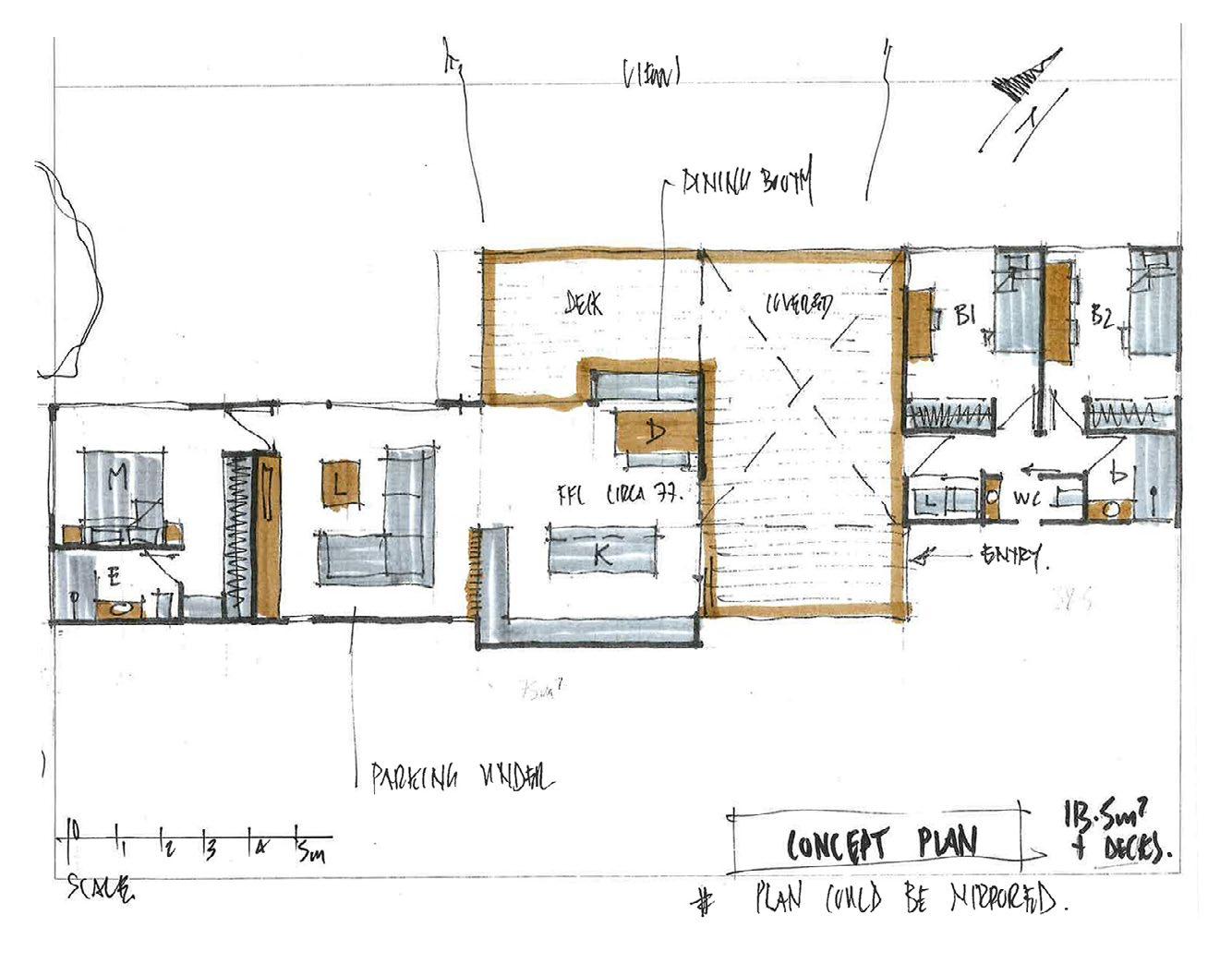
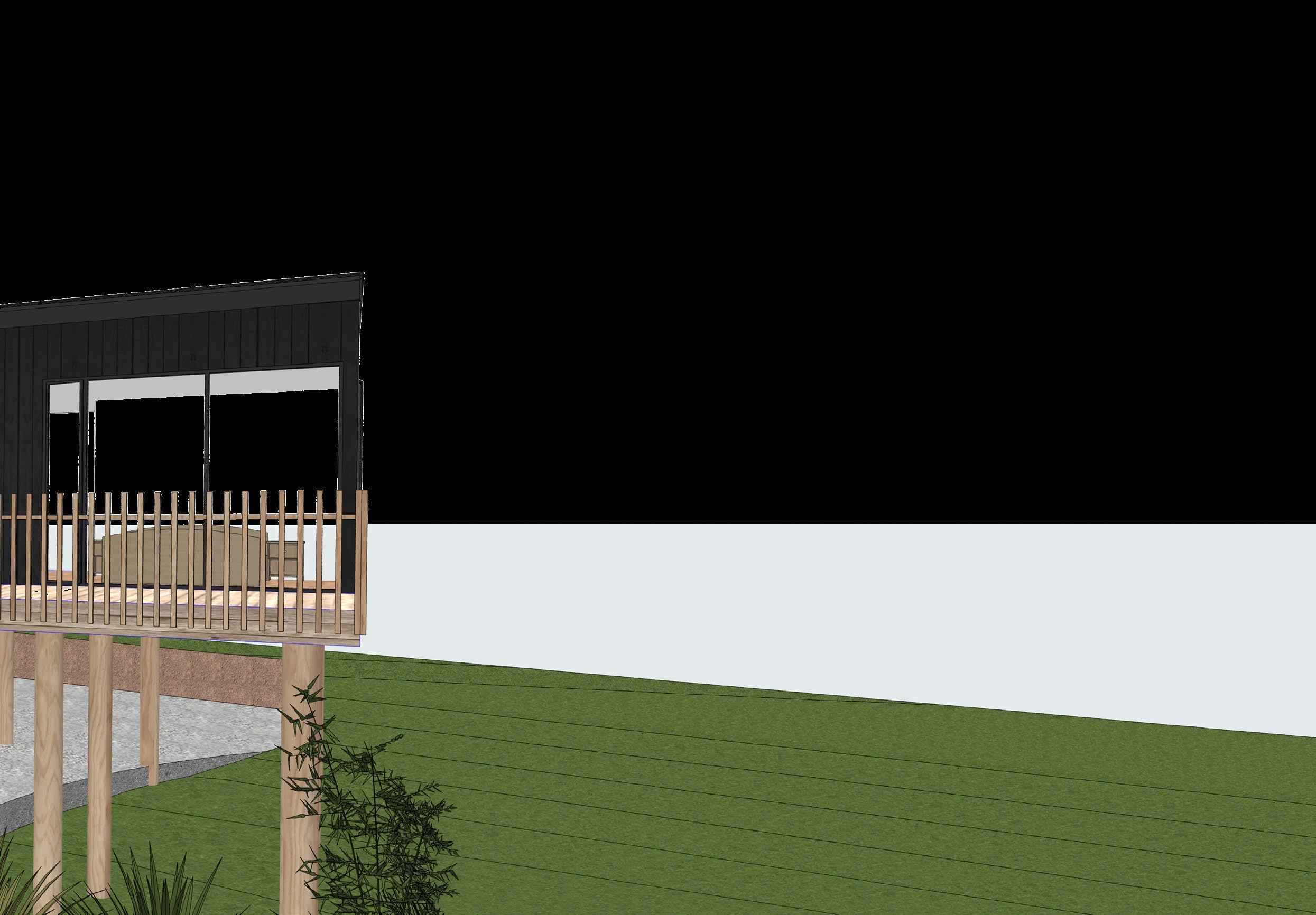 FRONT PROJECTION
FRONT PROJECTION


"Tell us a bit about the relationship, how long have you worked with the Box™ team?
Nat:
"Box™ has worked with CARTERS in some capacity since we began in 2009. Our CEO Stu was a regional manager for CARTERS, so the relationship has roots! We’ve had a great client rep and team that has been with CARTERS for many years so the consistency there has been great.
Any particular products you use and are really keen on at the moment?
One thing we’ve been looking into quite a bit is having larger components, like floor cassettes manufactured by CARTERS and then lifted into place on site. We trialled this a couple of years ago on a small project in Te Atatu. CARTERS manufactured the floor cassettes and lifted them into place on Day 1. Frames were up on Day 2 and on Day 3 we had the roof framing up ready for measure! It all went together seamlessly and is a methodology we’re looking to use a lot more on our projects that use a timber sub-floor.
What has been the key to developing a good relationship?
Communication. Building is a tricky business in that everyone is trying to coordinate different elements, some (for example, weather!) Which are beyond anyone’s control. The ability to work with our CARTERS rep and the broader team has been really important to make sure that materials and components get delivered
on time in order to keep the flow of work progressing. And when there is a hiccup, the ability to contact someone directly for an answer, or to receive timely notification has been priceless.
How has CARTERS made your life easy?
Box™ is working on a new way to deliver more affordable houses which still retain architectural input. This project called ‘Artis’ has required us to work with the CARTERS procurement team to understand the pros and cons of using various materials and also how to procure them in order to reduce costs. This includes understanding minimum order quantities and also product sizing for optimum cost efficiency. A long-term supply partner really helps us with this kind of project work.
How do you see the relationship moving forward - what can CARTERS do to make your life easier?"
As with any key supplier, a tighter integration of systems is the holy grailthe ability to have instant price updates and product availability would be useful especially when it comes to estimating jobs. But ultimately it’s all about people. So far the team that works with Box™ has been really passionate about the relationship, and that’s all we can ask for really - that these people make us feel as though we are the only company that matters!"
To learn more please visit: carters.co.nz
Awards
2023
NZ House Of The Year Awards
New Home $1 million - $1.5 million (CHEL) Gold
Trends International Design Awards
Designer Bathroom of the Year (SAND) Highly Commended
Designer Kitchen of the Year (NORF) Highly Commended
2021
Trends International Design Awards
Designer Homes (DRYD) Highly Commended
2020
Trends International Design Awards
Building Designer New Home (RAKO) Winner
Building Designer New Home (BEA2) Highly Commended
2019
NZ House Of The Year Awards
New Home (LARA) Gold
New Home (PATA) Gold
Renovation (PROS) Gold
Trends International Design Awards
Architect Designed Kitchen of the Year (LARA) Silver
2018
NZ House Of The Year Awards
New Home $450,000 - $550,000 (TEAH) Gold
New Home $1 million - $2 million (FAUL) Silver
New Home $700,000 - $1 million (RAME) Gold
2017
NZ Wood Design Awards
Residential Architectural Excellence (PAK2) Highly Commended
2016
NZ Architecture Awards
Housing - Multi Unit (Sussex Mews) Multi-Unit
Designers Institute Of NZ Awards (BEST)
New Home (Kawaka Street) Silver
Trends International Design Awards
Architect Designed New Home Silver
Architect Designed Renovation Silver
Architect Designed Kitchen of the Year Silver
2015
New Zealand House And Garden
Interior of the Year Award – Kitchen Finalist
Designers Institute Of NZ Awards (BEST)
Offices and Workplaces Silver
Trends International Design Awards
Architect Designed Kitchen of the Year Silver
2012
New Zealand Business Awards
0800 717 717 box.co.nz
Emerging Small And Medium Business Award
2009
NZ Wood Design Awards
Residential Engineering Excellence Highly Commended
“ They have a sweet spot. There aren’t many doing what they do, being an Architect, Builder and service provider all in one”
“ One of the things about Box™ I found attractive was the single entity – the architect builder is an attractive concept. They manage all aspects of the build, rather than having a patchwork of suppliers that we have to manage”

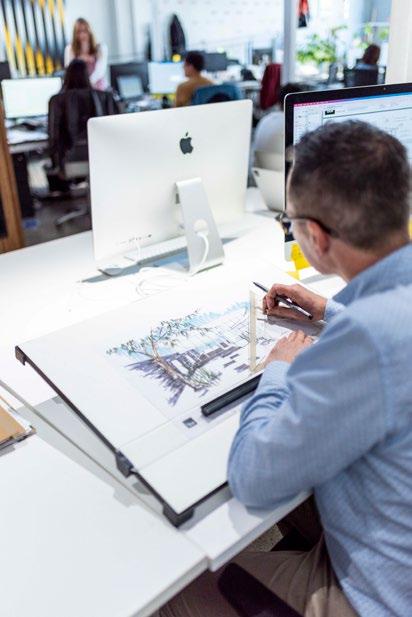


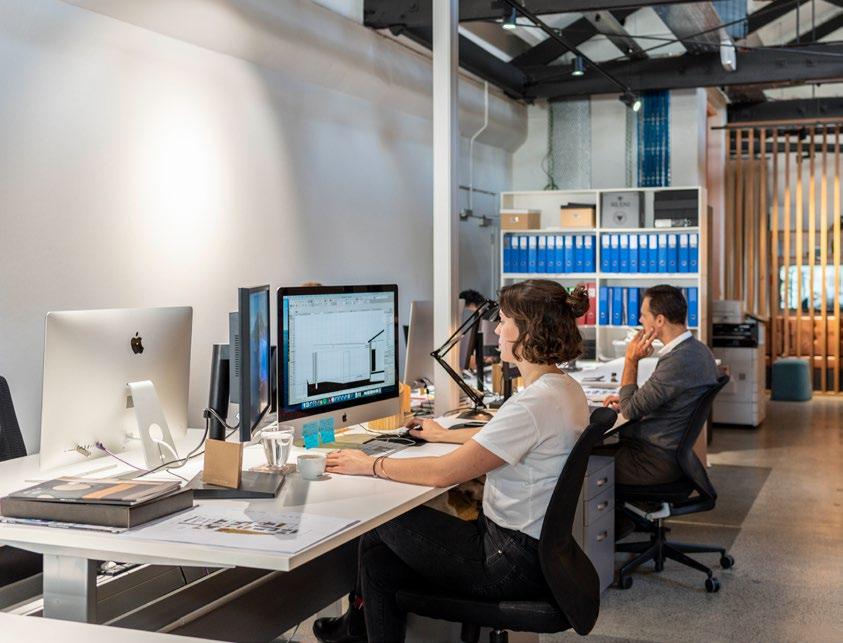
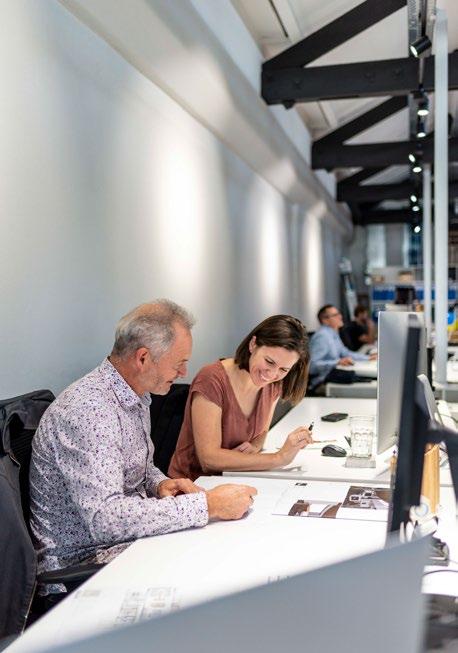

“ Their office was great, everyone was friendly, it was just a nice vibe”
“ It I have to get an Architect, get a Builder, plus all of the others, that is going to put me at the higher end than I get with Box™ ”
“ They are always available for a meeting, their communications are great”
“ I watched the neighbours build with Box™. They encouraged us to consider Box™ because it worked very well for them”

“ They have 3D images to help imagine the design, to be able to go into each room and look around. The finished product looked good”
“ We went with Box™ because of their more certain cost estimates”
